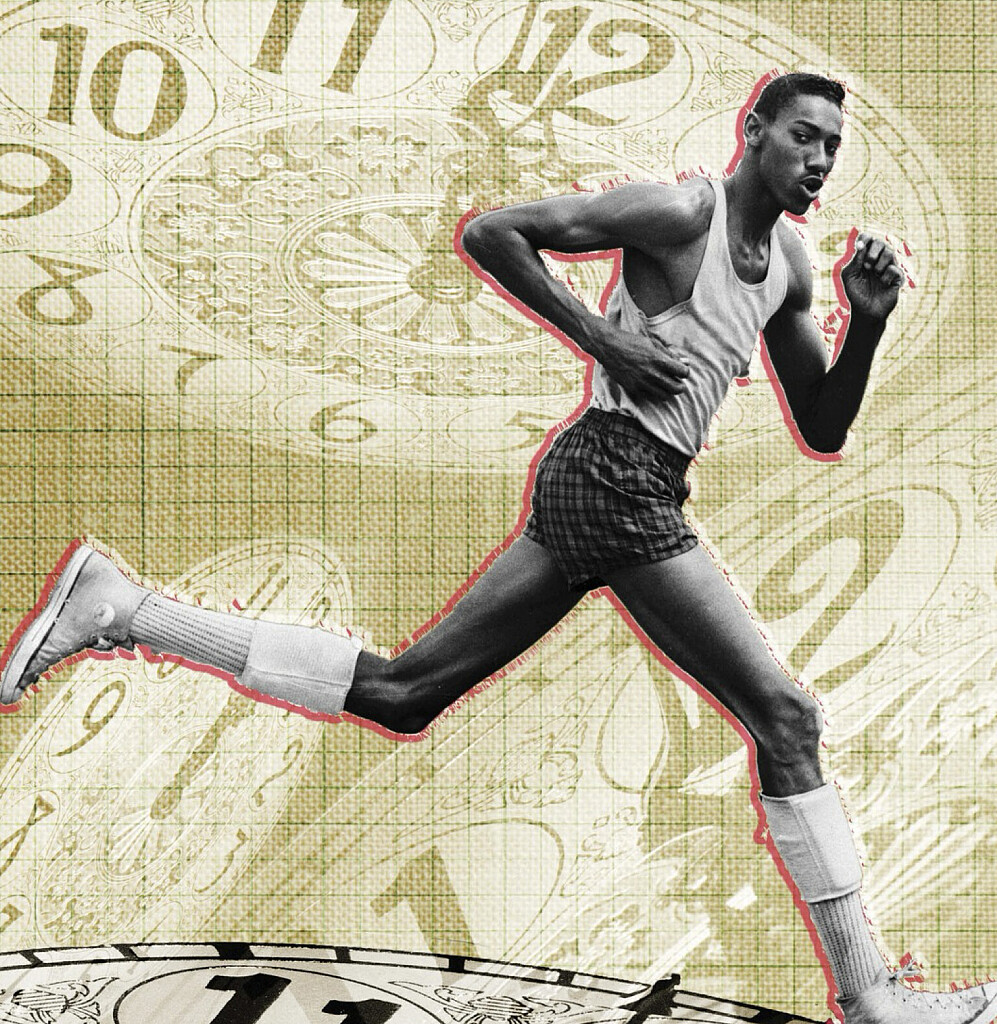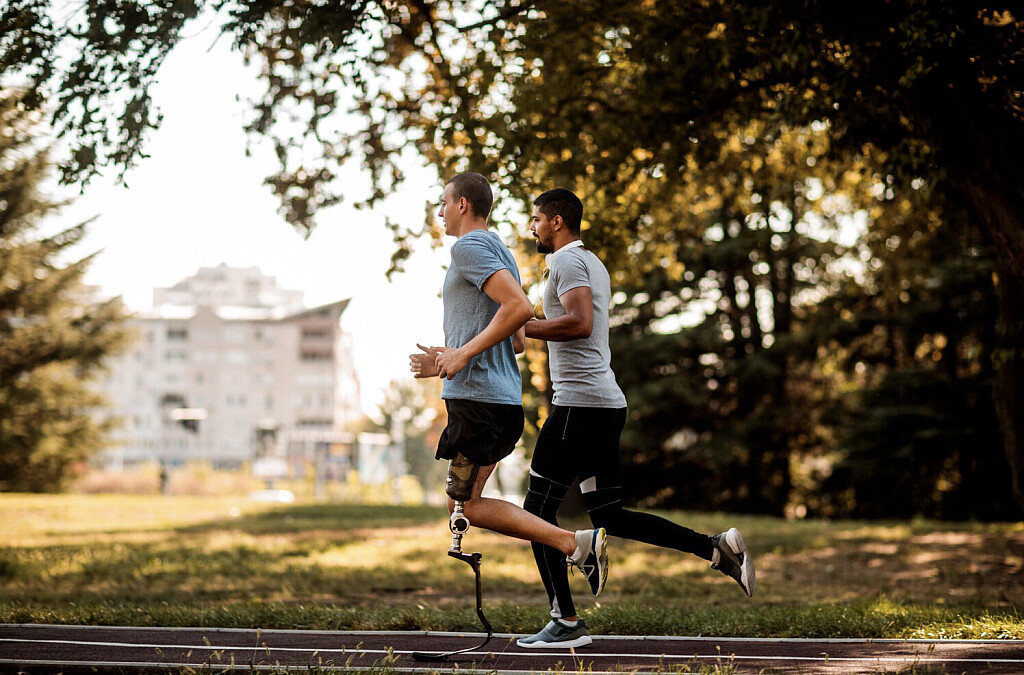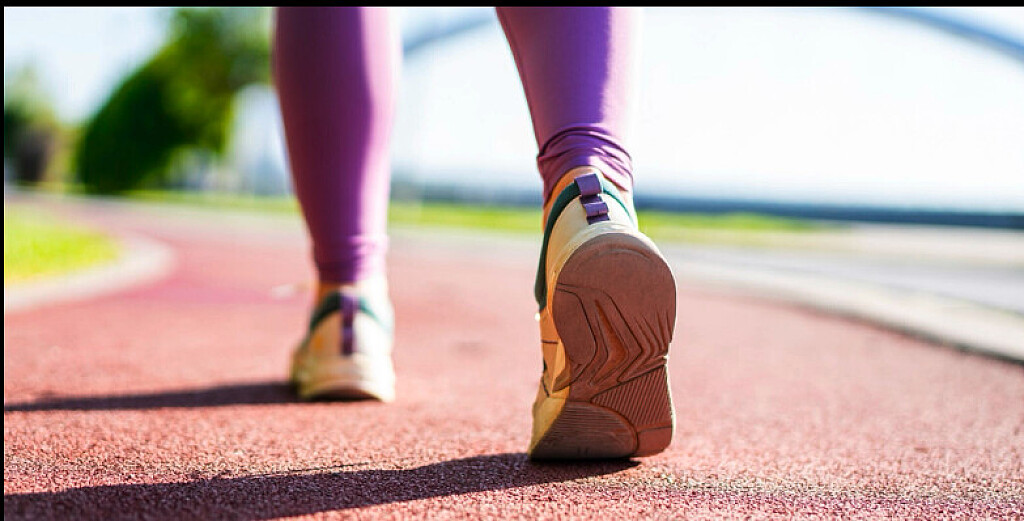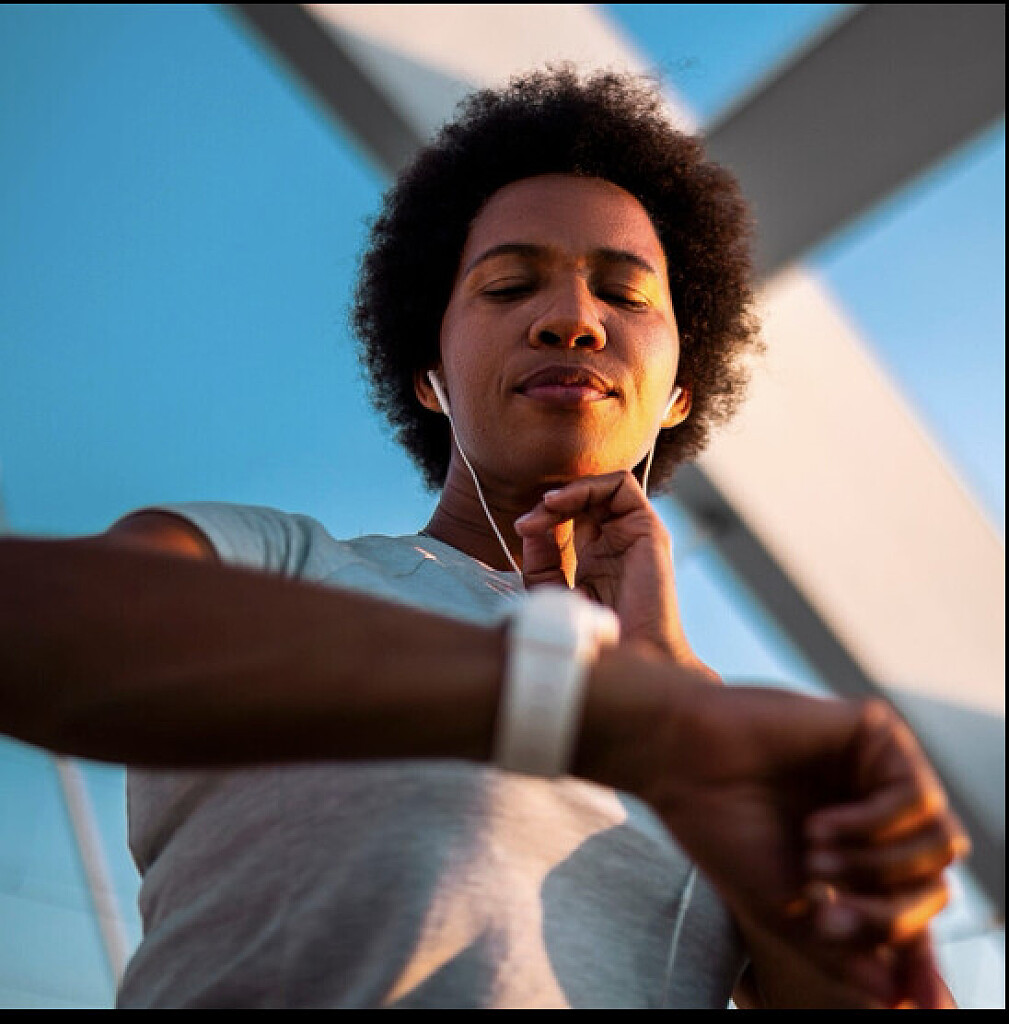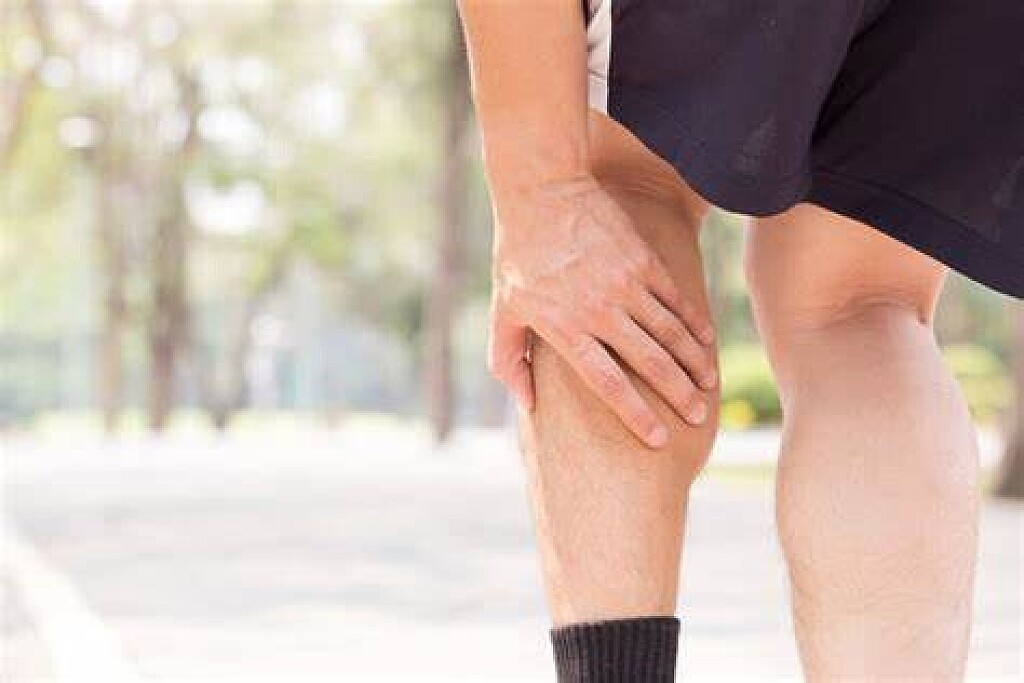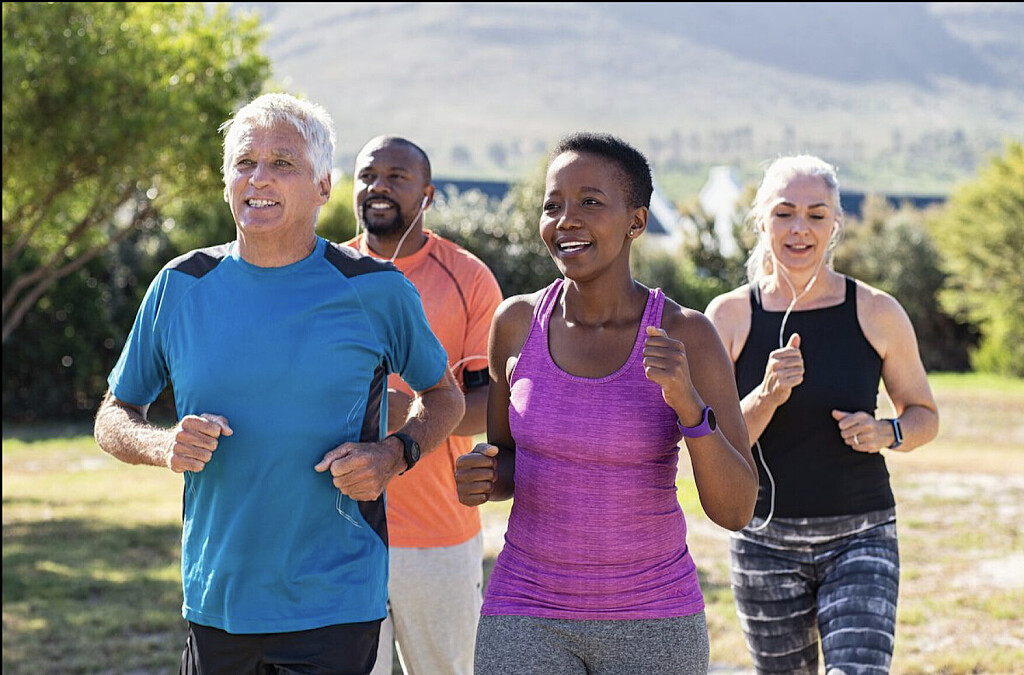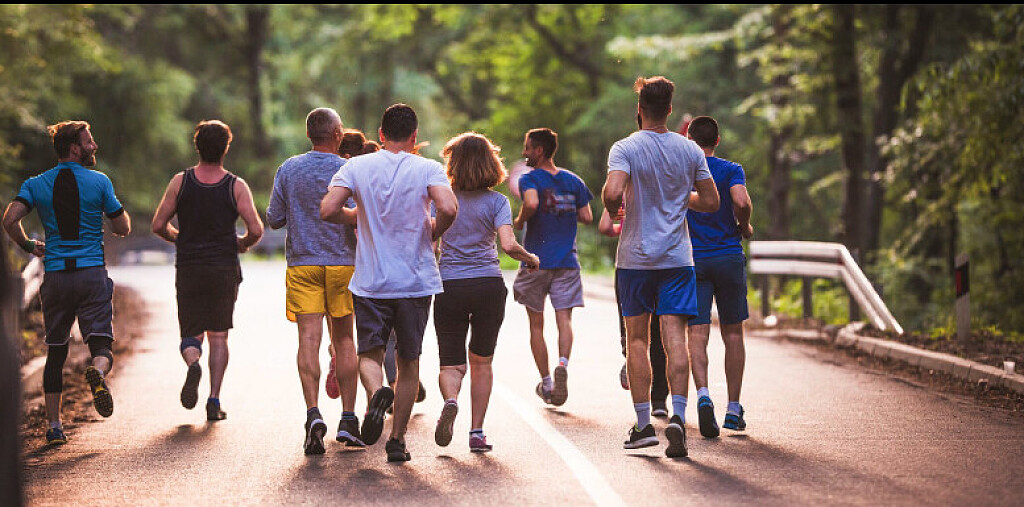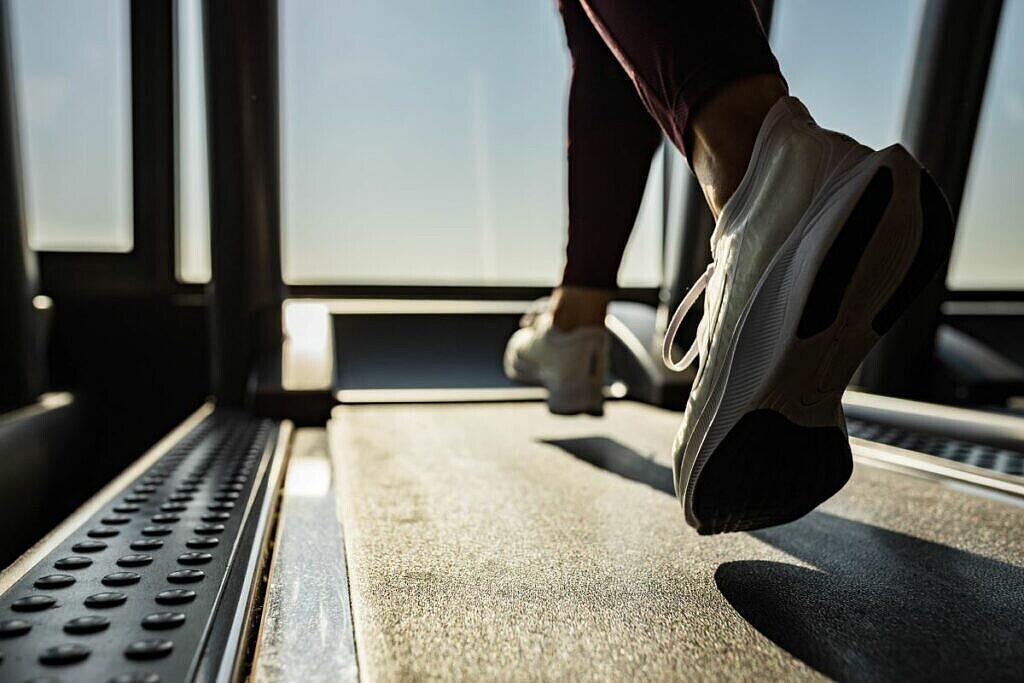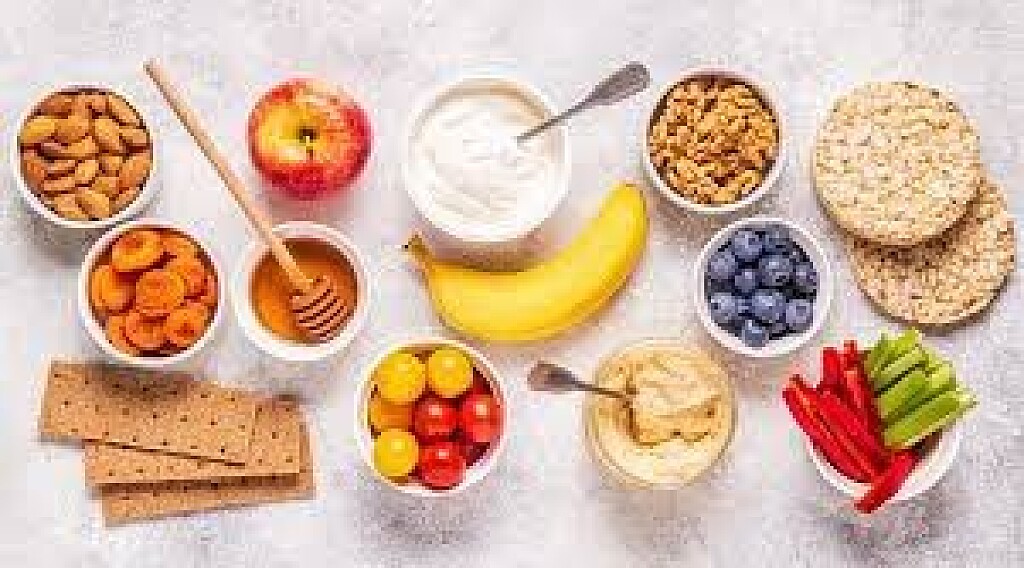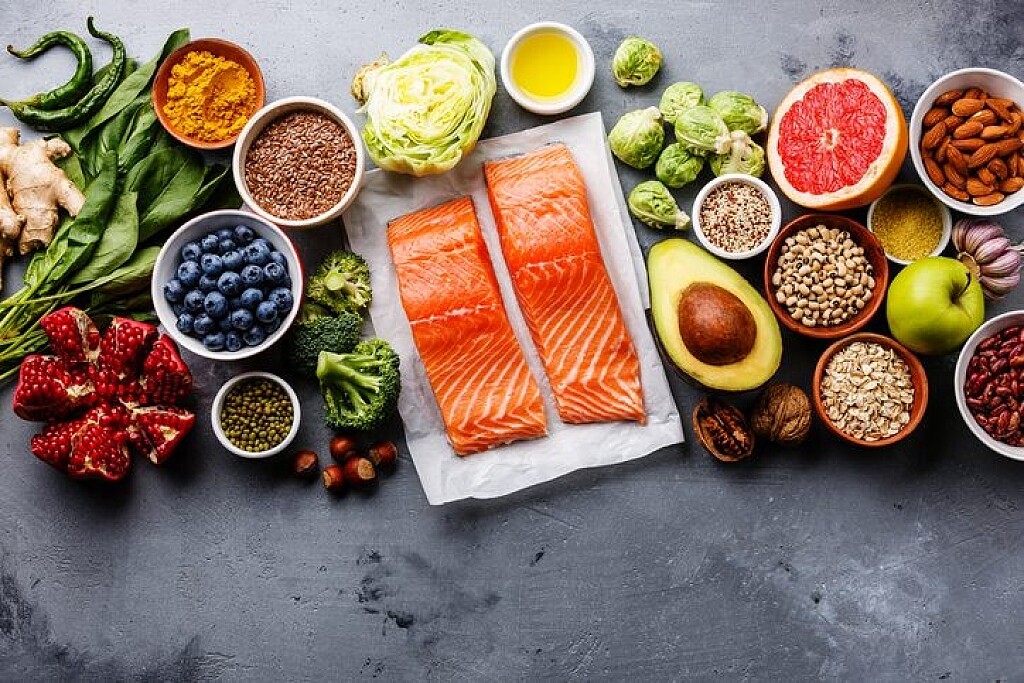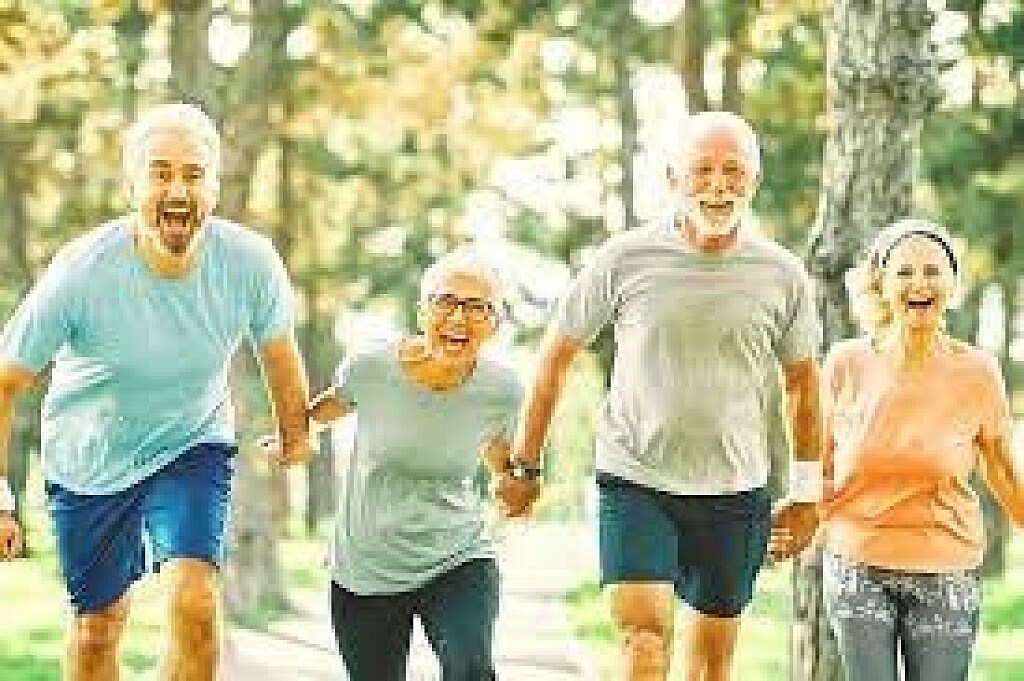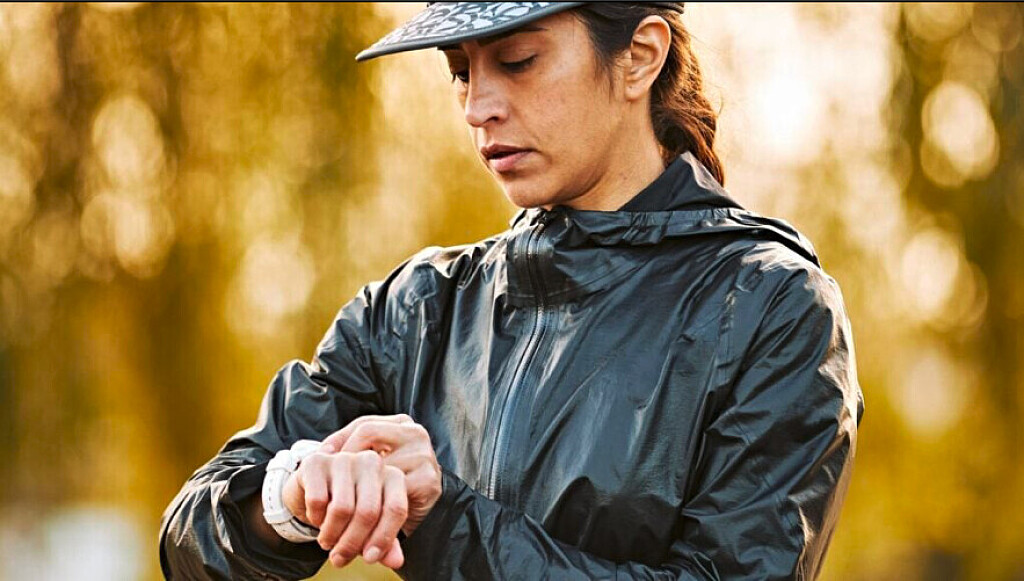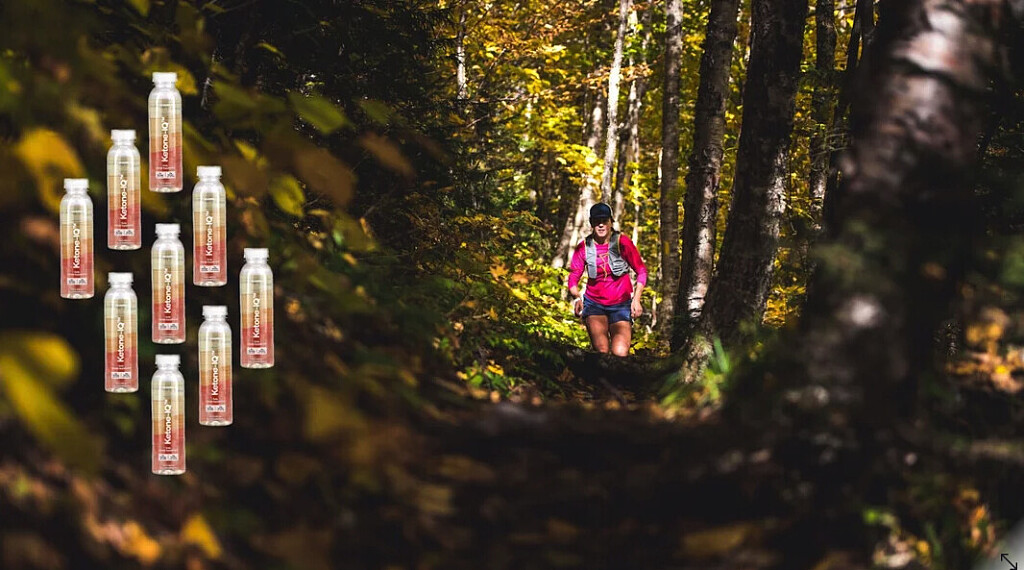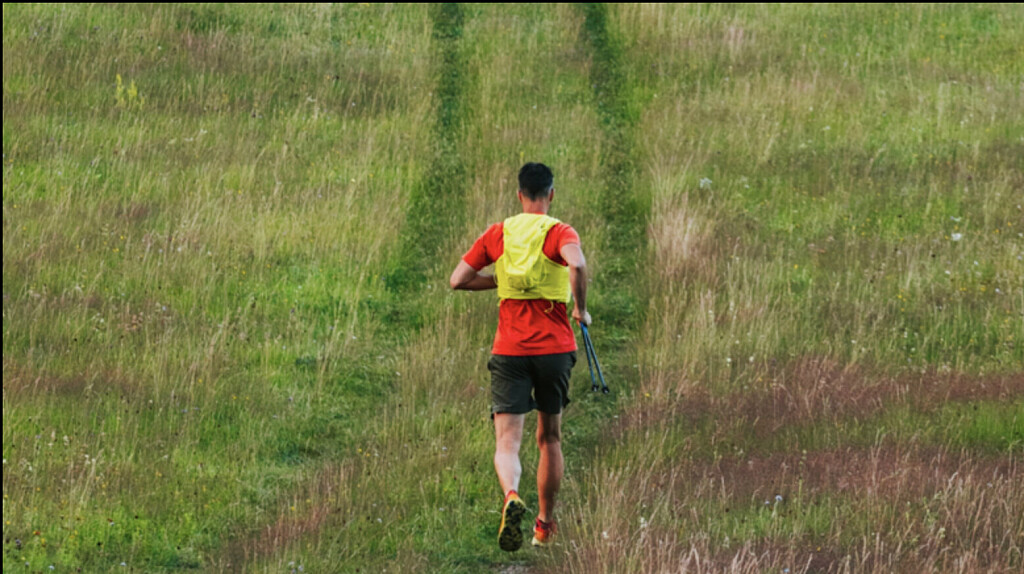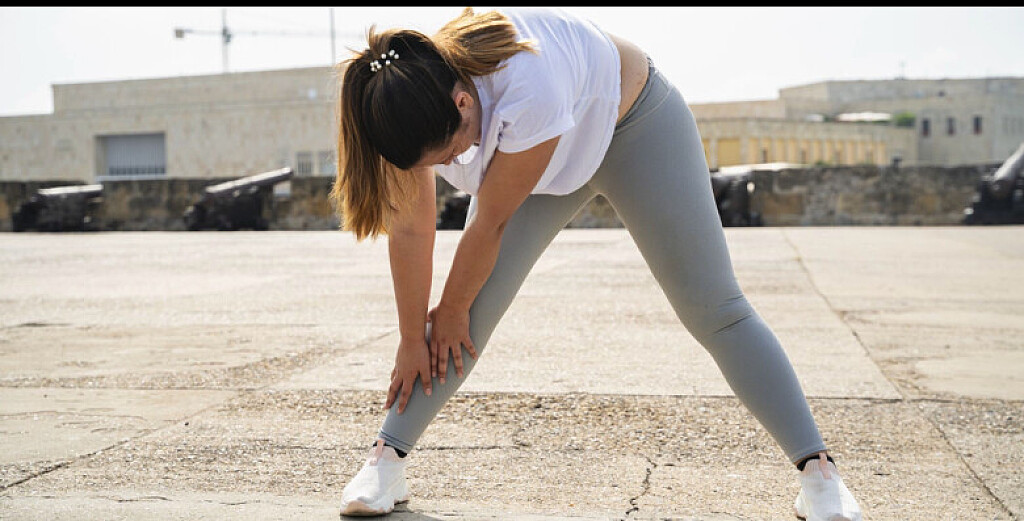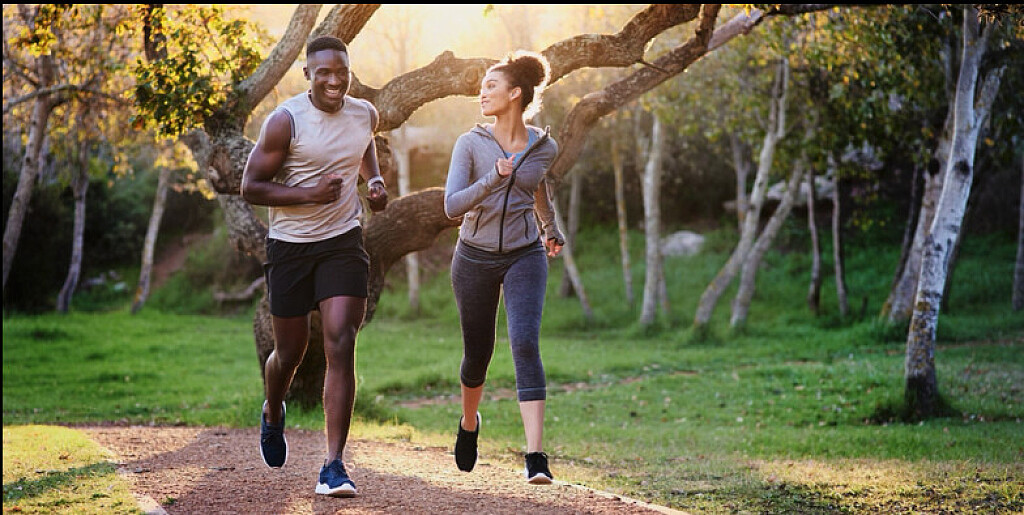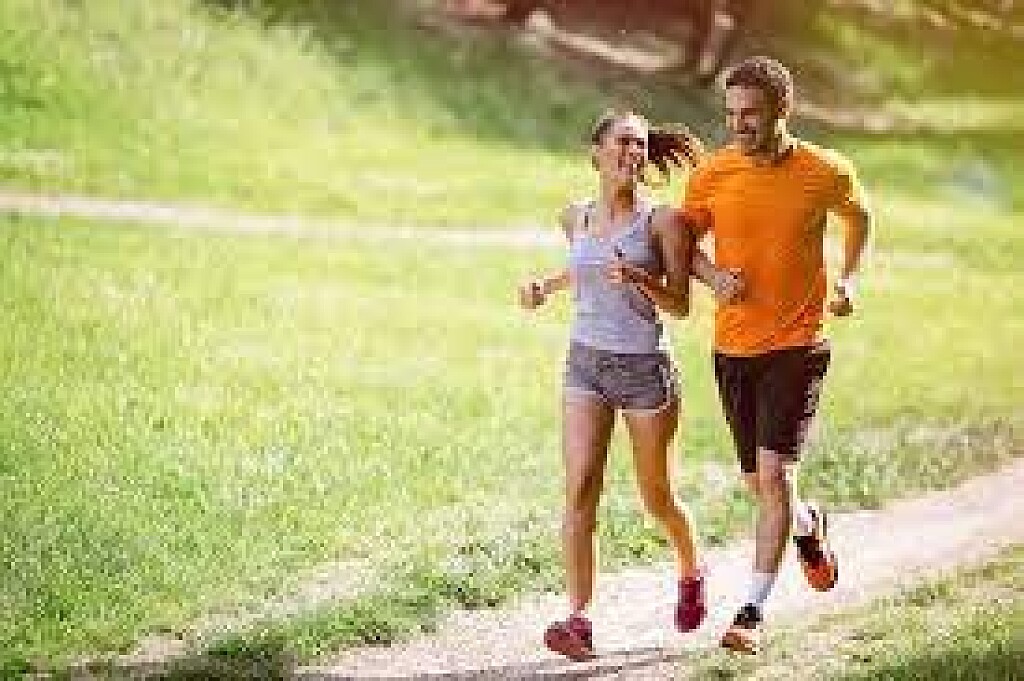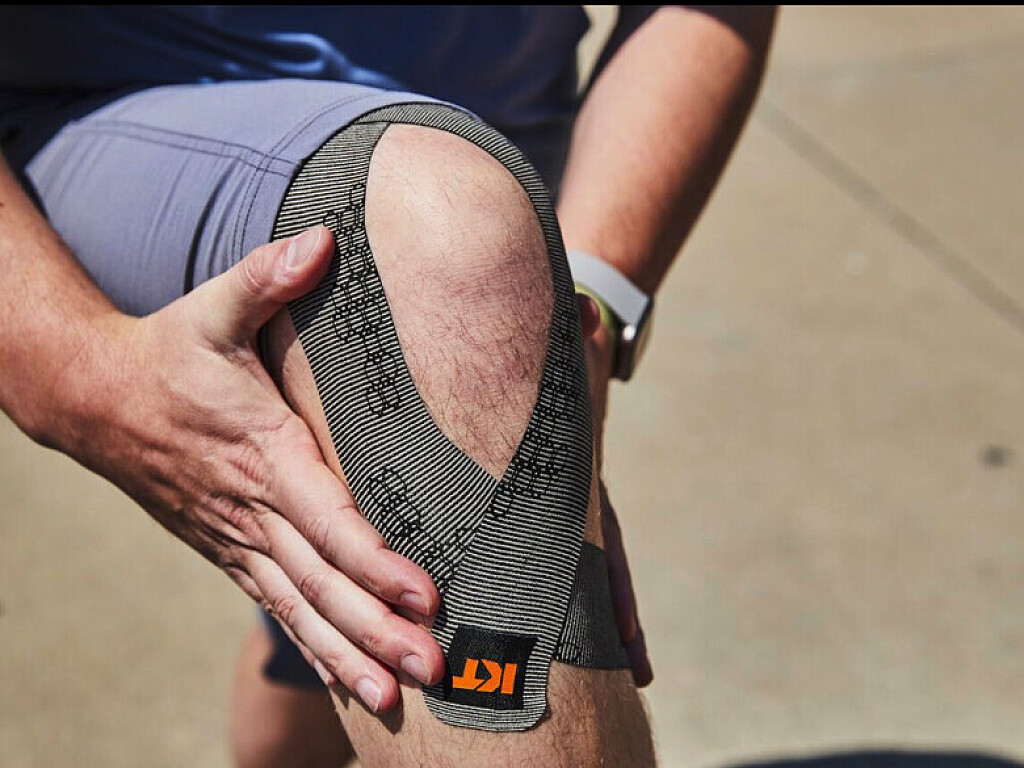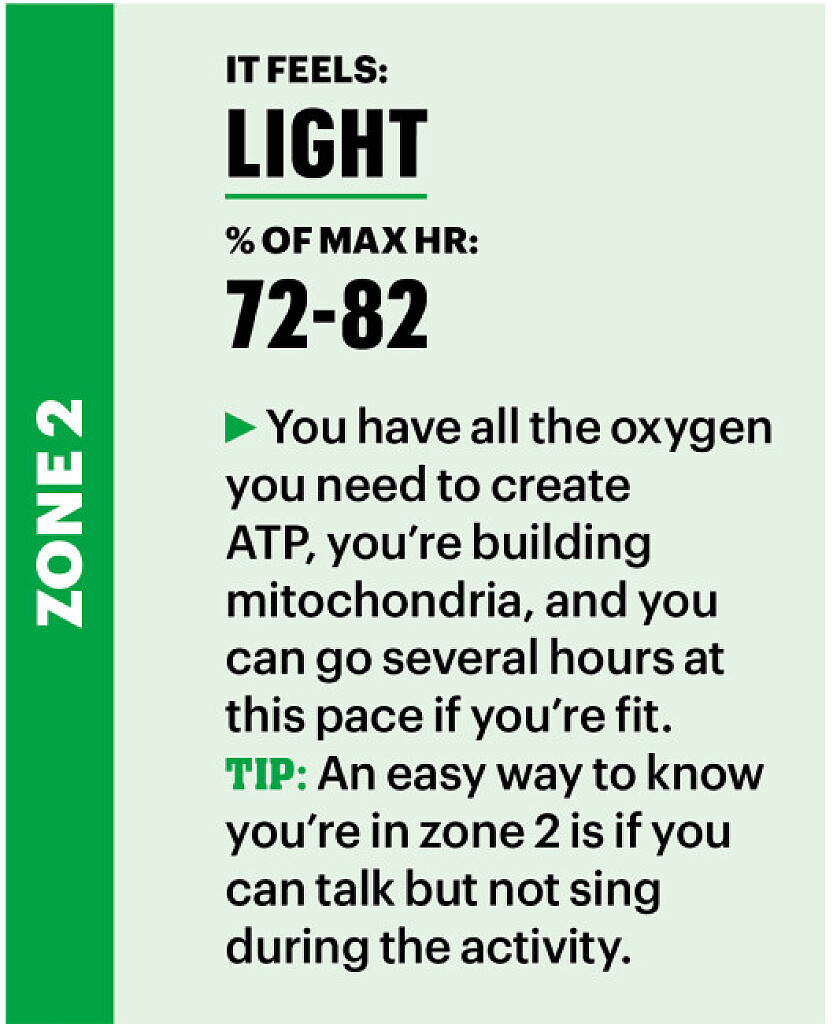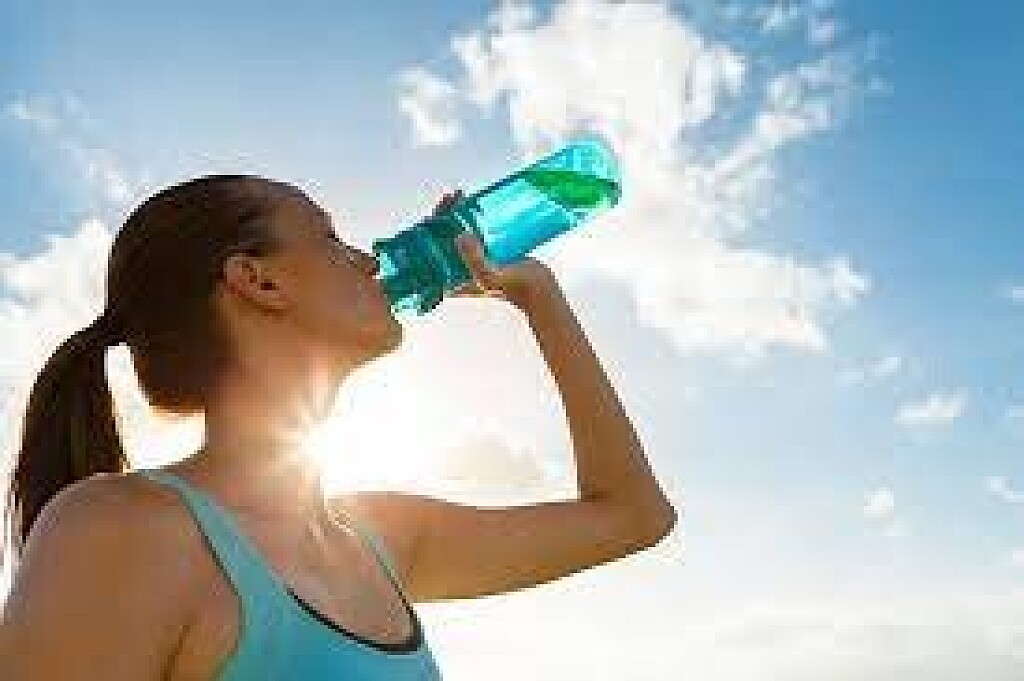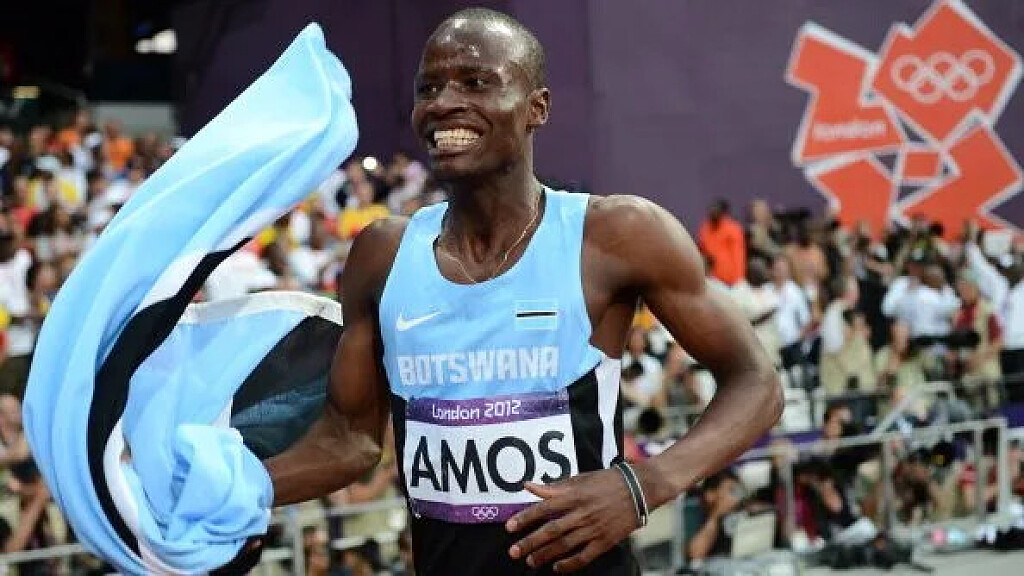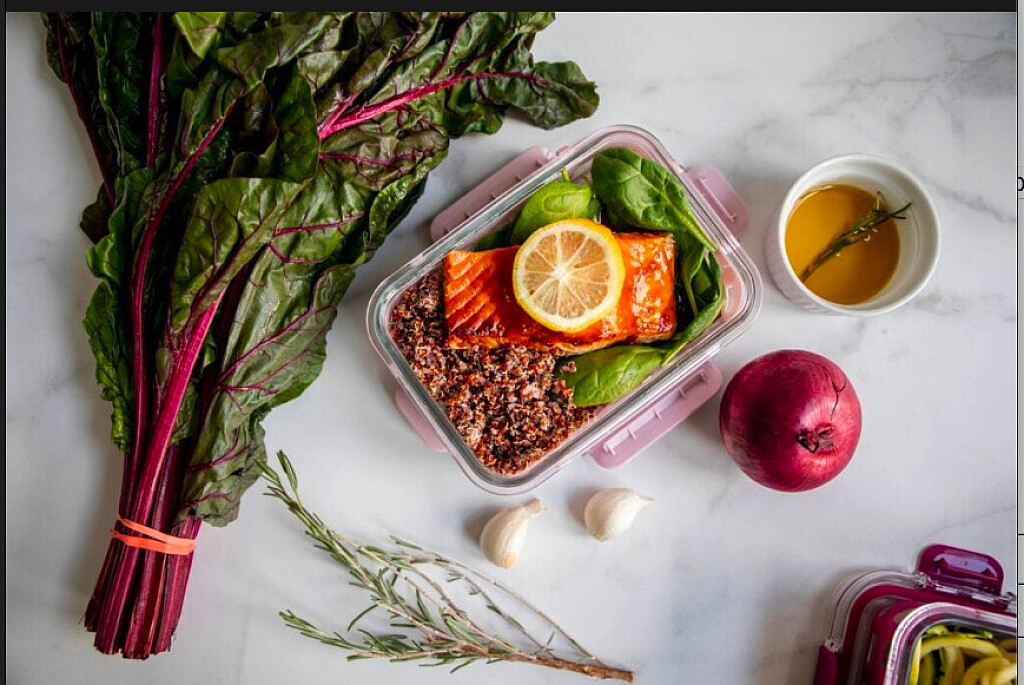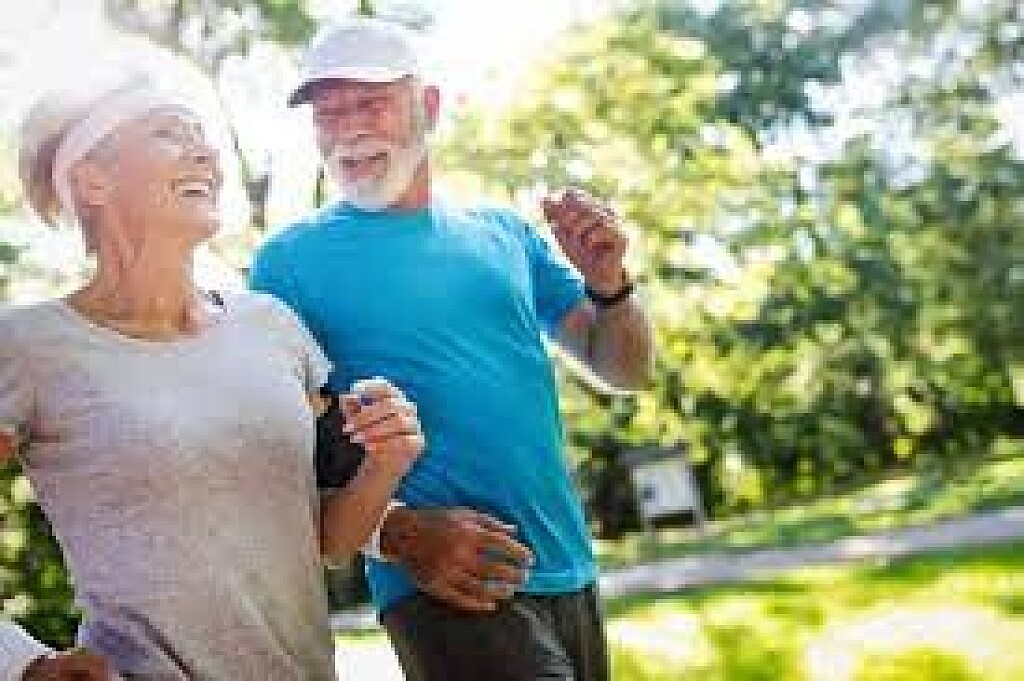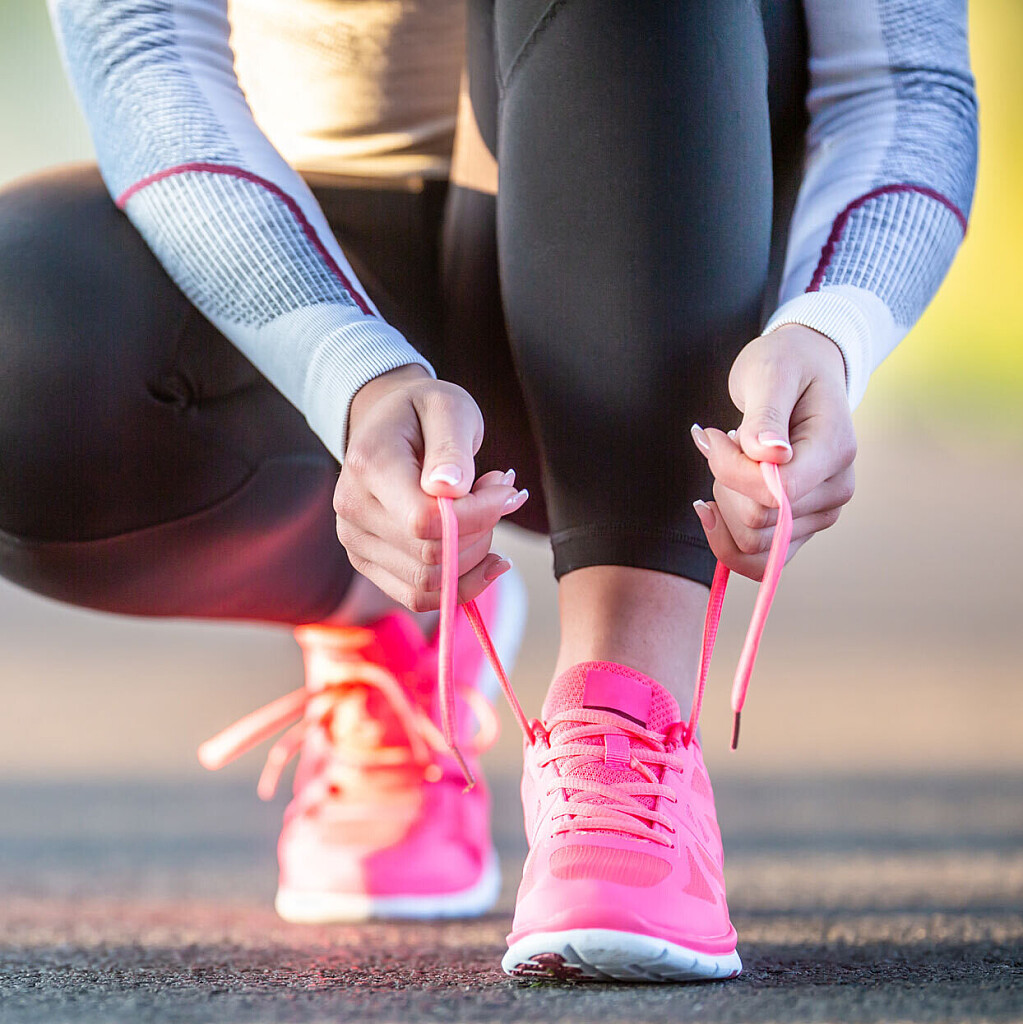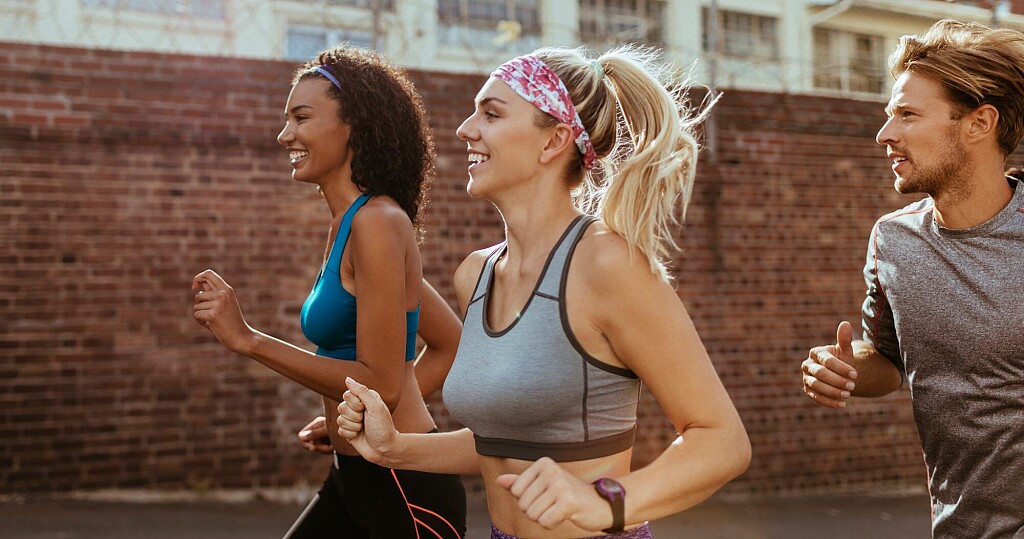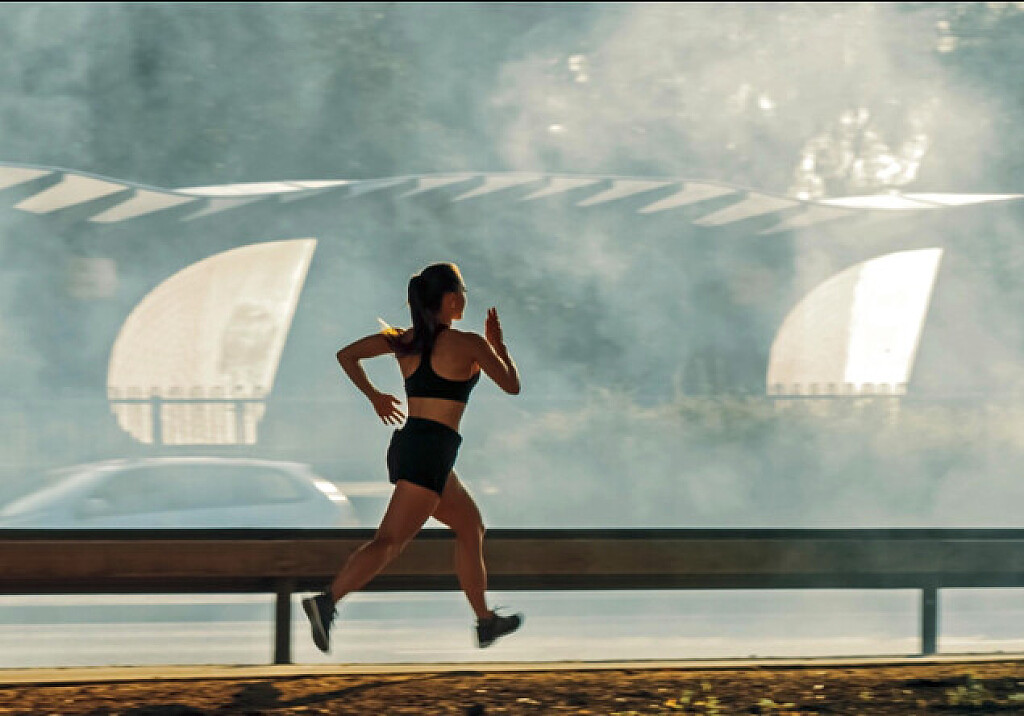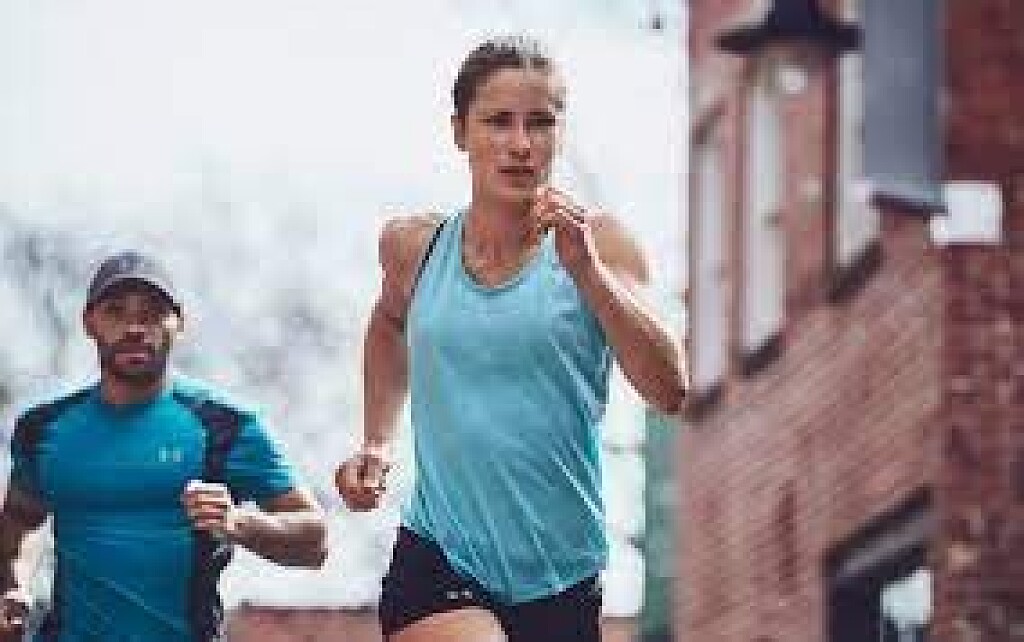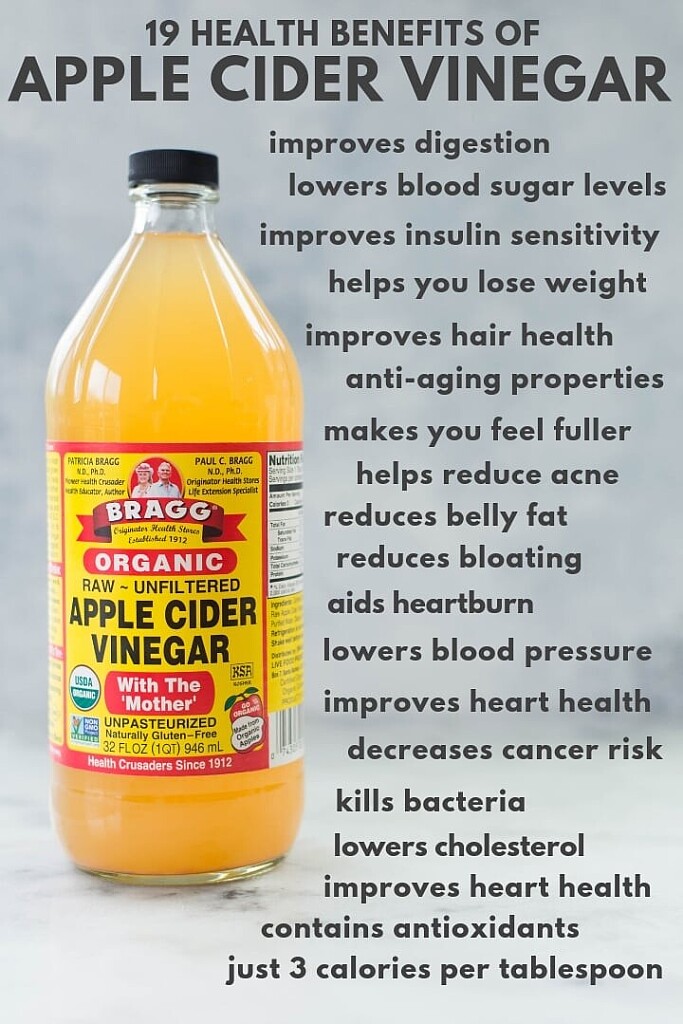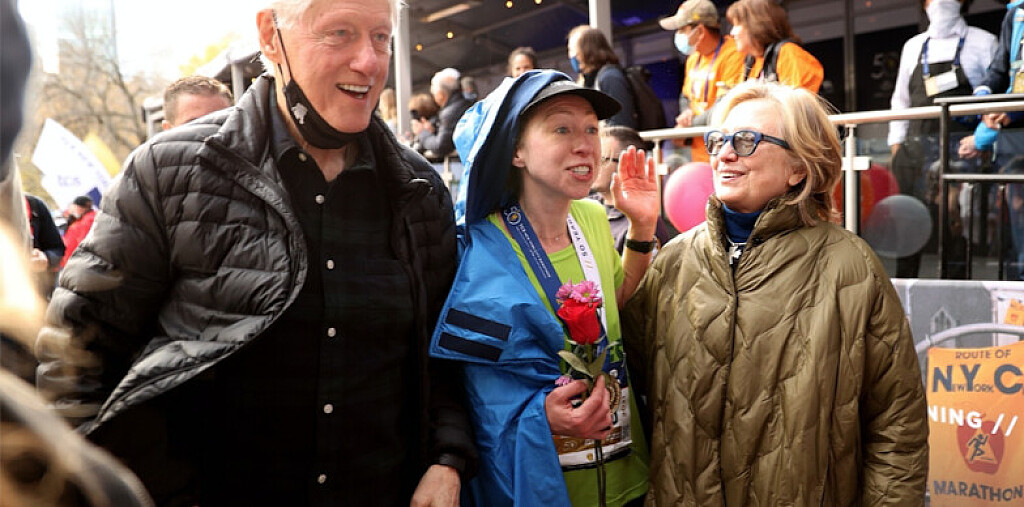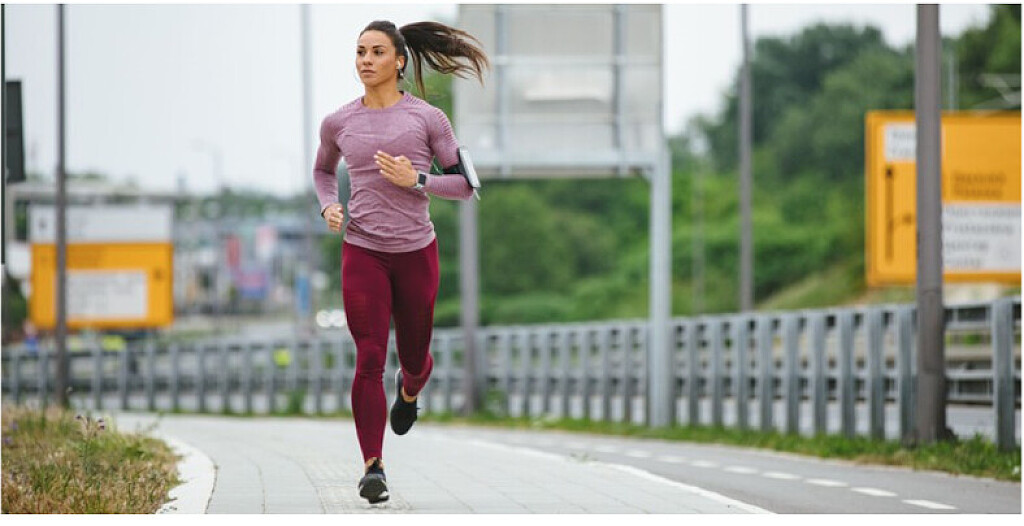Running News Daily
Running News Daily is edited by Bob Anderson. Send your news items to bob@mybestruns.com Advertising opportunities available. Train the Kenyan Way at KATA Kenya and Portugal owned and operated by Bob Anderson. Be sure to catch our movie A Long Run the movie KATA Running Camps and KATA Potato Farms - 31 now open in Kenya! https://kata.ke/
Index to Daily Posts · Sign Up For Updates · Run The World Feed
Articles tagged #Diabetes
Today's Running News
Move or Die: SCIENTISTS CRUNCHED THE NUMBERS TO COME UP WITH THE SINGLE BEST PREDICTOR OF HOW LONG YOU’LL LIVE—AND CAME UP WITH A SURPRISINGLY LOW-TECH ANSWER
TO PREDICT your longevity, you have two main options. You can rely on the routine tests and measurements your doctor likes to order for you, such as blood pressure, cholesterol levels, weight, and so on. Or you can go down a biohacking rabbit hole the way tech millionaire turned longevity guru Bryan Johnson did. Johnson’s obsessive self-measurement protocol involves tracking more than a hundred biomarkers, ranging from the telomere length in blood cells to the speed of his urine stream (which, at 25 milliliters per second, he reports, is in the 90th percentile of 40-year-olds).
Or perhaps there is a simpler option. The goal of self-measurement is to scrutinize which factors truly predict longevity, so that you can try to change them before it’s too late. A new study from biostatisticians at the University of Colorado, Johns Hopkins University, and several other institutions crunched data from the long-running National Health and Nutrition Examination Survey (NHANES), comparing the predictive power of 15 potential longevity markers. The winner—a better predictor than having diabetes or heart disease, receiving a cancer diagnosis, or even how old you are—was the amount of physical activity you perform in a typical day, as measured by a wrist tracker. Forget pee speed. The message to remember is: move or die.

It’s hardly revolutionary to suggest that exercise is good for you, of course. But the fact that people continue to latch on to ever more esoteric minutiae suggests that we continue to undersell its benefits. That might be a data problem, at least in part. It’s famously hard to quantify how much you move in a given day, and early epidemiological studies tended to rely on surveys in which people were asked to estimate how much they exercised. Later studies used cumbersome hip-mounted accelerometers that were seldom worn around the clock. The new study, published in Medicine and Science in Sports and Exercise, draws on NHANES data from subjects recruited between 2011 and 2014, the first wave of the study to employ convenient wrist-worn accelerometers that stay on all day and night.
Sure enough, it turns out that better data yields better predictions. The study zeroed in on 3,600 subjects between the ages of 50 and 80, and tracked them to see who died in the years following their baseline measurements. In addition to physical activity, the subjects were assessed for 14 of the best-known traditional risk factors for mortality: basic demographic information (age, gender, body mass index, race or ethnicity, educational level), lifestyle habits (alcohol consumption, smoking), preexisting medical conditions (diabetes, heart disease, congestive heart failure, stroke, cancer, mobility problems), and self-reported overall health.
Take a moment to let that sink in: how much and how vigorously you move are more important than how old you are as a predictor of how many years you’ve got left.
The best predictors? Physical activity, followed by age, mobility problems, self-assessed health, diabetes, and smoking. Take a moment to let that sink in: how much and how vigorously you move are more important than how old you are as a predictor of the years you’ve got left.
These results don’t arrive out of nowhere. Back in 2016, the American Heart Association issued a scientific statement calling for cardiorespiratory fitness, which is what VO2 max tests measure, to be considered a vital sign that doctors assess during routine checkups. The accumulated evidence, according to the AHA, indicates that low VO2 max is a potentially stronger predictor of mortality than usual suspects like smoking, cholesterol, and high blood pressure. But there’s a key difference between the two data points: VO2 max is about 50 percent determined by your genes, whereas how much you move is more or less up to you.
All this suggests that the hype about wearable fitness trackers over the past decade or so might be justified. Wrist-worn accelerometers like Apple Watches, Fitbits, and Whoop bands, according to the new data, are tracking the single most powerful predictor of your future health. There’s a caveat, though, according to Erjia Cui, a University of Minnesota biostatistics professor and the joint lead author of the study. Consumer wearables generally spit out some sort of proprietary activity score instead of providing raw data, so it isn’t clear whether those activity scores have the same predictive value as Cui’s analysis. Still, the results suggest that tracking your total movement throughout the day, rather than just formal workouts, might be a powerful health check.
The inevitable question, then, is how much movement, and of what type, we need in order to live as long as possible. What’s the target we should be aiming for? Cui and his colleagues track the raw acceleration data in increments of a hundredth of a second, which doesn’t translate very well to the screen of your smartwatch. The challenge remains about how to translate that flood of data into simple advice regarding how many minutes of daily exercise you need, how hard that exercise needs to be, and how much you should move around when not exercising.
To be honest, though, I’m not sure the quest to determine an exact formula for how much we should move is all that different from the belief that measuring your urine speed will give you actionable insights about your rate of aging. Metrics do matter, and keeping tabs on biomarkers backed by actual science, like blood pressure, makes sense. But it’s worth remembering that the measurement is not the object; the map is not the road. What’s exciting about Cui’s data is how it reshuffles our priorities, shifting the focus from all the little things our wearable tech now tracks to the one big thing that really works—and which is also a worthwhile goal for its own sake. Want to live forever? Open the door, step outside, and get moving.
Login to leave a comment
What’s Your Why? Our Readers Share Their Biggest Motivators for Getting Out There to Run
We asked runners what motivates them to get out and hit the road—their answers may inspire you.
Why do you run? If you’ve never thought about it before, ask yourself now.
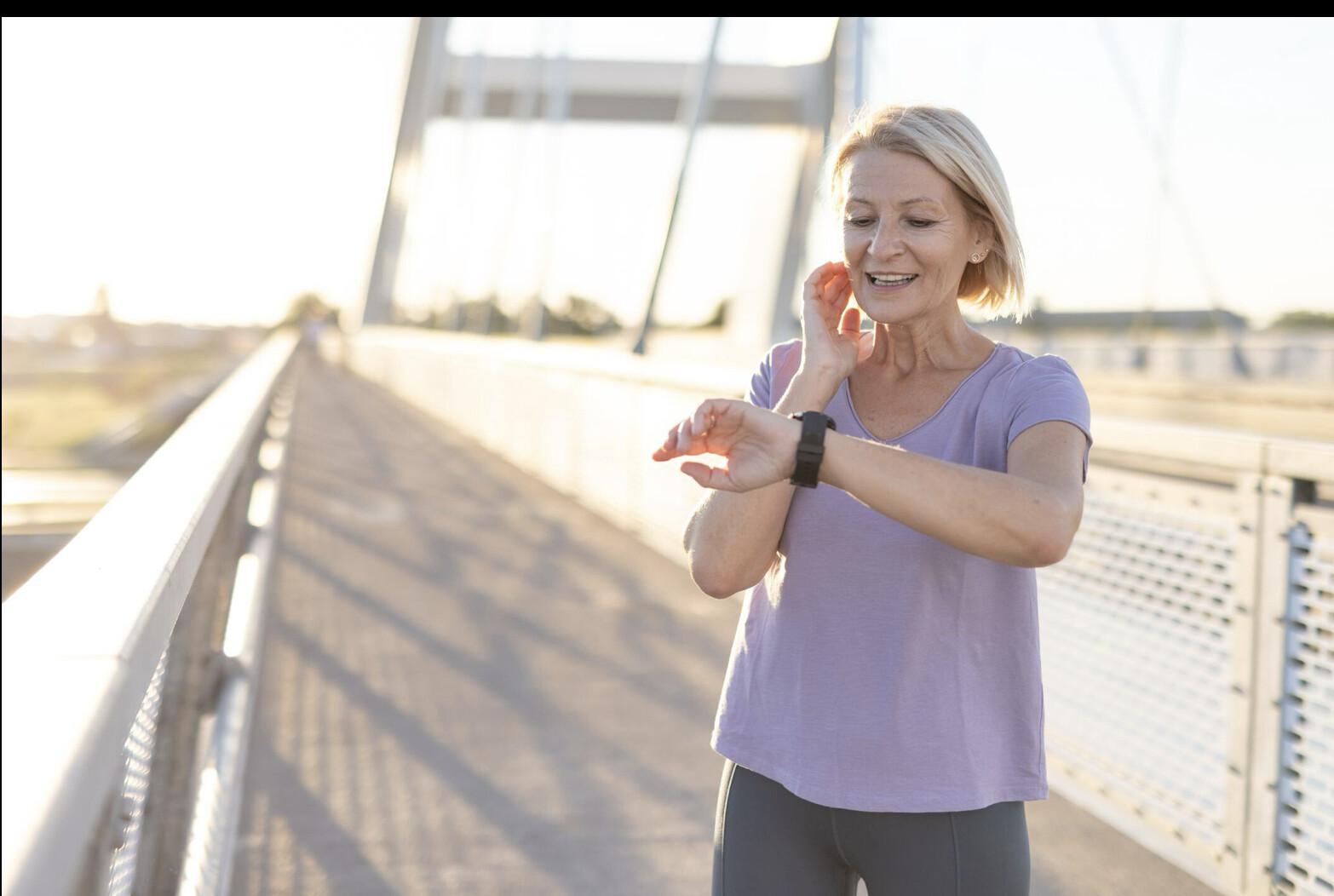

Being intentional about the reason why you run is a crucial part of maintaining motivation, especially if you’re just starting your running journey. Most of us know the research-backed benefits of running, but what is going to be that thing that gets you out the door when you don’t even feel like moving?
While your reason should be unique and personal to you, here’s some inspiration from our dedicated Runner’s World+ members and social audiences on Instagram and Facebook to keep in mind when considering what your why is.
For Myself
“Running is my ‘me time.’ It is time for me to simply run, listen to music, and enjoy the outdoors. It allows me to begin each day with a sense of accomplishment, and along the way I plan my to-do list, calculate finances, and solve problems. I do my best thinking when I am running. It also keeps me focused on my health and I always have at least one half marathon or marathon to train for.”—Jill Pompi (RW+ member)
“Because it’s the only thing in my life that’s just mine.”—April Thomson
“As a mom of three littles, running is my ‘me time.’ Time to fill my own cup; time to work toward a personal goal; time to show my kids that I enjoy movement simply because it helps me be happy, healthy, and strong!”—Marlena Shaw (RW+ member)
“It’s my time—no one asking me for anything. It’s me vs. me. Love the feeling after a long run.”—Spullins JB
“Running is just for me, and I run so I can be my best self. I don’t mean physically. Sure, I love how strong my legs feel when I cross a finish line or that good burn after a long run. But my best self is found when I hit the pavement and process whatever is going on in my life. I have two young kids (ages 3 and 14 months), and I am constantly being poked, pulled, and called. When I lace up my running shoes, the stress melts away and I am a better mother because of it.”—Melissa Hofstrand (RW+ member)
“To escape from reality for a brief moment and enjoy my ME time.”—Yuri Aguilar
“Sometimes to relax, regroup, and shake out anything bothering me… but usually to start my day off just right!”—Erin Carey Ryan
For My Health
“My health, specifically my heart.”—Kati Johnson (RW+ member)
“To maintain my health and challenge myself to reach new running goals.”—Gwen Jacobson (RW+ member)
“To fight bad genetics and hear my grandkids say, ‘Whoa, Grandma!’”—Michele (RW+ member)
“My asthma kept me from doing exercise for so many years. I’m running because I can finally do something I never thought possible.”—Patricia McHugh (RW+ member)
“To save my life. I am type 2 diabetic by way of having PCOS. By the time I was diagnosed with PCOS, I had developed full-blown diabetes. I run now to train for a half marathon I crazily signed up for and to get in shape for my first century ride next year. I will run and bike towards a cure.”—Stephanie Gold (RW+ member)
“I exercise and stay active so that I can be mobile and independent as long as possible as I get older. I choose running because it gives me such a great sense of accomplishment.”—Lisa Bartlett
“I run because last year I got Pulmonary embolisms in my lungs and now I want to improve my health and my lungs and spread awareness!”—Jennifer Cole
“Manage stress and support in quitting smoking.”—Aude Carlson (RW+ member)
“Keeps my AFib under control.”—Todd W. Peterson
“I want to be able to walk well into my old age. I have family members who have significantly lost mobility due to their unwillingness to exercise.”—Amy Watkins (RW+ member)
“To control my type 2 diabetes! It works!”—Mike Shamus
For Someone Else
“I started running after witnessing my mom complete a marathon and was overcome with emotion when she finished. I began running the very next year and completed a half marathon with my mom and have been running ever since. Running does so many things for me. It’s my escape, it keeps me centered, helps me to focus, a confidence builder but more importantly allows me to follow in the footsteps of my mom and continue to honor her. I wear a shirt with a picture of her running our last race together so that she’s running with me. I love to run!”—Chantal (RW+ member)
“My daughter.”—Jesse Sturnfield (RW+ member)
“To keep my sanity. Also, I wanna show my kids if they work hard, don’t give up, and find a love for something, they can accomplish anything in life. When they’re tired, stressed, unhappy, just to channel in and get the work done. They’ve been there when I run my marathons and have shown support and encouragement, and I’ll do the same for them. My daughter joined cross country this year and wants to join again next year. My son is wanting to join as well.”—Angela Yawea
“Because my dad ran. I lost him six years ago and clearing his flat I found his medal from Reading Half Marathon in 1988. Holding it inspired me to change. I have my dad’s and my medal from the same race together.”—Stumpy Taylor
For My Mental Health
“To keep my sanity!”—Libby Meyer (RW+ member)
“It’s my therapy.”—Allie Haight
“Running is my ultimate stressbuster! As a middle-aged tech leader, husband, and father to two preteens, running generates all the right endorphins and energy to ensure I’m on top of my game—all of my games!”—Annu Kristipati (RW+ member)
“Cheaper than therapy.”—Louie J. Frucci
“Running helps me dealing with my anxiety, my mental health, but especially this past year with grief. I lost my dad last year and couldn’t work out for two months. I was able to go back to working out thanks to running. Then I signed up for my first marathon. That was on the one-year anniversary of my dad’s passing. Running is my way to feel my dad close and be able to connect with him.”—Fadela (RW+ member)
“Because it has the power to mute my anxiety and self-doubt.”—Nicholas Kuiper
“Running makes me happy. It reduces my stress and anxiety and improves my mental health. It keeps my cardiovascular system strong.”—Suzanne Reisman (RW+ member)
“To stay calm in the chaos.”—Christine Starkweather
To Feel Powerful & Free
“Because it makes me feel powerful and healthy (sometimes only once it’s over).”—Laura (RW+ member)
“To be a real-life video game character.”—Erin Fan (RW+ member)
“Feels like I’m flying. Powerful and free.”—Tenaya Hergert
“I run because I want to be healthier in my 50s than I was in my 30s! And, also, running makes me feel powerful.”—Laura (RW+ member)
“Running gives me a voice.”—Becky Westcott Capazz
“It makes me feel strong and confident, that I can handle everything else in my day.”—Rebecca Eisenbacher (RW+ member)
“To feel free, manage anxiety, accomplish increasing mileage.”—Barbara Saunders (RW+ member)
“Total freedom. Slap your shoes on and be free.”—coach_shasonta
For Connection
“Running makes me feel strong and is my way of meditating. I also love that I’ve been able to connect with people and make so many new friends through running. I enjoy seeing my fitness progression.”—Gisele Carig (RW+ member)
“For my mental health and human connection with friends.”—lizpowers76
“Refreshes the spirit. BTW: I can no longer run; I train and enter races as a walker. Have made many new friends who accept me for just being there.”—Lewis Silverman
“I have many reasons. I connect with my running partners on some runs. I connect with God on others. I find a sense of accomplishment. I like to test what my body can tolerate.”—Tim Thomas (RW+ member)
“When I’m alone, I run to quiet my mind. It is meditative and rejuvenating. I also run to be social. The running community is the best.”—Andy Romanelli (RW+ member)
“Makes 77 feel young and hanging around with younger runners is a whole lot of fun. Not to mention I’ve been loving going for a run for more than 46 years.”—Barbara Ann Morrissey
Because I Love Racing
“I want to improve my 5K time.”—Courtney Danko-Searcy (RW+ member)
“The feeling I have on race day, within the first mile, that all the training is paying off.”—Mark Hopkins (RW+ member)
“My husband and I started running about six years when my son, who was about 12 at the time, had run over 25 5Ks. It took about a year until we were ready for our first 5K. We love running and training together. Running helps me at the end of a long teaching day, and it just feels so good after! We have since ran many 5Ks, some 10Ks, and two half marathons!”—Suzy Wintjen (RW+ member)
“It’s at the end of Ironman.”—Cheryl Turpin
“First, I began to improve my health, then I got hooked. Fifteen years later I am chasing my Six Star Medal.”—Jorge Mitey (RW+ member)
“It’s something I’ve always done since fifth grade. I got into racing 25 years ago. I love the challenge running gives me to constantly improve and get back out there whenever I’ve been injured or ill; and next month will one year since starting my first running streak! Most of all, I run because I love how it makes me feel. It has gotten me through the worst times in my life. Whenever I’m having a bad day, whether I’ve already gone running or not, I go running. It always calms me and makes feel better.”—Elle Escochea Grunert
So That I Can Indulge
“Because I love carbo loading.” —Bud Bjanuar
“I run so I can eat whatever I want and still be in shape!”—Christi Webb (RW+ member)
“I run to eat poutine.”—Robin Bosse
“So I can drink beer!”—Kathy Davis Ward
“Because I am a chocoholic.”—Chantal Englebert
“Faster than walking and I like tacos.”—Shelly Pedergnana
“I run to eat crispy pata.”—Arrin Villareal
To Get Outside
“Fitness and peace of mind. Also, a great way to explore neighborhoods and the outdoors.”—Sue Padden
“The feel of being outside with my dog. Watching him enjoy the run lets me enjoy the run.”—Stan (RW+ member)
“It’s my time with nature. It’s for me to clear my head and think.”—Assa Burton
“Running is my sanctuary. It’s where I can clear my mind, letting go of stress and finding clarity with each step. The rhythm of my feet hitting the ground is a meditative escape, helping me to focus and recharge. Physically, running keeps me in peak condition, building strength and endurance while boosting my overall health. But what I love most is being outside, feeling the fresh air, and soaking in the beauty of nature. Whether it’s a sunlit trail or a quiet street at dawn, running connects me to the world around me in a way nothing else can.”—Adam Scolatti (RW+ member)
Because I Can
“This is my ‘stock’ answer. I do because I can and I can because I do.”—Chip Kidd
“Because I’m not ready to give up yet.”—Martha Rhine (RW+ member)
“Because I was completely disabled, not able to move, stand, walk, talk, or do anything... stuck in the hospital for 13 weeks. When I was discharged and started to walk a little, I needed something to help me get some kind of life back. Running was it.”—Rob Snavely
“Because I’m 70, and not dead yet.”—Michele Glover
“Because I can. One day I won’t be able to and it’s not today.”—Mike Bravo
“Because one day I’ll be old and everything will hurt, and it’s the one thing in my life that lately makes me happy. When you’re running you forget everything. If you’re still thinking of debt, sadness, breakups, you’re not trying hard enough. Every day you have to push yourself.”—Miryam Hernandez
“Because I still can… at 73.”—Joanne Gile Michaelsen
“Forty-five years, why stop now? Never regret going for a run.”—Leslie Kitching
“Sixty-one years old. Been running since I was 15. Because a day without running is like a day without brushing your teeth.”—Sharon Graeber Hall
To Prove it to Myself or Someone Else
“To prove I can. And prove my mind is more powerful than my body.”—Colton James
“Because I still can, and everyone tells me I can’t!”—Lloyd K Leverett
“To tell people I did.”—Chris S. Charlett
“I’m 55. Basketball days are over. The need to compete is still there, and even if that means competing with myself, running allows me to do that.”—Shawn Davis
Because I Hate How I Feel When I Don’t
“I don’t know, but recently I injured my knee, and I was sad I couldn’t run. Thank god, it healed itself. I think running gives me inner peace.”—Jose Murga
“Because I hate the way my brain itches when I don’t.”—Joe Baron
“Because it’s better than smacking my family upside the head from being over stimulated. [It] helps my mental health.”—heatherbrubaker19
“I don’t like it until it’s over.”—Laurie Stinson Fuller
“So that I am tolerable to my husband!”—Dimitra Zakas
“It’s either that or sending my work computer flying out the window like a frisbee on the regular.”—Ayla Amon
“It feels so good when I stop.”—Sarah Wiley
Login to leave a comment
3 Years Ago, He Weighed Almost 500 Pounds. Now He’s a Marathon Finisher
César Torruella says running has been instrumental in building a healthy life.
In 2021, César Torruella struggled to walk even short distances around his neighborhood in Houston, Texas. Weighing in at 495 pounds, the former vocalist and music teacher underwent bariatric surgery to address critical health issues that were putting his life at risk.
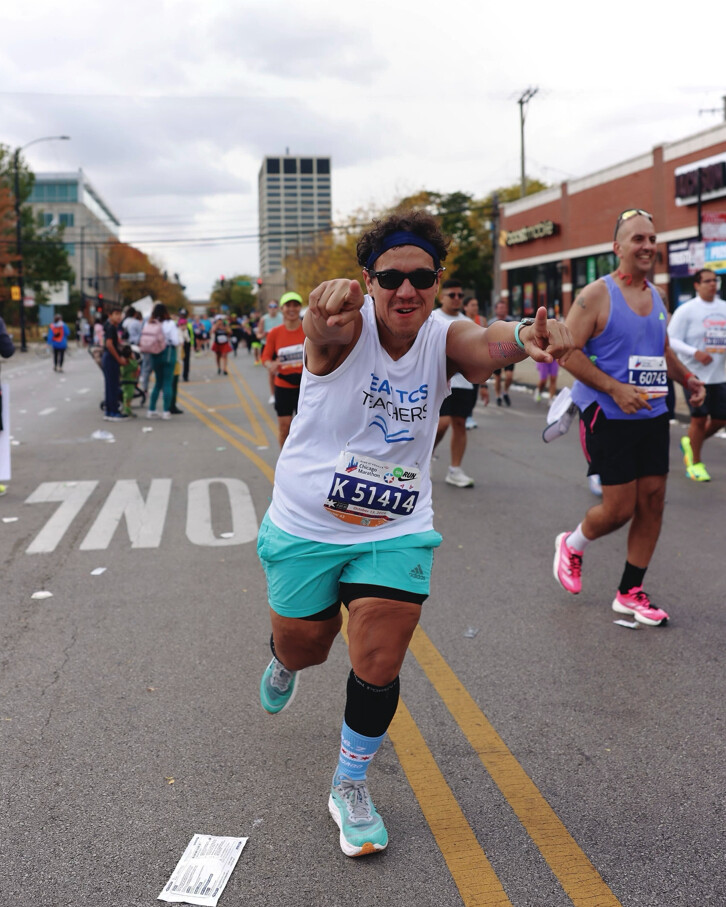
Three and a half years later, Torruella completed his first 26.2 at the 2024 Chicago Marathon, an experience he considers a “celebration” after many hard-fought moments in the 35-year-old’s weight-loss journey.
On race day, Sunday, October 13, Torruella faced setbacks—including a pulled muscle in his right quad, which forced him into the medical tent at mile 17—but he continued on, often pushing through tears in the latter half of the race.
In the tougher miles, Torruella focused on regulating his breath under a compression suit designed to hold in excess skin and prevent chafing beneath his shorts and singlet. He thought about running to his partner, Esteban, at mile 20 in the Pilsen neighborhood. He also focused on who he would become when he finally reached the finish in Grant Park.
“This pain and struggle was necessary to carry me through closing this chapter of my life after losing so much weight,” Torruella told Runner’s World a few days after completing the marathon in 5:58:46.
“I feel like a new version of myself was born as I crossed that finish line.”
Growing up in Puerto Rico and later moving to Houston in 2012, Torruella struggled with weight management for most of his life. When the pandemic forced everyone into quarantine, Torruella ate as a way to cope. “I found asylum in food to a point that it got out of control,” he said. “I became addicted to eating and eating unhealthy.”
In 2021, Torruella weighed almost 500 pounds. He was diagnosed with high blood pressure, pre-diabetes, and hypertension. He was also starting to lose his vision, a condition that can develop as a result of high blood pressure and diabetes.
It was a wakeup call for the singer, who decided to change his habits and undergo bariatric surgery—a weight-loss procedure that involves making changes to the digestive system to help the patient lose weight. After the procedure, patients must make permanent healthy changes to their diet and exercise routine to help ensure the long-term success of the surgery.
Post-surgery in June 2021, Torruella had to relearn the basics of eating (a process that involves different phases, similar to how a baby learns how to eat solid foods) and how to exercise.
“Never in my life did I know what going to the gym meant or what you do when you get there,” Torruella said. “I was learning how to move again, how to accept my body, and how to find love in the foods that nourish me.”
Six months after surgery, Torruella lost almost 200 pounds, a result of medical and family support as well as
“I wouldn’t be closing this chapter of my life if it weren’t for the opportunity I got through TCS,” Torruella said. “They gave me a platform to advocate for arts education and to encourage other teachers and folks that are struggling with obesity that this is possible.”
After the defining experience in Chicago, Torruella is already planning to take on another marathon next year. This time, he wants to run a personal best.
“I will gain a lot more flexibility and freedom to move [after surgery], and then I can start training to finish my marathon a little faster,” he said.
Login to leave a comment
'Micro-Walks' Could Burn More Calories Than Longer Ones. Here's How Long You Should Be Walking For
A new study just discovered the benefits of shorter strolls.
For years, doctors have stressed the importance of being active during your day—after all, research has found that sitting for too long raises your risk of a slew of serious health conditions, including cardiovascular disease and type 2 diabetes. But the idea of going for hour-long walks can be overwhelming. Now, new research suggests you don’t need to jam in a massive stroll into each day: Instead, you can go for “micro-walks.”
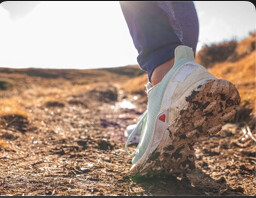
That’s the main takeaway from a study published in Proceedings of the Royal Society B, which found that micro-walks may be even better for you than long ones. Here’s the deal.
What are ‘micro-walks’?
In this study, a “micro-walk” is defined as walking between 10 and 30 seconds at a time (with breaks in between your next walk).
Are ‘micro-walks’ more beneficial for your health? Why?
It depends on how you’re looking at it. In this particular study, volunteers walked on a treadmill or climbed a short flight of stairs for different periods of time, ranging from 10 seconds to four minutes. The study participants wore masks to measure their oxygen intake (which can be used to calculate energy or calorie consumption).
The researchers discovered that people who walked in short bursts used up to 60 per cent more energy than longer ones, despite the walks covering the same distance. (The more energy you expend, the more calories you can burn.)
Basically, you may be able to rev up your metabolism and burn more calories if you do short bursts of walking versus longer cruises around.
Albert Matheny, RD, CSCS, a co-founder of SoHo Strength Lab, says there’s something to this. “Getting activity throughout the day, in general, is better for people,” he says. “It’s better for circulation, mental health, and digestive health.”
You’re also more likely
by Women Health magazine
Login to leave a comment
How Many Calories Do You Actually Burn While Running?
Most people overestimate how many calories they torch while running. Here’s how to figure out your numbers—and tips to boost the burn.
There are so many reasons to run, including spending time in nature, taking a break from scrolling social media, and hanging with like-minded people. One of the most common reasons people turn to the sport: to boost physical and mental health. In fact, three out of four runners say staying healthy and in shape is a primary motivation for lacing up, according to a survey from Running USA.
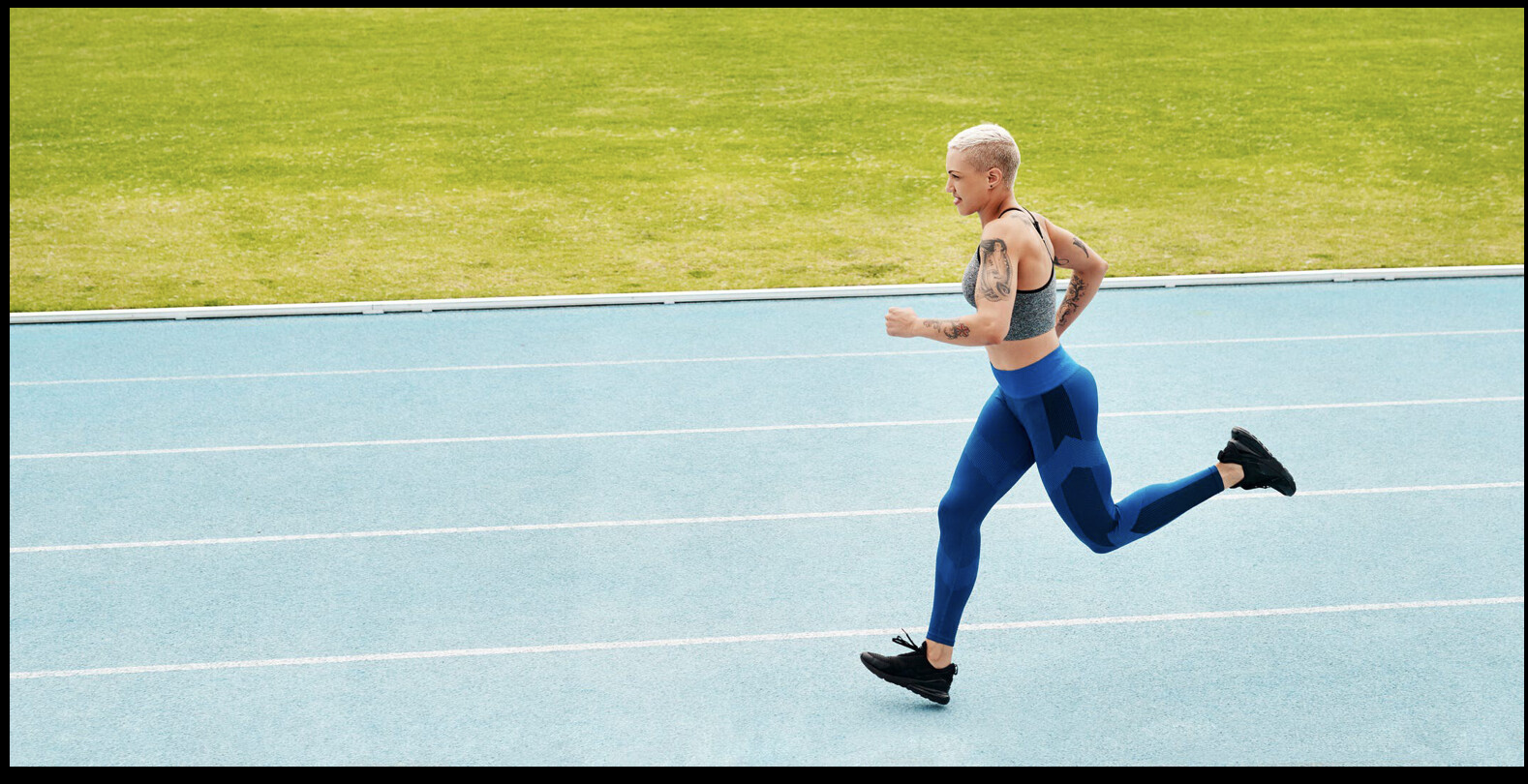
For many people, “staying healthy and in shape” translates to burning calories and keeping weight in check, and running is a top activity for revving your heart rate and blasting calories. But just how many calories do you burn running one mile?
Turns out most people don’t know the answer: When runners completed both moderate- and vigorous-intensity workouts on a treadmill, they greatly overestimated how many calories they burned—some by as much as 72 percent—in a 2016 study in Medicine and Science in Sports and Exercise.
So let’s break down approximately how many calories the average runner burns over the course of one mile and how to calculate your calorie-burn rate, plus expert tips to raise that number.
How many calories does the average runner burn running one mile?
It’s difficult to generalize how many calories everyone would burn running one mile, as many factors play into your energy expenditure. But the general baseline is that runners burn about 100 calories per mile, April Gatlin, certified personal trainer and senior master coach for STRIDE Fitness in Chicago tells Runner’s World.
Two important factors that change that number are the intensity of your run and your weight, according to the 2024 Adult Compendium of Physical Activity, which calculates the energy cost of physical activity based on metabolic equivalents (METs).
Based on the MET chart, running a 10-minute mile (6 mph) is equivalent to about 9.3 METs. That means a 150-pound person (68 kilograms), would burn about 11 calories per minute or about 110 calories in a mile when running at 6 mph.
To calculate calories burned per minute using METs, follow this formula: METs x 3.5 x (your bodyweight in kilograms) / 200
Intensity and weight aren’t the only variables that can alter how many calories you burn running a mile, though. “Running mechanics play a big role in caloric expenditure—different aspects such as ground contact time, vertical motion, and muscular strength have a significant effect on the amount of calories that are burned or energy that is expended in terms of oxygen consumption,” Grace Horan, exercise physiologist at Hospital for Special Surgery in New York City tells Runner’s World.
That oxygen consumption, along with fuel utilization—which is how our cells use carbs and fat for fuel—is what caloric expenditure is all about, she says. Because there’s more vertical motion (or bounce) in running compared with walking, that translates to higher calorie burn. “Your body is now not only using energy to travel horizontally but vertically as well,” Horan adds.
What factors affect your one-mile calorie burn?
1. Weight
“The heavier the runner, the higher the calorie burn as their body is working harder to move forward,” says Gatlin. In fact, a 185-pound person burns nearly 100 calories more per 30 minutes of running at 5 mph compared with a 125-pound person, according to estimates from Harvard Medical School.
2. Pace
Running a fast mile will burn a higher number of calories than a slow mile, says Gatlin, especially if you mix in speed intervals: “Intervals will burn more calories overall due to the varied high-to-low heart rate burst causing excess post-exercise oxygen consumption (EPOC), which is an after-burn effect,” she explains. “That causes the body to continue to burn at the higher metabolic rate after the training is complete.”
The same holds true about running versus walking: People who ran a mile showed increased energy expenditure (read: calorie burn) for 15 minutes postworkout while those who walked the same distance increased the after-burn effect for only 10 minutes, according to a study published in the Journal of Strength and Conditioning Research in 2012, involving 15 males and 15 females.
3. Sex
“There is also some evidence that gender plays a role in caloric expenditure, with females often burning less calories compared to their male counterparts when running at the same speed for the same distance,” says Horan.
However, she notes, the difference in overall body mass between men and women is generally thought to be the primary cause for this.
4. Fitness, biomechanics, and genes
While concrete stats, such as speed and weight, contribute to calorie burn, so do fluctuating variables that are more difficult to count. “Burning calories is directly related to oxygen consumption, which is determined largely by the ability of the lungs to take in large amount of oxygen and the heart to pump oxygenated and nutrient-filled blood to the working muscles, so cardiorespiratory fitness [level] has a major effect [on calorie burn],” notes Horan. While there’s no simple way to incorporate these details into your calorie estimates, know that they do have a bearing.
In other words, while you can get a rough estimate of how many calories you burn over a given distance or time, remember that these are just estimates.
How can you estimate your personal calorie burn?
In addition to the MET equation mentioned above, Runner’s World has a calories burned calculator to help. Pop in your weight, along with how far you ran and how long it took you, and it’ll pinpoint approximately how many calories you expended on that outing.
While this does take some variables into account (i.e., your weight and speed), it doesn’t factor in extras like your fitness level or what kind of terrain you covered. For example, if your course was totally flat, you likely torched slightly fewer calories than if you’d encountered tons of hills, according to Gatlin.
How can you increase the calorie burn of your one-mile run?
1. Add in speed
The higher your effort during a run, the more calories you’ll burn per minute, which also means you can expend more energy in less time the faster you run.
Research backs this up: A study published in 2019 found that high-intensity interval training (doing 10 reps of one-minute intervals at 100 percent of VO2 max with one minute of recovery) took less time to reach the same energy expenditure of a moderate-intensity workout (going for 35 minutes at 65 percent of VO2 max).
Another study, published in 2013, also found that sprint interval training can increase total daily energy expenditure after one session.
2. Tackle hills
Heading to a hilly course outside (or cranking up the incline on a treadmill) is great for torching calories, because it’s as if you’re adding resistance training to the workout, notes Gatlin. That’s because your lower-body muscles perform at a higher level of mechanical work to increase your potential energy on an incline, compared with level or downhill running, according to a 2016 article in Sports Medicine.
3. Break up your run
Planning to run three miles today? If you break them up into three one-mile runs throughout the day and run each of those at a faster pace than you’d run one steady-state run, you’ll boost the calorie burn, says Gatlin.
The reason: It goes back to that afterburn effect—you burn more calories when you’re done running—as well as the ability to turn those shorter runs into higher-intensity exercise.
What other benefits do you gain from running a mile?
All this being said, frying calories is hardly the only benefit of a running routine. Opt to run instead of walk a mile and you will also boost your aerobic capacity, muscular endurance, and metabolic rate, says Gatlin.
Additionally, running improves your overall health by warding off all kinds of medical issues. “It’s heavily supported that increasing aerobic capacity through running has been linked to decreases in incidence of many health conditions, including heart disease, diabetes, and some forms of cancer,” says Horan. Plus, “recreational running on a regular basis also creates favorable conditions for bone formation, which leads to increased bone mineral density and decreased risk of fractures.”
Even slow, short runs have fantastic health benefits. One study that followed more than 55,000 Americans over 15 years found that those who ran less than a 10-minute-per-mile pace for five to 10 minutes a day had significantly reduced risk for all causes of death.
So even if you come to running for the calorie burn, there are good reasons (lots of them!) to keep coming back for an all-over health boost.
Login to leave a comment
How to Avoid Leg Cramps while Running that Slow You Down
Leg Cramps while Running
Runners can avoid the most common injury of muscle cramping if they tried. These cramps develop mostly in their lower legs and feet. The effects can be debilitating, especially when you are experiencing them for the first time. Learn more about this problem and a few tips to become a better runner while avoiding cramps.
Stretch Before You Go
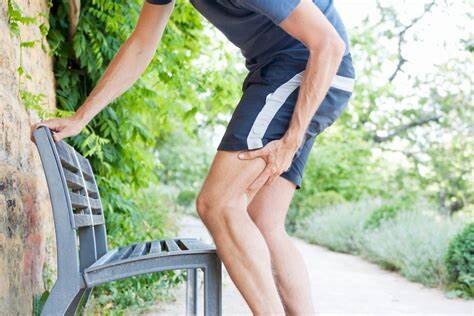
Many sports require their participants to be lean and flexible, and running is no different. Stretching helps to loosen the muscles in your legs, arms and back. Even people who have naturally stiff, rigid legs can run farther after a few stretches. Muscles that are used more often are less likely to tear. So people who do not exercise regularly are more likely to get cramps.
To improve your running performance, turn stretching into a routine. Perform quick, five-minute stretching exercises that take no more than 10 minutes to complete. Perform these exercises right before you begin running. Once you’ve finished, it’s optional to stretch your muscles again.
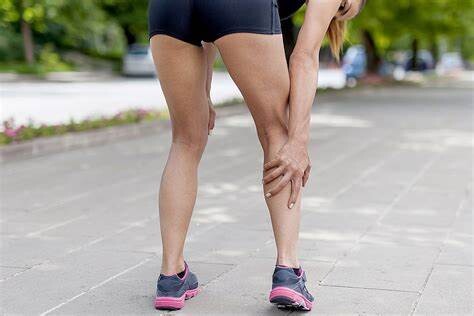
Stay Hydrated
Staying hydrated is necessary to maintain a normal body temperature and remain cool while you’re running on hot days. Dehydration occurs when you run for long periods without drinking water. To remain hydrated, drink long sips of water before, during and after your running sessions.
Some people choose to drink an hour or two right before they start running. Some runners add salt to their water. Sodium from the body is lost through sweat as you run. These “salt shots” are supposed to make up for this loss and keep the body in proper balance.
Why are Electrolytes So Important?
For people who cannot carry around salt or ten bottles of water, consuming an SOS electrolyte drink is the easiest way to hydrate yourself. SOS Hydration contains the right mixture of healthy fluids and sodium that your body needs to stay in top performance. Regular water alone is not enough. Also read: What are Electrolytes.
The sodium that you lose in your sweat could lead to muscle cramps in the end. Losing too much sodium is dangerous for runners and athletes in particular. An electrolyte drink (SOS) contains 330mg of sodium, on average, for every eight ounces (236.59 mL) of water along with 195mg of potassium for good muscle contractions.
Avoid Certain Foods or Drinks
There are some habits to avoid before you run. Know that a caffeinated soft drink is the worst choice for runners as it contains high amounts of sugar. Consuming too much sugar at once has good and bad effects on the body. At first, you may feel a boost of energy, but sodas and juices increase your risks of tooth decay, diabetes or obesity.
Start Out Slowly
Another reason why cramps may occur is because the body is not prepared for intense workouts. This happens to people who have not exercised for long periods of time. They have the right attitude but assume that their bodies are naturally fit and healthy. As a new runner, you cannot perform an endless series of sprints when you haven’t gotten used to jogging yet. Build up your running slowly and take it one step at a time. Listening to your body while running is an incredibly important skill.
Have Rest Periods
Cramping occurs to runners who do not rest properly. Even experienced runners run into problems when they overuse their bodies. They begin to overstretch their muscles and risk injuries, even after years of experience. Allow your body enough time to rest in between sessions and rebuild its muscular strength. Most fitness experts suggest that runners have at least one day of rest every week to allow your body to recover for your next run.
From sports doctors, one of the most popular complaints involves muscle cramps, swelling and stiffness. Anyone who has fallen behind on exercise is likely to get cramps. However, some of the best runners have occasional cramps when they miss a few steps in their routines. Stretch, stay hydrated, consume electrolytes and get enough rest to get the best results from your running.
by Sos Hydratation
Login to leave a comment
Does running really help you live longer?
Running is often hailed as a fountain of youth, with promises of extended lifespan, reduced risk of chronic diseases and improved mental health. But can hitting the pavement really help you live longer (and by how much)? A recent large-scale study explored the relationship between different sports and longevity, offering insights into whether running—and other physical activities—actually add years to your life.A global look at sports and lifespan
Researchers out of the European Research Institute for the Biology of Ageing analyzed data from over 95,000 athletes across 183 countries, representing 44 different sports disciplines. They aimed to discover how various sports impacted lifespan by comparing athletes’ ages at death with those of the general population. The study was primarily male-dominated (95.5 per cent of the data), but it provided some fascinating insights into which sports extended lifespan the most.
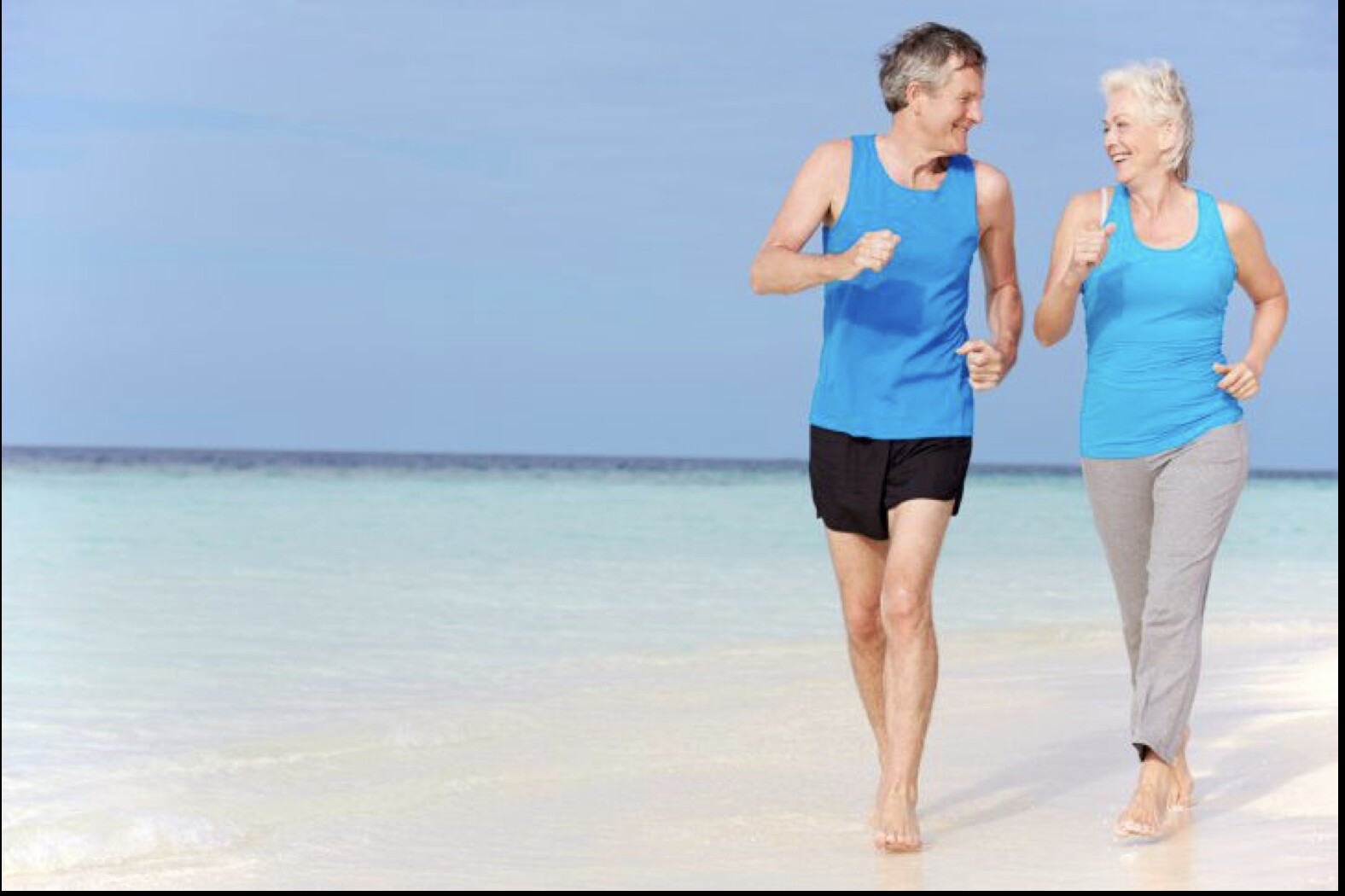
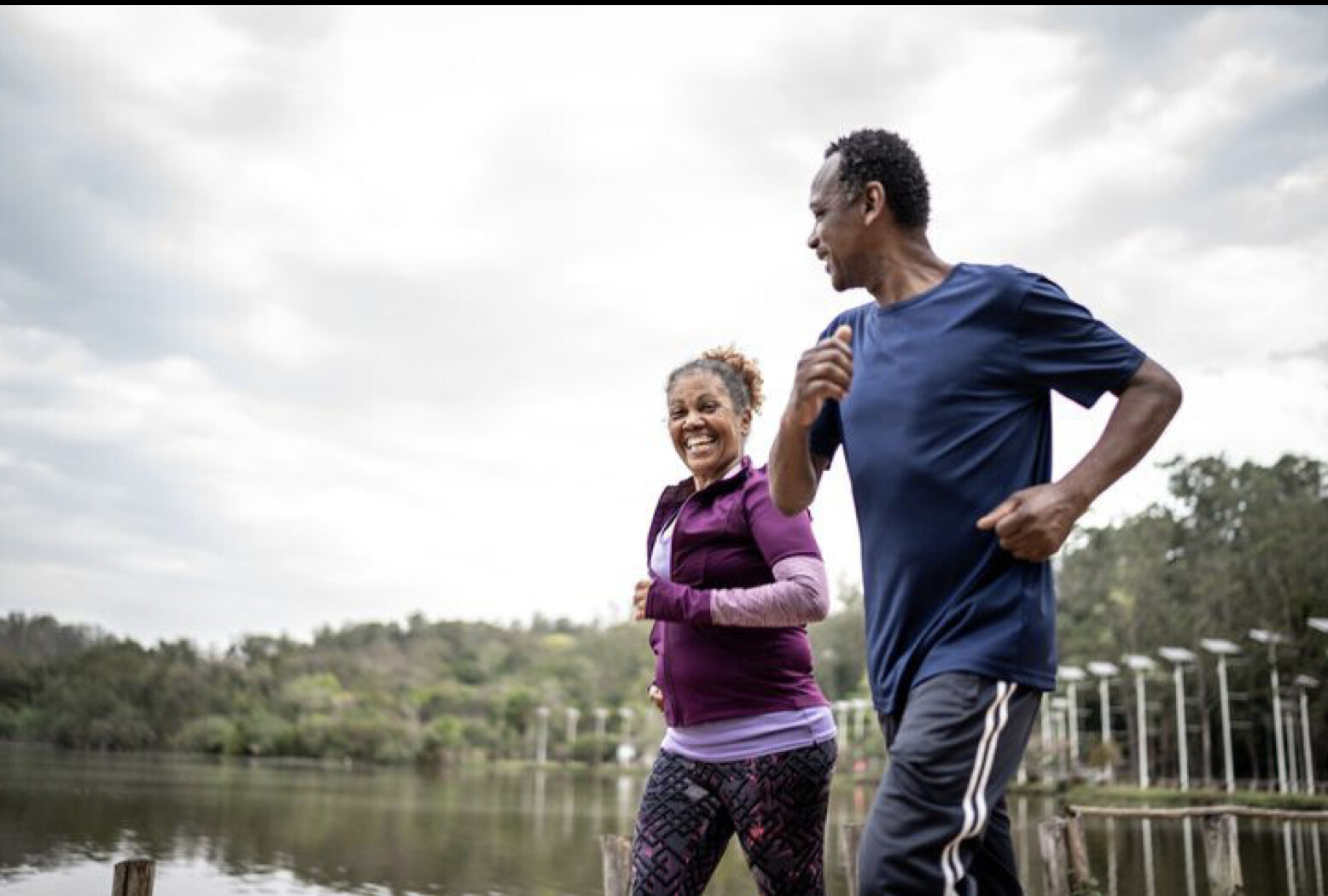
Interestingly, the results varied widely depending on the sport. Aerobic activities like running, known for improving cardiovascular health, were expected to have positive outcomes. But how did running compare to other sports, and what were the key takeaways?
Does running really extend your life?
In this study, running wasn’t singled out as the top sport for extending lifespan, but aerobic and mixed sports consistently showed a positive impact on longevity. This makes sense given the well-known cardiovascular benefits of running, including improved heart health, better blood circulation and a lowered risk of conditions like stroke or hypertension. According to the study, running helps boost endurance and overall health, both crucial factors in longevity.How other sports stack up
While running is great for your heart, other sports like pole vaulting and gymnastics had the biggest positive impact, with athletes gaining up to 8.4 extra years of life. On the other hand, sports like volleyball and sumo wrestling were linked to a reduction in lifespan, possibly due to high physical strain or weight-related factors in those sports. Mixed sports that combine aerobic and anaerobic exercise, like rowing or tennis, also showed significant benefits, particularly in extending the lifespans of both male and female athletes.Why running helps
Running’s benefits likely come from its aerobic nature. Aerobic exercise improves the body’s ability to use oxygen efficiently, which boosts heart health and endurance. This, in turn, helps reduce the risk of chronic diseases like diabetes and heart disease—two major contributors to early death. Studies also show that runners tend to maintain better body composition, stronger bones and reduced inflammation, all of which contribute to living longer and healthier. Should you add gymnastics training or pole vault practice to your running routine? Well, that part is up to you.
by Running Magazine
Login to leave a comment
BMI Is a Controversial Measure of Health Outcomes—a New Study Suggests a Better Method
It’s not all about height and weight.
New research suggests incorporating waist circumference into how we predict health outcomes, instead of relying on BMI.
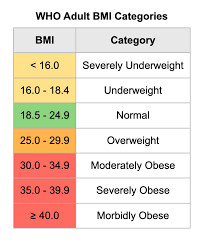
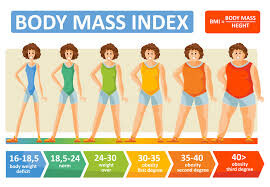
Study authors say BMI does not take into account muscle mass or the links between abdominal fat and poorer health, among other downfalls of the measurement.
In an effort to understand how body composition affects health, most medical professionals and researchers still use the body mass index (BMI), but this has always been a problematic and controversial method when actually applied to individuals, rather than large populations. For example, commentary in the British Journal of General Practice, published back in 2010, called use of BMI unethical, overly simplistic, and potentially harmful to a significant proportion of patients.
A new study in JAMA Network Open assessed a possible pivot toward a different measurement tool: the body roundness index, or BRI. In addition to weight and height (which is all that the BMI includes), the BRI considers waist circumference because that can more comprehensively reflect visceral fat distribution, according to the study’s lead author Xiaoqian Zhang, M.D., at Beijing University of Chinese Medicine in China.
In the cohort study involving nearly 33,000 U.S. adults, researchers looked at the association between an increase in BRI from 1999 to 2018 and the significant rise in all-cause mortality (particularly cardiometabolic disease, kidney disease, diabetes, and cancer) during the same period.
More abdominal fat has been linked to higher risk of these conditions because this type of fat is often visceral, which means it wraps around your organs instead of sits just under the skin. That means it can increase inflammation and drive more chronic diseases, Zhang told Runner’s World. For example, one study of Korean adults found those with normal body mass index had more cardiovascular risk factors if they carried excess abdominal obesity.
“Because of the way it includes waist circumference, BRI effectively provides a more accurate indication of health problems related to being overweight or underweight,” Zhang said. “We found both the lowest and the highest BRI values are associated with significantly increased risks of all-cause mortality.”
The Problem with BMI
Considering a switch away from BMI involves understanding why this effort matters. BMI was not meant to be used on an individual level. It relied only on Belgian men (because it was a formula devised in the 1830s by a Belgian mathematician) and did not take women and/or non-Caucasians into account, the British Journal of General Practice authors noted. As other researchers note, it was also not meant to inform medicine or predict health outcomes
By looking only at height and weight, the BMI might measure general obesity but it doesn't distinguish body fat from muscle mass, said the recent study’s co-author Wenquan Niu, Ph.D., at the Center for Evidence-Based Medicine in China. Because of this, for example, many bodybuilders are classified as obese.
“Fat distribution and body composition can vary dramatically among individuals who have the same BMI,” he told Runner’s World. “That’s why we need a more accurate indication of health problems related to overweight or underweight. Using the BRI is more helpful for this, given the limitations of the BMI metric.”
What to Know About Waist-to-Hip Ratio
The BMI and BRI are not the only possibilities when it comes to body composition. One that’s easy to measure at home is hip-to-waist ratio (WHR), which involves measuring both of those and then dividing your waist number by your hip number. According to a study published in JAMA Network Open in 2023, the ideal ratio for most men is below 0.95 and under 0.85 for women.
Even if you’re physically active and are not overweight, the WHR can help identify your risk of future metabolic issues, because abdominal fat plays a significant role in issues like insulin resistance and hypertension, according to Vitor Engrácia Valenti, Ph.D., a researcher at Sao Paulo State University in Brazil who has done work on body composition.
“The BMI calculation is far less helpful than your WHR, which can give you an indication of whether your waist circumference is outside the normal range,” he told Runner’s World.
Other indicators of body composition are lean muscle mass and fat mass, but those require specialized equipment such as a DXA scan for accurate numbers, Valenti added.
In general, the goal shouldn’t be reducing body fat as much as possible—you do need body fat for overall health—but to focus on reduction of abdominal fat in particular.
Although “spot training” for this type of fat is not a possibility, a systematic review and meta-analysis published in Advances in Nutrition looked at 43 studies focusing on training styles and their effects. Researchers found that although aerobic exercise tends to produce slightly greater efficacy in decreasing belly fat, the biggest change comes when it’s combined with resistance training.
by Runner’s World
Login to leave a comment
All the Benefits You Gain from Walking, Even if You Don’t Hit 10,000 Steps
Putting one foot in front of the other can help you live a healthier, happier life.
In the age of biohacking and complicated training protocols, it’s a good idea to periodically circle back to basics and remind yourself that exercise doesn’t need to be complicated to be effective. Sometimes, the best type of movement is the simplest, and it doesn’t get simpler than walking.

Yes, walking—the same physical activity you’ve been performing since toddlerhood. Back then, putting one foot in front of the other and moving your body from point A to point B was a thrill. Truthfully, you may never fully tap into that feeling of unencumbered freedom or primal joy again. Nevertheless, understanding the physical and mental health benefits of walking may inspire you to up your daily step count or squeeze in a quick stroll after dinner.
To convince you to do just that, we looked at the research and chatted with health and fitness experts for their thoughts on the benefits of walking. The next time you bump up against some confusing health advice or feel too overwhelmed to work out, consult this list. Then go for a walk.
1. Blood Sugar Stabilization
Consistently, research has shown that even a leisurely 10-minute stroll after dinner can help regulate blood sugar levels.
“The food that you eat is broken down in the stomach. Some of that gets broken down into different simple sugars and then sent to the bloodstream, and then that can be utilized in the muscles,” Todd Buckingham, Ph.D., exercise physiologist at PTSportsPRO in Grand Rapids, Michigan, tells Runner’s World. “Walking can help stabilize the blood sugar levels and not get that spike immediately after eating because the muscles are being activated and are going to uptake blood glucose.”
While even slow walking will do the trick, there is some evidence that picking up your pace may further mitigate the risks of type 2 diabetes. The findings of a systematic review published in the British Journal of Sports Medicine suggest that the faster you walk, the greater the benefits. According to the included studies, frequently walking at a casual pace (less than two miles per hour) was associated with a disease risk reduction of around 15 percent. A faster “brisk” pace of between three and four miles per hour was associated with a 24 percent lower risk, and an even quicker pace was linked to a 39 percent risk reduction.
2. Better Sleep
Walking, a low-impact exercise you can do daily, is “the single best way to improve sleep quality,” Michael Breus, Ph.D, clinical psychologist, sleep medicine expert, and founder of The Sleep Doctor, tells Runner’s World.
In simple terms, walking tires the body and increases the naturally increasing pressure to sleep throughout the day. Research shows that physical activity also increases melatonin, a sleep-promoting hormone, regulates body temperature, and can help reduce stress, which can negatively affect sleep.
If you’re having trouble falling asleep, Dixon recommends swapping your before-bed scroll sessions for an evening stroll at dusk. “Walking at night can be especially helpful when it comes to falling asleep. Natural light and avoiding screen time tell your body that it’s time to wind down,” he says.
3. Healthy Weight Maintenance
“The amount of calories burned while walking depends on the speed and distance, but any amount of calories burned can help with your goal of maintaining or losing weight,” William Dixon, M.D., co-founder of Signos and Clinical Assistant Professor at Stanford School of Medicine tells Runner’s World
In one study published in the Journal of Exercise Nutrition and Biochemistry, clinically obese women who participated in a 12-week walking program (50 to 70 minutes of moderately intense walking three days a week) lost abdominal fat and showed improvements in their fasting glucose levels. Members of the control group, all of whom maintained a sedentary lifestyle, exhibited no significant changes.
4. Stress Relief and Mood Regulation
There are reasons why taking a walk to “clear your head” actually works. “Walking can help with emotional regulation,” Craig Kain, Ph.D., a psychologist and psychotherapist based in Long Beach, California tells Runner’s World. “At times, our feelings get the best of us, and we find ourselves off-balance emotionally. Walking can increase levels of two neurotransmitters, dopamine, the ‘happy hormone,’ and decrease levels of cortisol, the ‘stress hormone,’ restoring our brains to a state of equilibrium.”
Kain notes that a regular walking routine can provide over-stimulated people a “time-out” for quiet self-reflection or allow isolated individuals to connect with others in their community. “A client of mine was depressed and housebound after COVID. Walking helped them gain confidence and a sense that they fit into the world again,” Kain says. “By just walking through their neighborhood, they began to feel less fear of other people. They loved dogs and began to say hello to the dogs and owners they saw along the way. Soon, their depression began to lift, and they looked forward to their walks, which became a daily practice, and [it inspired] the feeling of belonging in society.”
5. Reduced Risk of Dementia
Some research shows that getting in your daily steps—right under 10,000 is ideal—is associated with a reduced risk of dementia. But even less than half that amount could make a positive effect, according to a study published in the Journal of Alzheimer’s Disease.
The authors of the cross-sectional study found that participants who walked at least 4,000 steps a day exhibited better cognitive functioning and had thicker medial temporal lobes (a part of the brain associated with memory) than individuals who accumulated fewer steps. Exactly how physical activity influences brain health isn’t entirely clear, but the authors suggest that the theory of “adaptive capacity model” may be at play.
“This model suggests that during aging, the brain responds adaptively by diminishing capacity so as to reduce energy costs, leading to age-related regional brain atrophy and associated function,” they write. “Engaging exercise in late life can adaptively increase capacity, thus reducing the impacts of cognitive aging.”
“As a therapist who is very aware of the toll dementia takes on individuals, families, and extended families, 4,000 steps seems one of the best preventative mental health actions one can take,” Kain says.
6. Boosted Recovery
While walking is accessible, beginner-friendly, and appropriate for older adults, it can also benefit athletes and individuals who enjoy intense exercise.
“Personally, I like to use walking as a recovery tool,” Buckingham says. He explains that walking helps facilitate blood flow, which can help clear the byproducts of a tough workout and promote the repair of damaged muscle fibers. Walking can also help reduce postworkout swelling.
Dixon notes that some avid exercisers, especially those who prefer high-intensity activities, are often inactive (or even sedentary) during the other 23 hours when they’re not in the gym. “Walking is an easy way to increase your exercise when you might be too tired for another tough workout,” he says.
7. Inspiration to Move More
In and of itself, walking is an excellent use of your time, as evidenced by all the aforementioned benefits. But you may find that consistently hitting your daily step target leads to setting (and conquering) even more ambitious goals.
“I think one of the biggest [benefits of walking] is that it just gets people used to committing to physical activity,” Dixon says. “Often this encourages them to choose behaviors we know are healthy in other aspects, like sleeping more and making healthier diet choices.”
8. Easy to Stay Consistent
Compared to other types of exercise, walking has very few barriers to entry. It doesn’t require an expensive gym membership or sports equipment. You don’t need any special skills or training, and even those new to exercise or navigating health challenges can usually walk. “It’s low-impact, so you’re not going to get stress on the knees, ankle, and other joints that you might with running,” Buckingham says.
To get started with walking, all you really need is a pair of comfortable shoes. “Heck, you don’t even need a pair of shoes. You can walk around barefoot. Go for a walk on the beach,” Buckingham says. New walkers can start with a leisurely walk around the block and gradually add distance or pick up the pace.
Finally, unlike other workouts, you can easily incorporate walks throughout your day—every walk doesn’t have to feel like a workout. You can walk while you take a phone call or during a lunch break. If you don’t have time for one 30-minute walk, you can split it up into two 15-minute walks or three 10-minute walk breaks.
With a little planning, walking can become part of how you connect with friends, family, or pets. “I take my dog for a walk around the block, and we go for a walk around the block with family after dinner just to talk and get outside,” Buckingham says.
Login to leave a comment
Suriname sprinter blames Gatorade for positive doping test
On Monday morning, Surinamese sprinter and current world U20 100m record holder Issam Asinga was issued a four-year doping ban by the Athletics Integrity Unit (AIU) after testing positive for the metabolites of GW1516 in an out-of-competition test on July 18, 2023. Asinga and his agent claimed the positive test resulted from ingesting Gatorade Recovery Gummies, which were given to him after he won the Gatorade U.S. Boys Track and Field Athlete of the Year award last July.
A few weeks later, at the South American Athletics Championships in São Paulo, Brazil, Asinga set a new U20 100m world record of 9.89 seconds, only to be provisionally suspended two weeks later, just before the start of the 2023 World Athletics Championships in Budapest.
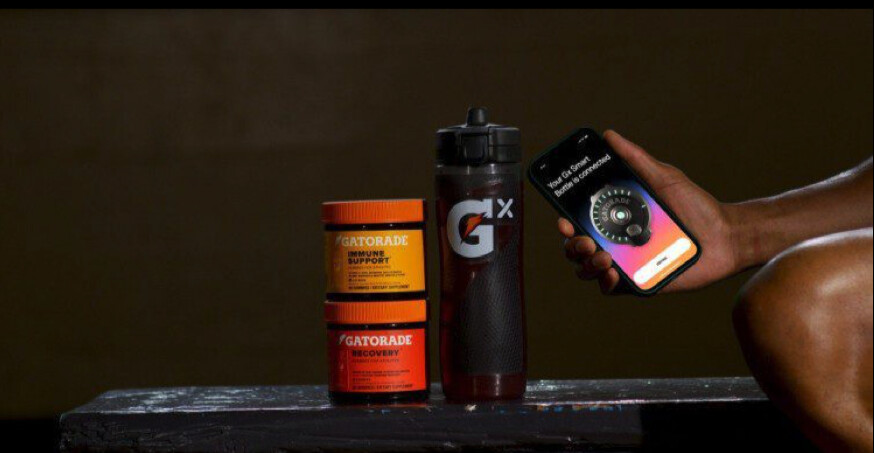

GW1516 was originally developed to treat obesity and diabetes, but is not approved for human use, due to its carcinogenic effects. It is banned both in and out of competition and is not eligible for a Therapeutic Use Exemption (TUE). A USADA bulletin from 2019 states that GW1516, also known as cardarine or endurobol, has been found in some supplements, despite being illegal.
Asinga claimed he took gummies from Gatorade that were supposed to help with recovery. He said two containers of the gummies revealed the presence of the banned substance, but the AIU panel stated he did not show proof that the gummies were the source of the drug found in his sample.
According to the AIU, Asinga claimed he took the Gatorade gummies the week before the positive test, and that subsequent testing of two unsealed containers of Gatorade gummies, provided by the athlete, revealed the presence of GW1516 and GW1516 sulfoxide. “The Disciplinary Tribunal found that Asinga did not satisfy his burden of proof to establish that the Gatorade Recovery Gummies were the source of the GW1516 metabolites detected in his sample.”
In making its decision, the AIU Disciplinary Tribunal stated that the Gatorade recovery gummies provided in unsealed containers by the athlete for testing contained significantly more GW1516 on the outside than on the inside, which practically excludes any contamination by raw ingredients during the manufacturing process. They also noted that the gummies were batch-tested by the National Sanitation Foundation (NSF), and that a sealed jar of the Gatorade recovery gummies, from the same batch taken by Asinga, tested negative for GW1516.
The 19-year-old sprinter plans to appeal the ban, which would take the case to the Court of Arbitration for Sport (CAS) in Switzerland.
All of Asinga’s results from July 18 onward will be disqualified, including his two South American Championships gold medals in the 100m and 200m, as well as his world U20 100m record of 9.89 seconds.
by Running Magazine
Login to leave a comment
Treadmill desks are becoming more popular—but do they help your running performance?
We all know that exercise has a multitude of benefits, and sitting at a desk all day can take a toll on our mental and physical health. It can be hard to get out for a run sometimes, let alone get in our daily step count. Could a treadmill desk be the answer?
Prolonged inactivity is known to increase the risk of heart disease, Type 2 diabetes and other health issues, with the adage “sitting is the new smoking” underscoring the dangers of a sedentary lifestyle. Conversely, walking as few as 4,000 steps a day has been shown to benefit both mind and body. Treadmill desks, which combine a standing desk with a treadmill, offer a potential solution to counteract sedentary office environments, The New York Times recently reported. But are they a worthwhile investment for runners?
Are they effective?

As treadmill desks become more popular, researchers are examining their efficacy. Studies, though sometimes limited in scope, indicate that treadmill desks can help people stay active, potentially adding an average of two extra miles of walking per day. A 2023 study even found that regular use of treadmill desks increased energy levels, improved mood, and in some cases, enhanced job productivity.
Akinkunle Oye-Somefun, a doctoral candidate at Toronto’s York University and lead author of a recent meta-analysis on treadmill-desk research, says that adding small amounts of activity throughout the day can accumulate. He cautions: “walking on a treadmill desk is a supplement, not a replacement for your regular exercise routine.” In other words—while a treadmill desk may boost training by enhancing your mood and adding to time spent on your feet, it’s not a replacement for your regular running routine.
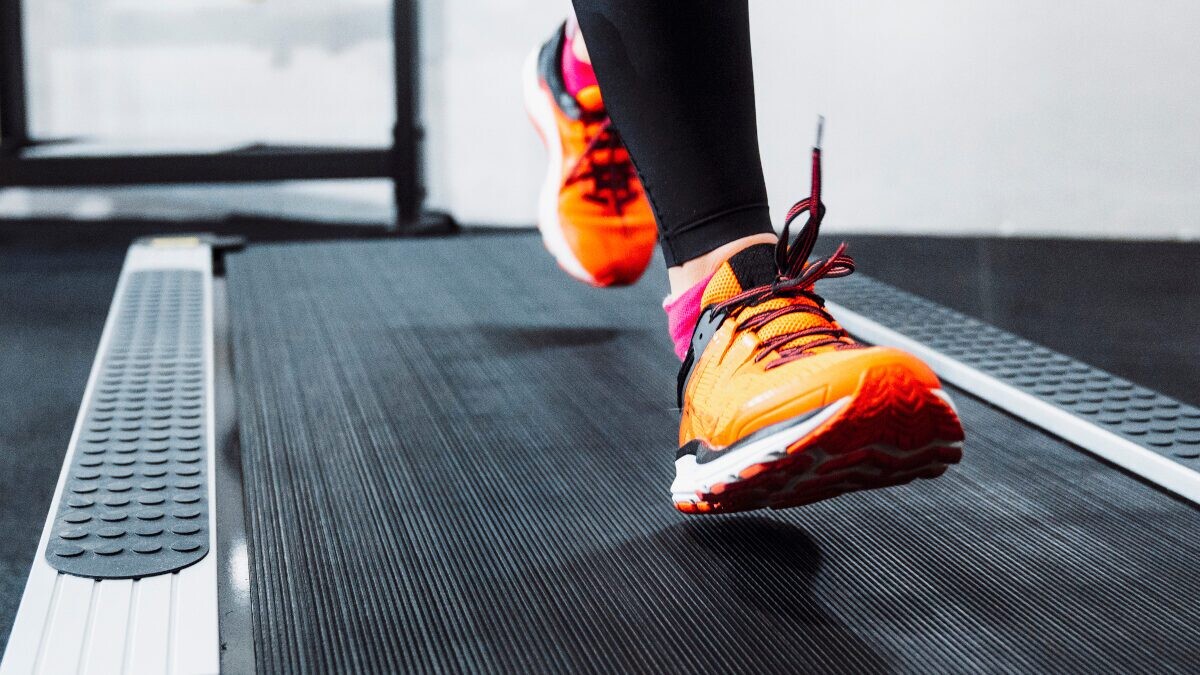
Be mindful of cost
While treadmill desks can increase daily movement, they come with potential drawbacks. Noise is a significant issue, especially with standard running treadmills—the motor and the sound of footsteps can make it difficult to concentrate, both for the user and their co-workers. Quieter models tend to be more expensive, with treadmills and walking pads running from $280 to $1,400.
Taking those Zoom meetings can be a little challenging if you’re trying to speedwalk, and fine motor skills take a hit: Jenna Scisco, an associate professor of psychology at Eastern Connecticut State University and lead author of a 2023 study on treadmill desks, found that typing becomes more challenging while walking. Despite this, she noted that the health benefits often outweigh these drawbacks.
Build a consistent routine
Let’s face it—a walking desk won’t help you race to your next PB… directly. However, building a daily routine of getting more consistent exercise will make you fitter, and you may find yourself pushing through distance and effort barriers with more ease. While adding a lunchtime walk is still a good option if you’re limited by cost or office dynamics, establishing a regular routine on a treadmill desk can be an effective way to add more movement to your day. Experts suggest starting small, with 30-minute increments, before spending longer periods of your work day moving your legs.
by Keeley Milne
Login to leave a comment
She Qualified for Boston by Doing the Majority of Her Running in Water
Running changed my life trajectory. Before I started running, I had a job as an executive in fast-food marketing. After I started, I changed my career course to focus on health and fitness. I became a certified personal trainer via the American Council on Exercise (ACE) in 2008. In 2011, I became a USA Track & Field run coach, certified Aquatic Exercise Association instructor, and then created Fluid Running as a result for my passion of water running.
I started running 5Ks and 10Ks, but then signed up for a marathon. I ran my first marathon, the Chicago Marathon, in 2001. Then in 2002, I ran the Chicago Marathon again and qualified for Boston. I was hooked. I followed Hal Higdon’s plans exclusively for my first 12 marathons that I ran between 2001 and 2009, and still reference him.
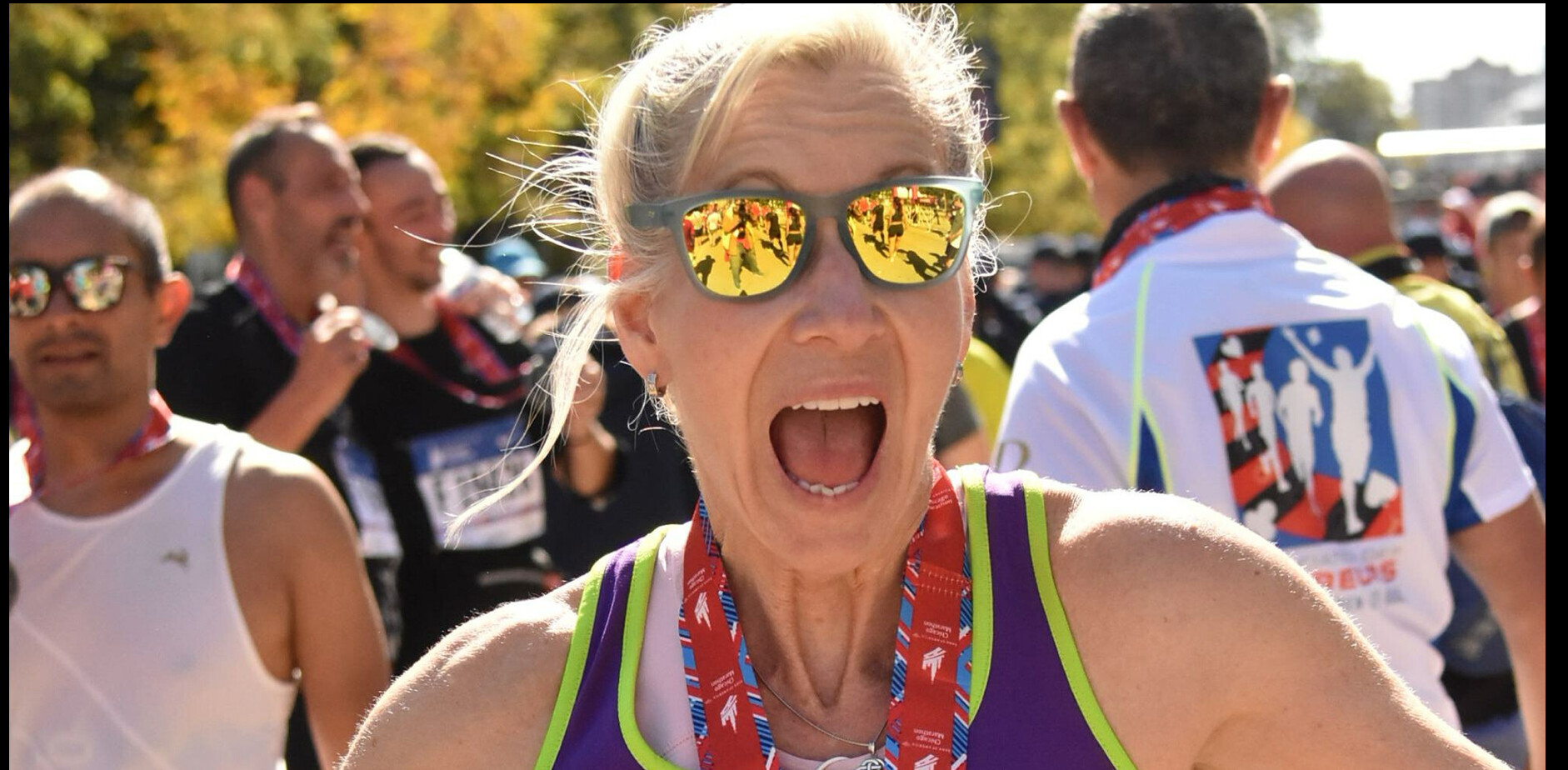
However, in 2010, I was training for the Chicago Marathon with my siblings, and raising money for the Juvenile Diabetes Foundation in honor of my nephew. Six weeks before the race, I tore my calf muscle and my doctor told me I could not run. I was devastated, yet determined.
I searched “how do you stay in running shape when you can not run,” and came across an article on aqua jogging, and contacted the author who is a running coach. His associate gave me a training plan that included five runs a week in the pool, including my 20 miler! I ran solely in the water for the final six weeks of marathon training.
After I discovered pool running in 2010, I would still reference Hagdon’s plans, but I would replace two to three of the land runs on the schedule for water runs.
For pool running, I wear a flotation belt which allows me to run as if I were on land. I am upright in the pool with my legs underneath me. I keep my head held high, shoulders pulled back, and my arms swing by my side. My legs mimic land running form but with a little more “sweepy” back and forth motion.
For the 2022 Chicago Marathon, I decided to try a Track Club Babe training plan because I liked lower mileage, and I focused on speed and slower long runs. I only did the long run and one speed work run on land. The rest I replicated in the pool, and I still qualified for Boston!
Since discovering pool running, my last six marathons have been a combination of about 50 percent pool and 50 percent pavement.
This was my “aha” moment, and I wanted to share my journey, so I created Fluid Running in 2011. A huge benefit is that there is absolutely no impact on the body, so you can do it with many common injuries.
In my recent training for the 2024 Boston Marathon, I did two or three land runs per week (which includes a speed session and the long run), the rest of my running in the water.
I honestly don’t know what I would do without running in my life! It’s my moving meditation. I started dating my husband through running, made many friends, and ultimately created Fluid Running because of it.
These tips have made my running journey a success:
1. Strength train
I’m a huge fan of strength training, especially as we age. I do two sessions a week focusing on my leg muscles and core. I do a lot of single-leg exercises. I know this has played a huge role in keeping me strong, especially toward the end of marathons.
2. Adopt positive self talk
I’m a big believer in positive self-talk. I talk to myself constantly during my runs. One of my mantras that I will say over and over when I run is “strong legs, strong mind, strong body.” “Yes you can” is another one I say often.
3. Learn from your setbacks
I’ve had some setbacks, like all runners. Setbacks, though, are when I ultimately become better and stronger. Setbacks allow me to reflect, and they make me realize just how much I love and need running in my life! Setbacks are temporary, so don’t stress out about them.
Jennifer’s Must-Have Gear
→ SPI Belt: I love it because it’s comfortable and holds so much—my phone, my airpods, gum, and a gel!
→ Power Plate Vibrating Roller: I love it because it gets so deep and feels so good. I try to use it both before and after my runs.
→ Goodr Sunglasses: I love them because they are light, cute, and they make everything look deeper in color. The sky is so blue when I wear them!
Login to leave a comment
Plant-based perfection: super snacks for runners
These nutritious and easy-to-make snacks are perfect grab-and-go fuel for busy days.
Whether you already enjoy a plant-based diet, are curious about trying more plant-based nutrition or are simply looking for some fast, healthy snacks for pre or post-run, we’ve got you covered. Runners can successfully fuel with a variety of different styles of eating, but plant-based nutrition is becoming more popular among elite athletes and regular runners—the shift in eating is credited with lowering inflammation levels, improving cardiovascular health and preventing diseases like Type 2 diabetes. Here are a few delicious recipes to fuel your next run.
Sweet Potato and Oat Muffins

Enjoy these delicious sweet potato and oat muffins as a nutritious snack before or after (or during) your run. Store any leftovers in an airtight container at room temperature for up to three days, or store in the freezer.
Ingredients
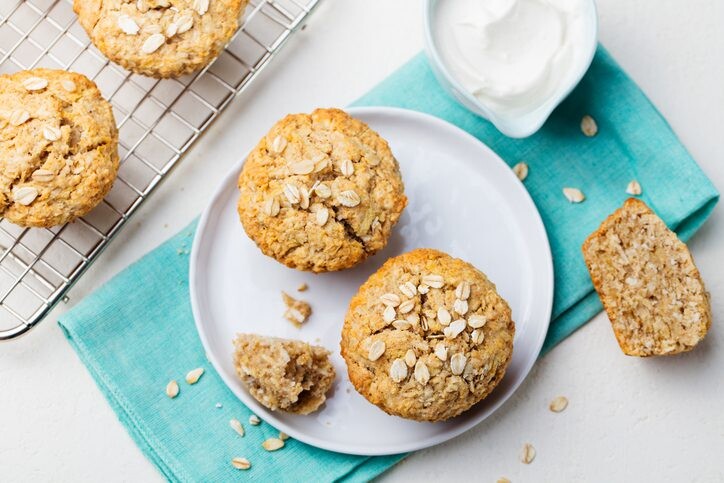
1 cup mashed sweet potato (about 2 medium sweet potatoes, cooked and mashed)1/4 cup unsweetened applesauce1/4 cup maple syrup or agave nectar1/4 cup almond milk (or any plant-based milk)1 tsp vanilla extract1 cup whole wheat flour1 cup rolled oats1 tsp baking powder1/2 tsp baking soda1 tsp ground cinnamon1/4 tsp ground nutmeg1/4 tsp saltOptional: 1/4 cup chopped nuts or seeds for added texture
Directions
Preheat your oven to 375 F (190 C) and grease a muffin tin or line with paper liners. In a large mixing bowl, combine mashed sweet potato, applesauce, maple syrup, almond milk and vanilla extract. Mix until smooth.
In a separate bowl, whisk together whole wheat flour, rolled oats, baking powder, baking soda, cinnamon, nutmeg and salt.
Gradually add the dry ingredients to the wet ingredients, stirring until just combined. Be careful not to overmix. If using, fold in chopped nuts or seeds. Spoon the batter into the prepared muffin tin, filling each cup about 3/4 full.
Bake for 20-25 minutes or until a toothpick inserted into the centre comes out clean. Allow the muffins to cool in the tin for a few minutes, then transfer to a wire rack to cool completely.
Scott Jurek’s Rice Balls (Onigiri)
These are a favourite of ultrarunning legend Scott Jurek, from his book Eat & Run.
Ingredients
2 cups sushi rice4 cups water2 teaspoons miso3–4 sheets nori seaweed
Directions
Cook the rice in the water on the stovetop or using a rice cooker. Set aside to cool.
Fill a small bowl with water, and wet both hands so the rice does not stick. Using your hands, form ¼ cup rice into a triangle. Spread ¼ teaspoon miso evenly on one side of the triangle. Cover with another ¼ cup rice.
Shape into one triangle, making sure the miso is covered with rice. Fold the nori sheets in half and then tear them apart. Using half of one sheet, wrap the rice triangle in nori, making sure to completely cover the rice.
Repeat using the remaining rice, miso and nori.
Chickpea flour mini quiches
Enjoy these tasty protein-packed mini quiches warm, or wrap them up and eat them on the go.
Ingredients
1 cup chickpea flour1 cup unsweetened almond milk1/2 cup diced vegetables (spinach, bell peppers, onions, mushrooms, etc.)1/4 cup nutritional yeast1 tsp baking powderSalt and pepper to taste
Directions
Preheat your oven to 375 F (190 C) and grease a mini muffin tin. In a bowl, whisk together the chickpea flour, almond milk, nutritional yeast, baking powder, salt and pepper until smooth.
Stir in diced vegetables, and pour the batter into the prepared muffin tin, filling each cup about 3/4 full.
Bake for 15-20 minutes or until the edges are golden brown and the tops are set. Let cool slightly before removing from the tin. Enjoy warm or at room temperature for a protein-packed snack on the go.
by Keeley Milne
Login to leave a comment
Five foods to supercharge your running performance
Winter is the perfect time to introduce these nutrient-dense superfoods into your diet. From supporting immune function to providing sustained energy in the face of brisk temperatures, these foods will not only fortify you against the season’s demands, but will also help you lay the foundation for a resilient and powerful season. Try these simple and delicious recipes to elevate your nutrition and better fuel your runs.
1.- Quinoa
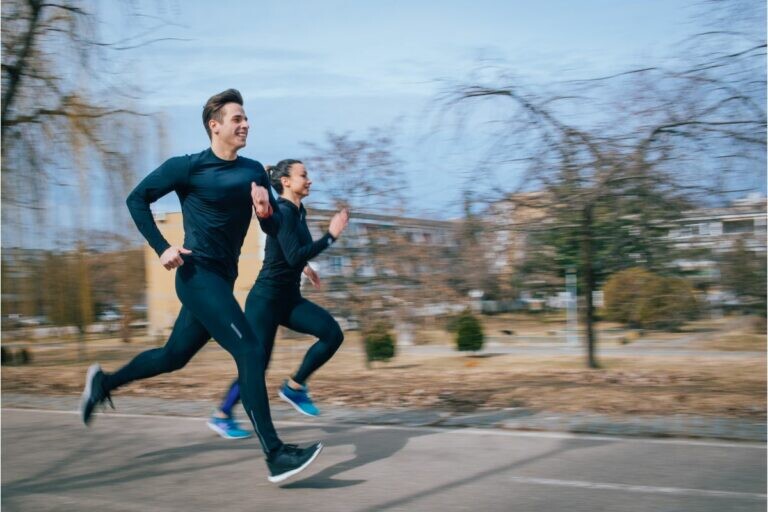
Why it’s a superfood: Quinoa is a complete protein source, containing all nine essential amino acids crucial for muscle repair and recovery. The grain is also packed with magnesium, an often under-consumed mineral that is linked to reduced risk of Type 2 diabetes.
Try: Quinoa Salad with Avocado and Chickpeas
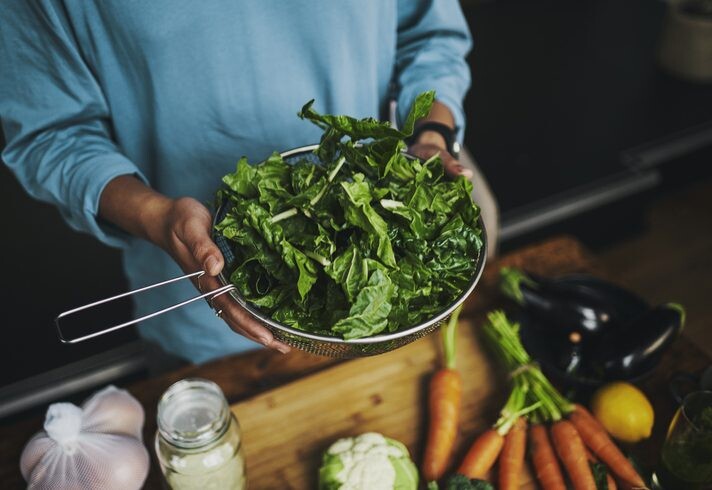
Toss cooked quinoa, diced avocado, canned chickpeas (rinsed and drained), cherry tomatoes, cucumber and feta cheese in a bowl, drizzle with olive oil and lemon juice and season with salt and pepper for a protein-packed and nutrient-rich salad.
2.- Chia seeds
Why they’re a superfood: Chia seeds absorb water to aid in hydration during long runs and are rich in healthy Omega-3 fatty acids. The antioxidants in the seeds are thought to help reduce the inflammation that takes place when muscles suffer micro-tears.
Try: Chia Seed Pudding with Berries
Mix chia seeds with almond milk and vanilla extract, sweeten with honey, refrigerate overnight and top with fresh berries for a delicious pudding that can serve as breakfast or dessert.
3.- Spinach
Why it’s a superfood: Spinach is rich in iron, crucial for oxygen transport to muscles and packed with antioxidants for overall health.
Try: Spinach and Feta Stuffed Chicken Breasts
Sauté chopped spinach and garlic in olive oil, stuff mixture into sliced chicken breasts and season with salt and pepper. Bake until cooked throughout for an iron-packed and protein-rich main course.
4.- Sweet potatoes
Why they’re a superfood: Sweet potatoes provide complex carbohydrates, promote sustained energy levels and are rich in vitamins A and C for immune support. Each potato contains four grams of fat-fighting fibre, and supplies potassium, an electrolyte that helps your body convert carbohydrate to glycogen, to be used as fuel during exercise.
Try: Baked Sweet Potato Fries
Cut sweet potatoes into fry-size portions, toss with olive oil and seasonings of choice (try paprika, garlic powder and salt and pepper), and bake until crispy for a delicious and energy-boosting snack or side dish.
5.- Salmon
Why it’s a superfood: Salmon is loaded with Omega-3 fatty acids, supporting heart health, reducing inflammation and aiding in muscle recovery. It also packs a protein punch and is a great source of vitamin D.
Try: Grilled Lemon Garlic Salmon
Marinate salmon fillets in a mixture of lemon juice, minced garlic, olive oil, salt and pepper, then grill for a flavourful and nutritious pre- or post-run meal.
Incorporating these superfoods into your diet can provide the essential nutrients needed for optimal running performance while supporting endurance, recovery and overall well-being.
by Keeley Milne
Login to leave a comment
6 Running Benefits for Seniors That’ll Convince You to Lace Up Today
Research and experts explain all the advantages you gain from going for a run, including the physical and mental.
Despite what you may have been told, running has no cut-off age. You don’t have to slow down once you hit a particular milestone or switch to low-impact exercise. Running isn’t too hard on an older body, and, no, it won’t wreck your knees.
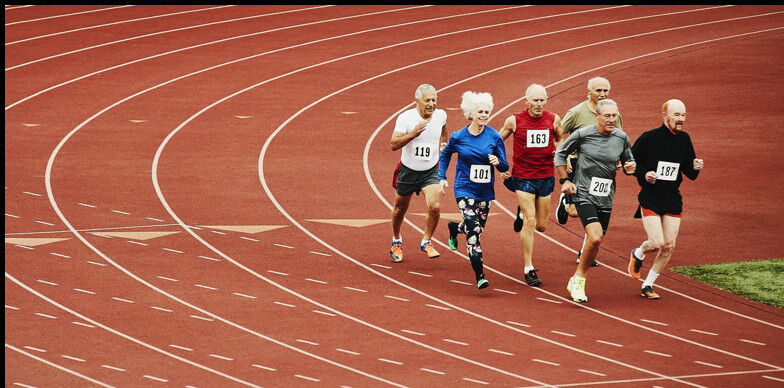
In fact, the list of running benefits for seniors spans the physical, mental, and social. To highlight some of the most compelling reasons for running well into your golden years, we asked coaches, trainers, and healthcare professionals who work with an older population for their takes. Read on to learn why some of your best miles may be ahead of you.
1. Supports Heart Health
As you age, your risk for cardiovascular disease increases as performance and health-related factors like cardiac output (or the volume of blood your heart pumps per minute), maximal oxygen uptake (a.k.a. VO2 max), and maximum heart rate wane. But research shows that exercise can help decrease your risk of heart disease—and the more active you are, the lower your risk.
“Running won’t stop the decline, and it isn’t for everyone. But done correctly and safely by engaging in a program designed specifically for seniors, it provides a way to slow and mitigate these inevitable declines,” Hiroyuki “Mike” McKnight, coach and founder of Running Workx, a program that specializes in training older adults, tells Runner’s World. “Running consistently over time with higher endurance levels makes the heart stronger and more efficient, especially for those who have been living more sedentary lifestyles during their older adult years.”
Because it’s an aerobic activity, running can improve the heart’s stroke volume (or the amount of blood pumped out of the heart with each contraction), encourage the formation of new blood vessels, and increase the number and size of mitochondria or the “powerhouse” of the cells that help you produce energy.
2. Improves Breathing Function
Lung function, which basically means how well a person breathes, peaks in your 20s and starts to decline around age 35. Combined with age-related sarcopenia (muscle loss and atrophy) of the breathing muscles, namely the diaphragm, can make breathing more difficult and render you more susceptible to respiratory infections, like the flu and pneumonia.
Research shows that moderate to high-intensity exercise, like running, may improve pulmonary function in seniors. A randomized clinical trial involving 45 people, published in Perceptual and Motor Skills, found that participants over 75 who engaged in moderate aerobic activity showed improved forced vital capacity (FVC, a marker of pulmonary health) after a 10-week exercise program. Seniors who performed high-intensity exercise for the same period of time showed improved FVC and forced expiratory volume in one second (FEV1.0, an additional pulmonary health marker). Meanwhile, the sedentary control group showed no improvements.
3. Increases Bone Density
When it comes to bone density, running is a bit of a double-edged sword. Robert Linkul, C.S.C.S., owner of Training the Older Adult, is quick to point out that the high-impact nature of running may not be advisable for deconditioned seniors with bone density issues. Doing too much too soon could lead to shin splints and other micro-fractures, he warns.
That said, an appropriately progressive training plan that slowly ramps up to running can help improve conditions like osteopenia and osteoporosis. “Ground impact is beneficial, big time,” he says. “You’re getting anywhere between three to six times your bodyweight with ground impact when you’re leaving the ground when you’re striding on a run.”
Todd Buckingham, Ph.D., professor of movement science at Grand Valley State University in Allendale, Michigan, also lists “bone strengthening” among the biggest benefits to senior runners, as it has real implications for quality of life and long-term health outcomes.
Buckingham notes that falls are among the leading causes of injury and injury death for seniors, and hip fractures are associated with elevated mortality. “Increasing the bone density of the hip can help prevent those fractures from occurring,” he says. “Running also strengthens the muscles of the lower body and helps improve balance, so you’ll be less likely to fall in the first place.”
4. Boosts Mood
A run is the ultimate mood booster, especially for older individuals who may be at greater risk for depression. “It’s hard to quantify, but in my experience on the ground, I see running providing seniors with a positive mechanism to cope with the everyday stresses of life,” McKnight says. “Whether it’s before the day starts or at the end of a tough day, there’s nothing like a good run outside to take one’s mind off things and create an environment to enjoy the moment.”
Running also creates opportunities for social interaction through running groups, clubs, coaching, and running-related events. Seniors who run may find that they have more chances to connect with others and therefore are better able to avoid isolation, which, according to a longitudinal study published by the Journal of the American Geriatrics Society, can significantly increase an individual’s risk of dementia.
5. Promotes Self-Efficacy
In her work, Colleen Brough, D.P.T., assistant professor of rehabilitation and regenerative medicine at Columbia University Irving Medical Center in New York City and director of Columbia RunLab, witnesses firsthand the physiological benefits that running can afford seniors. “We observe improved lipid profiles for those with cardiovascular disease, optimized metabolism—especially helpful for those struggling with obesity—and improved glycemic control in those new runners who have diabetes,” she says.
But what’s perhaps equally impactful is how running can improve older adults’ self-esteem and self-efficacy, or believing in one’s own capabilities. “In a world of unrealistic standards set by choreographed social media images that often disregard those of us post-40, self-efficacy is more important than ever,” Brough explains.
Running allows seniors to challenge themselves, achieve goals, and try again when they miss the mark. “Frankly, even a bad run that’s been completed provides an immediate sense of accomplishment and satisfaction along with a big dose of stress relief,” Mcknight says.
6. Extends Lifespan
Considering running’s myriad physical and mental health benefits for seniors, it’s no surprise that hitting the road (or the tread) may help you live longer and with fewer disabilities.
Case in point: According to a 2023 International Journal of Environmental Research and Public Health study, adults who spend a minimum of 75 minutes a week jogging or running have longer telomeres—which are a part of chromosomes and known to shorten with age—than those who don’t exercise. Telomeres are better predictors of biological age than chronological years, according to the research.
Also, according to the American College of Cardiology, even running one or two times a week, for a total of less than 51 minutes, fewer than six miles, and slower than 6 miles per hour was associated with a lower your risk of dying compared to those who do not run.
That also shows that if you are a lifelong athlete, you don’t have to maintain your pace or distance to benefit from running.
Safety Considerations for Senior Runners
As with runners of any age, seniors new to the sport should (once they get a doctor’s approval) start slow. “I suggest newbie runners initiate their training with a walking protocol, which more easily transitions them to a new running program,” Brough says. “Depending on initial walking tolerance, this might look like five to 10 minutes of sustained, brisk walking three to four times per week for two weeks.” She suggests gradually working up to 20 minutes before incorporating brief running intervals.
If you have the time and resources, it’s worthwhile to work with a run coach. “As little as one or two sessions can be a game-changer for people,” Linkul says. A running professional will not only help you optimize your form for performance and safety, but they can also customize a training plan that aligns with your goals, experience, and fitness level.
Finally, stay on top of your medical appointments and listen to your doctor, as there are some contraindications to running—and not just for seniors. “Definitely don’t run if you recently experienced a myocardial infarction or change in heart medication, have congestive heart failure, unstable angina, uncontrolled hypertension, or uncontrolled glycemic levels,” Brough says.
Individuals with controlled high blood pressure, a history of heart disease, or circulatory problems may benefit from running, she says, but they must be closely monitored by a healthcare professional.
by Runner’s World
Login to leave a comment
British runner training with a fridge on his back mistaken for thief
A British man training for the Guinness World Record for the fastest marathon while carrying a fridge on his back had his training interrupted by local police, who thought he was stealing the fridge.According to the BBC, Daniel Fairbrother of Stevenage, U.K., was out for a run in his hometown when a police officer pulled him over, mistaking him for a thief. Fairbrother told the BBC the police officer wound down his window and said: “You understand I’ve got to stop you, is that a fridge on your back?”
After Fairbrother explained his unique marathon challenge, he said the officer cracked a joke: “You do know if you order food, they will usually deliver it for you?”The idea to challenge the world record for the fastest marathon while carrying a fridge came to Fairbrother during a night of heavy drinking with his friend. Fairbrother, who has a half-marathon PB of an hour and 40 minutes, has to beat the previous (marathon) mark of 4:52:10, which was set by British runner Sam Hammond at the 2023 London Marathon.

Fairbrother has chosen to challenge the record at the same race. A fan of the movie Cool Runnings, he has named the portable fridge Tallulah, after the Jamaican bobsleigh in the movie. His goal is not only to break the record but to raise at least £10,000 (CAD $17,000) for Diabetes UK. At the time of writing, Fairbrother had hit 35 per cent of his goal.The cause hits close to home for Fairbrother, whose closest friend has type-1 diabetes. “I want to raise lots of money for a great cause and do my bit to ensure they can carry on with their great work,” he wrote.
According to the BBC, the police officer ended up shaking hands with Fairbrother and wished him the best for his marathon training.
by Running Magazine
Login to leave a comment
What Blood Testing Data Reveals About Runners' Health
I used to think running was a panacea. "If the furnace is hot enough, anything will burn, even Big Macs," as the fictional miler Quenton Cassidy once said. Then, about a decade ago, there was a big surge of doubt about the health effects of running. Most prominent was the suggestion that even modest amounts of running might damage your heart-"One Running Shoe in the Grave," as the Wall Street Journal put it-but running was also accused of broader sins like promoting inflammation, causing muscle loss, and wreaking havoc on blood sugar levels.
As a runner and a journalist, I spent a lot of time trying to understand these claims, and reevaluating my own understanding of running's health effects-a process that continues to this day. Part of that process involved going back to the original research that led us to believe that running is healthy. And to be honest, the evidence wasn't as clear as I'd assumed. Does running (or aerobic exercise more generally) really improve health markers, or is it just that healthy people are more likely to choose to run? Do the benefits max out after a few minutes per day, or do they keep growing? Can you outrun a bad diet?
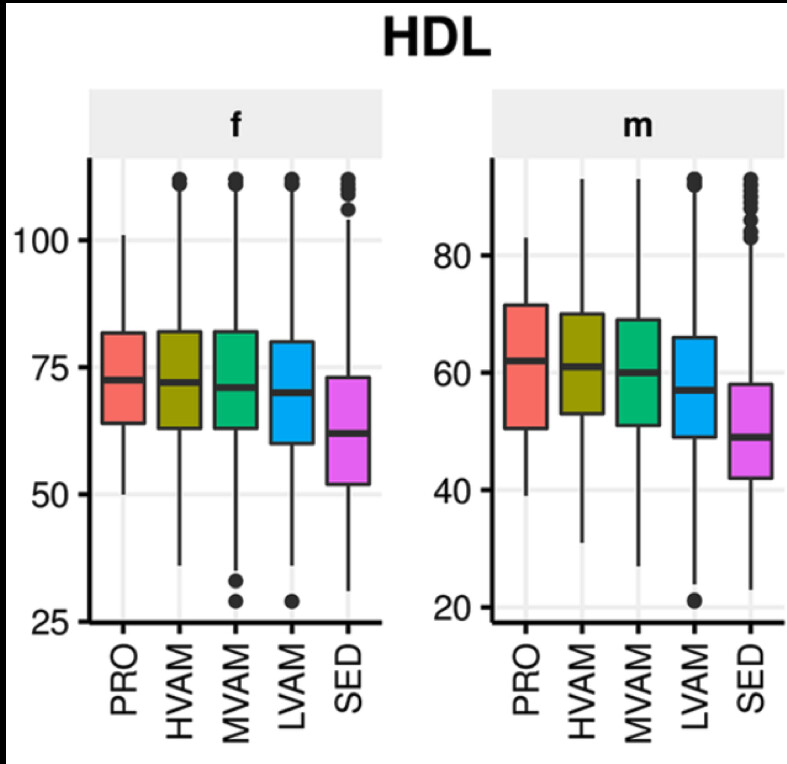
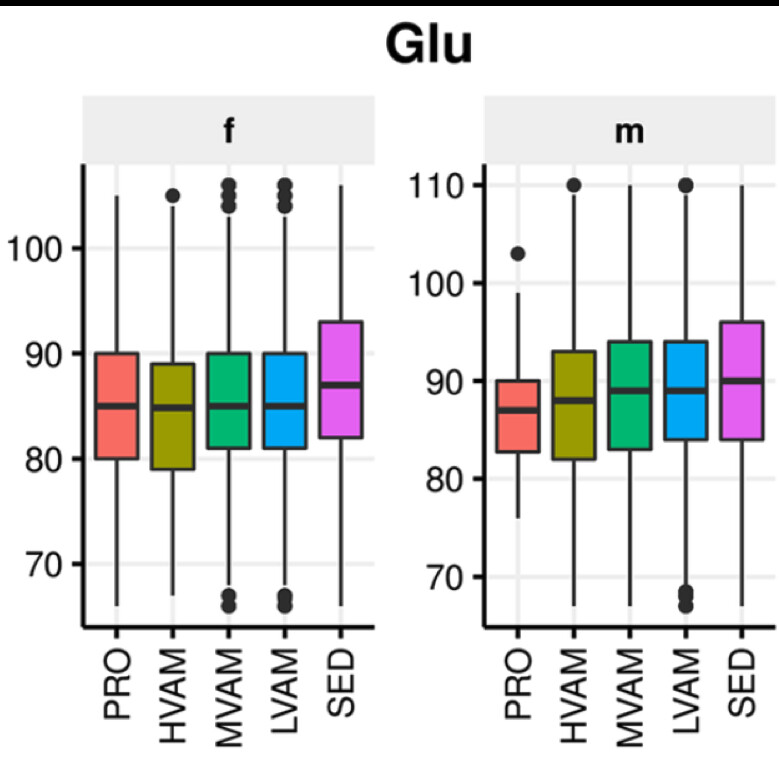
I have opinions about all these questions, but I no longer assume that the answers are obvious. So I'm always interested in new data, like a recent study in PLoS ONE from the science team at InsideTracker, a company that sells personalized blood testing to track various health biomarkers. The paper offers a peek at the aggregated results of more than 23,000 customers who report various levels of running, divided into three groups: low volume (less than three hours of running per week), medium volume (three to ten hours per week), and high volume (more than ten hours per week). For comparison, they also include results from 4,400 sedentary non-runners, and at the opposite end of the spectrum, 82 professional distance runners.
There are two important caveats to point out before diving into the data. First, this is observational data, not a randomized trial. That makes it hard to determine whether running causes any of the patterns in the data (though, as we'll see below, there are some ways to test our assumptions about causation). Second, this is a self-selected cohort. Even the sedentary group is made up of people who are interested enough in their health that they've decided to spring for a service that starts at $699 for a single battery of blood tests. Since this control group is already fairly healthy, detecting any improvements will be more challenging.
The Raw Data
The journal article (which is free to read online) presents data on 27 different biomarkers that were significantly different between runners and non-runners. I'm just going to pick out a few categories that are particularly interesting.
First, here's HDL (i.e. "good") cholesterol levels, for females (f) and males (m) in each of the five groups: pro runners, high-, medium-, and low-volume amateurs (HVAM, MVAM, and LVAM, respectively), and sedentary people.
The biggest difference is between runners and non-runners: runners have clearly higher levels, which is good. And among the runners, the trend is that more running is associated with higher levels. Similar patterns are seen for LDL ("bad") cholesterol and triglycerides: running is good, and more running is better.
The pattern here is much less pronounced. There's still a significant difference between runners and non-runners, but the dose-response effect of more mileage is smaller in men and non-existent for women. The same is true when looking at HgbA1c levels, which offer an estimate of long-term average blood sugar levels rather than a single snapshot. In that case, there's a more pronounced difference between runners and non-runners, but no dose-response response effect. For blood sugar, then, running is good but more running isn't necessarily better.
One key point: the sedentary control group has remarkably good blood sugar levels, with an average below the prediabetes cutoff. Given that 98 million Americans have prediabetes, this confirms that the control group is already pretty healthy. If you were to compare runners to the average population, you'd probably see a bigger effect.
Another group of biomarkers is associated with chronic low-grade inflammation. The pattern here is a little more complicated, but data on C-reactive protein, white blood cell count, and ferritin collectively suggest that greater volumes of running are associated with lower levels of inflammation. The fact that ferritin is considered a marker of inflammation was a surprise to me, since I think of it as an indicator of iron levels in endurance athletes. But it turns out ferritin levels can mean different things in different contexts.
For most of the biomarkers, there's a fairly smooth trend from sedentary to pro runners. But there are a few examples where the pro runners are noticeably different from everyone else, even the amateurs who claim they're running more than ten hours a week. Most notably, the pro runners tended to have low magnesium levels-an observation that mirrors earlier data from British Olympic track athletes. The British study also found that athletes with a history of tendon problems were most likely to have low magnesium levels, which suggests that it's something to watch for if you're training hard.
Is It All About BMI?
All the results I mentioned above were statistically adjusted for body-mass index, age, and sex. That's important, because there were significant differences in BMI among the groups. Here's that data:
Now, I look at this graph and think, "Yep, all else being equal, the more you run the less you weigh." This used to strike me as a painfully obvious statement. The current scientific consensus, on the other hand, is that exercise is ineffective for weight loss. And it's true that lots of studies have assigned people to exercise, sometimes quite vigorously, and have seen underwhelming results for weight loss. This is a complex topic whose nuances I'll leave for another day, but suffice to say that the new data agrees with my feeling that, if you're running more than an hour a day, you very likely weigh less than you would if you weren't running.
You can get another level of insight by adding in some of the genetic data that InsideTracker also collects from some of its customers. There are a large number of separate gene variants that are associated with higher BMI; by checking which of these variants a given individual has, the researchers calculated a "polygenic risk score" for obesity. In the sedentary group, those with higher risk scores tended to have higher BMI. Among the high-volume and pro runners, in contrast, that trend was flattened: those with higher risk scores had similar BMI to those with lower scores. Though the sample size was too small to draw definitive conclusions (since relatively few customers opted to get genetic testing), the results suggest that running counteracted the gene variants associated with obesity.
The BMI data raises another important question: are all the other apparent health benefits of running just secondary effects of lower BMI? Here they use a cool technique called Mendelian randomization (which I wrote about in another context earlier this year). It's a way of turning a large observational study into a randomized trial. The randomization occurs at birth: as noted above, some people have gene variants that predispose them to have a higher BMI. These variants are randomly distributed, so if people with the low-BMI versions tend to also have better cholesterol scores (for example) regardless of whether or not they run, it suggests that BMI is what's driving the cholesterol scores.
The results of the Mendelian randomization-again limited by low sample numbers-are somewhere in the middle. It does appear that BMI explains much of the group's difference in cholesterol and inflammation levels, for example-but not all of it. For example, gene variants didn't predict LDL levels, suggesting that it's an independent effect of running.
But the closer you look, the blurrier the line between genes and behavior gets. Some of the genes associated with exercise are also associated with motivation and self-control; people who exercise a lot are also more highly motivated to eat healthily; and so on. We're back to the challenge I mentioned at the top: teasing out the independent health effects of going for a run is really hard. The InsideTracker researchers conclude that "a holistic wellness lifestyle approach is in practice the most likely to be most effective toward preventing cardiometabolic disease." That borders on tautological, but their data adds another small brick to the pile of evidence suggesting that endurance exercise, even or perhaps especially in large quantities, is a useful part of that holistic wellness lifestyle.
by Trail Runner Magazine
Login to leave a comment
What Blood Testing Data Reveals About Runners' Health
I used to think running was a panacea. "If the furnace is hot enough, anything will burn, even Big Macs," as the fictional miler Quenton Cassidy once said. Then, about a decade ago, there was a big surge of doubt about the health effects of running. Most prominent was the suggestion that even modest amounts of running might damage your heart-"One Running Shoe in the Grave," as the Wall Street Journal put it-but running was also accused of broader sins like promoting inflammation, causing muscle loss, and wreaking havoc on blood sugar levels.
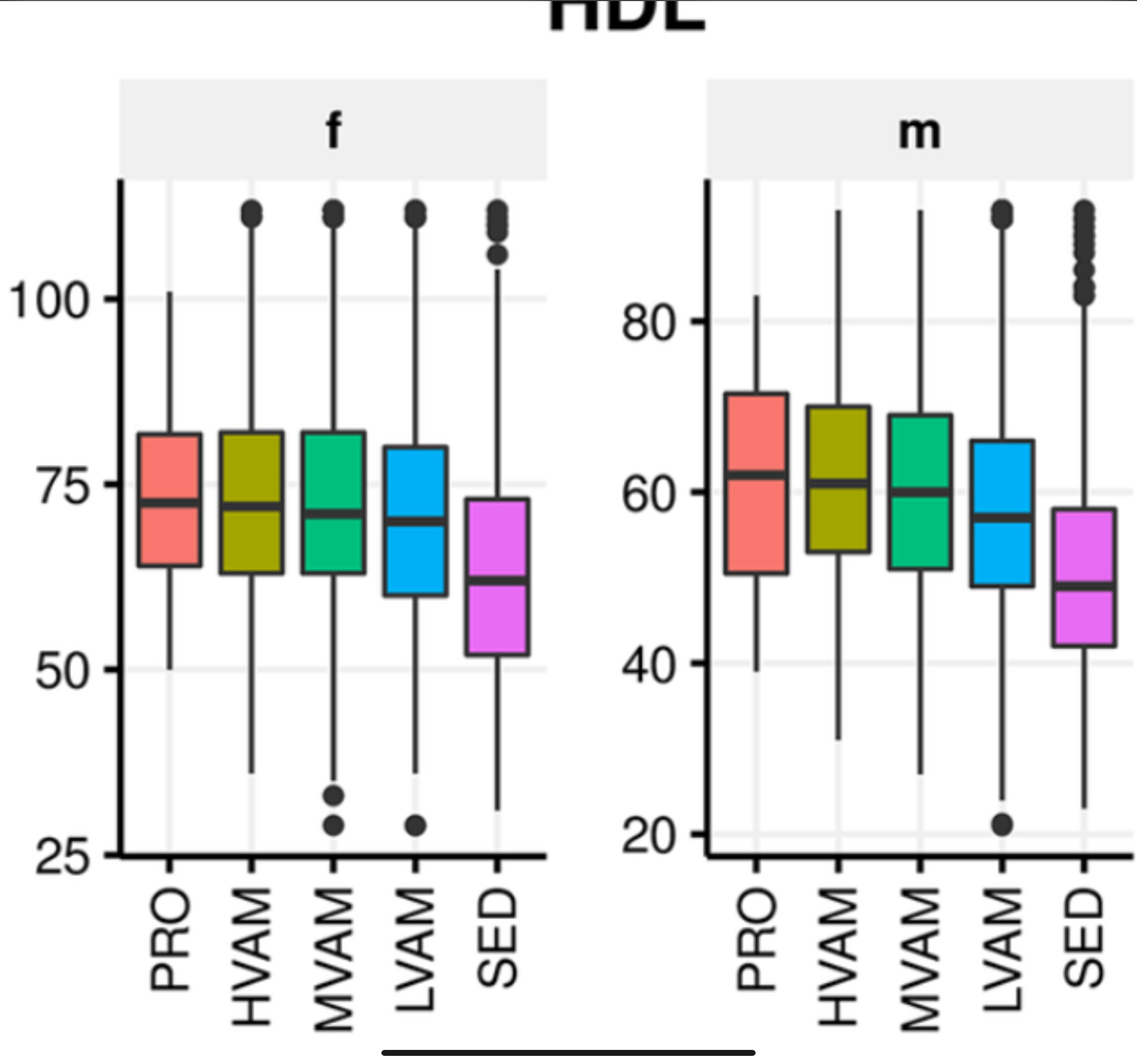

As a runner and a journalist, I spent a lot of time trying to understand these claims, and reevaluating my own understanding of running's health effects-a process that continues to this day. Part of that process involved going back to the original research that led us to believe that running is healthy. And to be honest, the evidence wasn't as clear as I'd assumed. Does running (or aerobic exercise more generally) really improve health markers, or is it just that healthy people are more likely to choose to run? Do the benefits max out after a few minutes per day, or do they keep growing? Can you outrun a bad diet?
I have opinions about all these questions, but I no longer assume that the answers are obvious. So I'm always interested in new data, like a recent study in PLoS ONE from the science team at InsideTracker, a company that sells personalized blood testing to track various health biomarkers. The paper offers a peek at the aggregated results of more than 23,000 customers who report various levels of running, divided into three groups: low volume (less than three hours of running per week), medium volume (three to ten hours per week), and high volume (more than ten hours per week). For comparison, they also include results from 4,400 sedentary non-runners, and at the opposite end of the spectrum, 82 professional distance runners.
There are two important caveats to point out before diving into the data. First, this is observational data, not a randomized trial. That makes it hard to determine whether running causes any of the patterns in the data (though, as we'll see below, there are some ways to test our assumptions about causation). Second, this is a self-selected cohort. Even the sedentary group is made up of people who are interested enough in their health that they've decided to spring for a service that starts at $699 for a single battery of blood tests. Since this control group is already fairly healthy, detecting any improvements will be more challenging.
The Raw Data
The journal article (which is free to read online) presents data on 27 different biomarkers that were significantly different between runners and non-runners. I'm just going to pick out a few categories that are particularly interesting.
First, here's HDL (i.e. "good") cholesterol levels, for females (f) and males (m) in each of the five groups: pro runners, high-, medium-, and low-volume amateurs (HVAM, MVAM, and LVAM, respectively), and sedentary people.
The biggest difference is between runners and non-runners: runners have clearly higher levels, which is good. And among the runners, the trend is that more running is associated with higher levels. Similar patterns are seen for LDL ("bad") cholesterol and triglycerides: running is good, and more running is better.
Here are the fasting glucose (i.e. blood sugar) levels:
The pattern here is much less pronounced. There's still a significant difference between runners and non-runners, but the dose-response effect of more mileage is smaller in men and non-existent for women. The same is true when looking at HgbA1c levels, which offer an estimate of long-term average blood sugar levels rather than a single snapshot. In that case, there's a more pronounced difference between runners and non-runners, but no dose-response response effect. For blood sugar, then, running is good but more running isn't necessarily better.
One key point: the sedentary control group has remarkably good blood sugar levels, with an average below the prediabetes cutoff. Given that 98 million Americans have prediabetes, this confirms that the control group is already pretty healthy. If you were to compare runners to the average population, you'd probably see a bigger effect.
Another group of biomarkers is associated with chronic low-grade inflammation. The pattern here is a little more complicated, but data on C-reactive protein, white blood cell count, and ferritin collectively suggest that greater volumes of running are associated with lower levels of inflammation. The fact that ferritin is considered a marker of inflammation was a surprise to me, since I think of it as an indicator of iron levels in endurance athletes. But it turns out ferritin levels can mean different things in different contexts.
For most of the biomarkers, there's a fairly smooth trend from sedentary to pro runners. But there are a few examples where the pro runners are noticeably different from everyone else, even the amateurs who claim they're running more than ten hours a week. Most notably, the pro runners tended to have low magnesium levels-an observation that mirrors earlier data from British Olympic track athletes. The British study also found that athletes with a history of tendon problems were most likely to have low magnesium levels, which suggests that it's something to watch for if you're training hard.
Is It All About BMI?
All the results I mentioned above were statistically adjusted for body-mass index, age, and sex. That's important, because there were significant differences in BMI among the groups. Here's that data:
Now, I look at this graph and think, "Yep, all else being equal, the more you run the less you weigh." This used to strike me as a painfully obvious statement. The current scientific consensus, on the other hand, is that exercise is ineffective for weight loss. And it's true that lots of studies have assigned people to exercise, sometimes quite vigorously, and have seen underwhelming results for weight loss. This is a complex topic whose nuances I'll leave for another day, but suffice to say that the new data agrees with my feeling that, if you're running more than an hour a day, you very likely weigh less than you would if you weren't running.
You can get another level of insight by adding in some of the genetic data that InsideTracker also collects from some of its customers. There are a large number of separate gene variants that are associated with higher BMI; by checking which of these variants a given individual has, the researchers calculated a "polygenic risk score" for obesity. In the sedentary group, those with higher risk scores tended to have higher BMI. Among the high-volume and pro runners, in contrast, that trend was flattened: those with higher risk scores had similar BMI to those with lower scores. Though the sample size was too small to draw definitive conclusions (since relatively few customers opted to get genetic testing), the results suggest that running counteracted the gene variants associated with obesity.
The BMI data raises another important question: are all the other apparent health benefits of running just secondary effects of lower BMI? Here they use a cool technique called Mendelian randomization (which I wrote about in another context earlier this year). It's a way of turning a large observational study into a randomized trial. The randomization occurs at birth: as noted above, some people have gene variants that predispose them to have a higher BMI. These variants are randomly distributed, so if people with the low-BMI versions tend to also have better cholesterol scores (for example) regardless of whether or not they run, it suggests that BMI is what's driving the cholesterol scores.
The results of the Mendelian randomization-again limited by low sample numbers-are somewhere in the middle. It does appear that BMI explains much of the group's difference in cholesterol and inflammation levels, for example-but not all of it. For example, gene variants didn't predict LDL levels, suggesting that it's an independent effect of running.
But the closer you look, the blurrier the line between genes and behavior gets. Some of the genes associated with exercise are also associated with motivation and self-control; people who exercise a lot are also more highly motivated to eat healthily; and so on. We're back to the challenge I mentioned at the top: teasing out the independent health effects of going for a run is really hard. The InsideTracker researchers conclude that "a holistic wellness lifestyle approach is in practice the most likely to be most effective toward preventing cardiometabolic disease." That borders on tautological, but their data adds another small brick to the pile of evidence suggesting that endurance exercise, even or perhaps especially in large quantities, is a useful part of that holistic wellness lifestyle.
Login to leave a comment
The Wild, Uncertain Science of Post-Exercise Ketones
A new review study points toward post-exercise ketone supplementation as a way to improve adaptation and performance. What does the uncertain science mean for endurance athletes?
I heard about athletes supplementing with ketones sometime in the mid-2010s. A company reached out, promising the next big breakthrough in endurance performance from this liquid supplement composed of a molecule naturally produced in the body from the breakdown of free fatty acids. They told me that the top cyclists in the world were already using ketones and that it was destined to take over running, too. They sent a few boxes…and they collected dust in the pantry. It felt like a biohack, and I wasn’t comfortable with it.

Over the years, more studies on ketone ingestion emerged, and I started to get more and more intrigued. Rumors came out that about 70 percent of the cycling peloton used the stuff. But they cost a ton, and it was hard to discern what was actual practice and what was just marketing.
It wasn’t until 2023, though, that I embraced that ketones were here to stay, whether I liked it or not. A 2023 study in the American Journal of Physiology-Endocrine and Metabolism had nine men complete two cycling trials, both with one hour consisting of two minutes at 90 percent of aerobic capacity (moderately hard), followed by two minutes at 50 percent of aerobic capacity (very easy). In both trials, the cyclists consumed a carb-protein drink immediately after exercise and at one, two, and three hours later. Here’s the study intervention: in just one trial, participants ingested 0.29 g/kg ketone monoester immediately after exercise and at one and two hours later.
The ketone trial led to 20 percent higher levels of natural erythropoietin (EPO) in the bloodstream.
For comparison, a 2005 study in the British Journal of Sports Medicine found that the initial exposure to altitude training increased EPO by an average of around 50 percent in swimmers, with large individual variability (returning to baseline after a couple of weeks of altitude training), with lots of variation across studies. Given that our bodies produce EPO to increase red blood cell production, and red blood cells transport oxygen that power endurance performance, the ketone study indicated that we could be seeing a supplement that supercharges adaptation and performance.
Context for Ketones
To be 100 percent honest, I was sad when I saw this study. I love performance physiology, but I don’t want to think about a new biohack. Maybe it’s a sign that I’m getting old when a study on cutting-edge science just makes me tired. Get these research protocols off my lawn!
But I also couldn’t bury my head in the sand (though that would probably increase EPO concentrations via hypoxia). Instead of giving into my old-coach fatigue, maybe I can help publicize the emerging science so fewer athletes have an information disadvantage. My final push was last week when a fantastic review article was published in the American Journal of Physiology-Cell Physiology by Ruben Robberechts and Chiel Poffé. If ketone supplementation has the potential that some think it may, the article could be a key step in the future of exercise physiology.
Before getting to the science, I think it’s important to lay out the stakes. Based on the articles (mixed with a heaping dose of gossip), I can see three different scenarios unfolding over the next 10 years.
One, post-exercise ketones don’t live up to their promise, and this is all a nothingburger. That outcome would please me the most, and we all know that what’s most important in science is my pleasure. If researchers did this type of theoretical analysis on other interventions (i.e. heat training, Vitamin D, lifting, ashwagandha, strides, beta-alanine, doubles, creatine), they could come back with similar findings. We are only talking about a few intervention studies and lots of theory, and future research could have different results. Plus, some critics would already be confident making their judgments as the Supreme Court of Nothingburgerland.
Two, ketones could become a more commonly used supplement with benefits for performance and health (like iron). They are expensive, which isn’t great, but maybe they will help athletes be healthier and faster, with limited side effects. On the flip side, maybe more research indicates tradeoffs that lead to benefit:risk calculations with performance or health. Over email, Dr. Poffé–an author of the review study and a key researcher in this field–says that “studies have shown divergent effects on performance depending on the exercise context and whether you take them before, during or after exercise.” Even if they are beneficial in some contexts, it’s not a simple equation of take ketones = get faster.
The third possibility is that they are banned as an illegal performance enhancer. I have no inside info on whether that’s a possibility, and at first blush, it doesn’t seem likely without some health risks. Dr. Poffé says “I honestly don’t see much of a reason to ban ketones while allowing other ergogenic supplements.”
So, yeah, we’re talking about a wide range of possibilities, which makes sense given the uncertain mechanisms and effects at play. Let’s dig in. (We got even deeper into the nuance on our podcast this week, which you can listen to here.)
Introduction to Ketones
As stated by the review study, ketone bodies “are molecules that are continuously produced from the breakdown of free fatty acids,” primarily in the liver. Ketone body production is upregulated during periods of low carbohydrate availability—that’s why you have heard “ketosis” thrown around for ultrarunners who practice low carbohydrate, high-fat nutrition, aiming to improve fat oxidation and avoid bonking. Ketosis via nutritional interventions comes with way too many downsides for endurance athletes, though, including everything from reduced bone density to diminished high-intensity performance. That makes sense intuitively because low carbohydrate availability is extremely stressful on most body functions, especially the endocrine system.
Ketone esters, enter stage left. Researchers figured out how to create an ester bond between a ketone body precursor and a ketone body (first in 1978 in rats, but not undergoing human testing until 2012). These ketone esters cause a “rapid and transient increase in ketone bodies,” possibly inducing ketosis. It was as if this evolutionary mechanism honed over millions of years now had a dimmer switch. For the chemistry nerds out there, you can probably guess what oral ingestion of an ester is like—not fun. Companies like HVMN honed the taste over time, and now I’d say that ketone esters taste like a robot’s ass. We can only imagine what they tasted like before.
Ketones have mostly been marketed as a before-and-during-exercise supplement, at least in the podcast ads I have heard. Take ketones, burn more fat at higher intensities, win the Tour de France, etc. However, a bunch of studies have shown limited to no acute benefit. For example, a 2017 study in Frontiers of Physiology found that pre-exercise ketone supplementation caused around a two percent performance decrease in 10 male professional cyclists doing a 50-minute time trial.
Perhaps there’s some protocol being used in the cycling peloton that improves acute performance, as the marketing claims indicate. Heck, Tom Evans reportedly took ketone esters on his way to winning Western States, so there must be some benefit for some athletes (or at least neutral impacts), possibly related to perceived effort. Anecdotally, when I tried ketones on a fatigued long run, the lights went out. Thankfully, I had my phone to call the Wuber (when my wife Megan drives to pick me up).
So perhaps it’s something else. Maybe all this ketone hype is because taking them improves recovery and hematological variables, confounding variables that are actually the driving force behind their use (maybe that even explains some of the success stories behind low carb, high fat nutrition approaches. I’d love to see the blood work!).
According to the review, after exercise, circulating ketone bodies are increased. However, any benefits athletes may see from a sustained increase are blunted in advanced athletes practicing good recovery nutrition. Ketone esters “may induce a unique physiological milieu to enhance post-exercise recovery and exercise adaptation as it allows to benefit from the potential beneficial effect of post-exercise ketosis in combination with other nutritional exercise recovery strategies (e.g., carbohydrate-protein recovery drink).” They had me at physiological milieu. Dr. Poffé says that his lab started ketone work in 2016 when “there was already some preliminary data showing that it could help riders during the Tour de France as a recovery aid.”
Mechanisms of Post-Exercise Ketones
I can’t emphasize enough how great this review article is, summarizing extremely uncertain science and studies. Before getting to the EPO mechanisms, let’s briefly touch on a bunch of other considerations. First, ketone bodies may cause epigenetic changes. For example, histone lysine β-hydroxybutylation could increase with ketone body increases, which may “increase transcription of genes involved in the adaptive response to exercise.” Across several different epigenetic mechanisms, it’s possible that ketone bodies could be a signal to the body to adapt to stimuli (which makes sense given their evolutionary role in exercise in energy-limited environments).
Second, ketones could “enhance the restoration of cellular energy status after exercise” while also blunting AMPK phosphorylation, which could enhance recovery due to its role in cellular stress or decrease adaptation due to its role in mitochondrial biogenesis. I love this one because that maybe-good, maybe-bad uncertainty regarding downregulation of AMPK points out just how little is known about the long-term consequences of post-exercise ketones, particularly in conjunction with other impacts.
Third, ketones alter g-receptor signaling, which “mediate cellular responses to a wide variety of external agents.” Fourth, ketones show anti-inflammation and anti-oxidation properties, which seems good at first glance but could theoretically cause long-term reductions in training adaptations since the inflammation response can spur adaptation. Fifth, ketones may influence neurotransmitter concentrations in the brain, which could profoundly impact perceived exertion (and possibly even mental health, though that’s a topic for another day).
The next cohort of potential adaptations are at the cutting edge of science but still theoretical. Ketones could increase muscle glycogen resynthesis, reduce protein degradation and enhance protein synthesis, spur angiogenesis that leads to more capillaries to supply blood to working muscles, induce favorable changes in muscle mitochondria, and improve sleep quality in athletes who are training hard. You can put those variables together with a 2019 study in the Journal of Physiology, where male athletes completed a three-week overload training block with six days a week of two-a-day training sessions, with one group having post-exercise ketones. That study found higher tolerated training load in the ketone group and improved performance. (The study was the subject of a Letter to the Editor disputing some of the conclusions.)
A 2023 study looked at a similar three-week overload block, validating the findings. They had 18 male athletes complete 10 training sessions per week, with one group taking post-exercise and pre-sleep ketones and the other taking a placebo. The ketone group “increased the number of capillary contacts and the capillary-to-fibre perimeter exchange index by 44 percent and 42 percent,” plus “substantially increased vascular endothelial growth factor and endothelial nitric oxide synthase expression both at the protein and at the mRNA level.” And the money finding: EPO concentrations in the ketone group increased by 26 percent. That study was eye-opening for the possible recovery and adaptation benefits of ketones, and it brings us back to the elephant in the room: potential hematological changes from increased EPO production.
Hematological Changes
In 2018, a study in the Diabetes Care journal found increasing levels of EPO after a ketone body infusion. The authors of the 2023 study that started this article cited this study as part of the impetus for their investigation (read their amazing summary here). We’re seeing similar findings in athletes in the 2023 studies, which found 20 percent and 26 percent increases in EPO production in the ketone groups relative to controls. But the science is not there to make a definitive conclusion.
In the title of this article, I promised uncertain science, and now we are deep in it. First, we don’t know how much this EPO change may impact performance. “Currently,” the review says, “it has not been identified if the observed changes in EPO post-exercise are indeed sufficient to induce an improvement in hemoglobin mass and oxygen transport capacity in humans, and whether these effects are additive to stimuli that are frequently used by athletes to increases EPO such as hypoxia.” It’s possible that these changes don’t correspond to performance benefits.
And get a load of this: “The precise physiological mechanism underlying ketone body-induced upregulation of EPO is currently unknown.” However, based on mouse models, the researchers theorize that it relates to H39K acetylation in kidney cells.
Are Ketones the Future?
There are tons of unanswered questions. How do these types of adaptations change over time? The longest study right now is a few weeks.
Do the processes change in female athletes? That’s one of my big concerns in making any recommendations since metabolic processes can vary based on gender. While more research is needed, Dr. Poffé indicates that past studies likely show that the results can be extrapolated to female athletes. “In a recent, unpublished study,” he says, “we observed that some effects are even more pronounced in females.”
How about aging athletes? Athletes of different levels, with different goals and backgrounds? What’s the right dosage and timing? Would the same responses happen at altitude? Should consumption be periodized? With similar studies, would other interventions lead to similar findings? Should ketones be banned altogether?
I don’t know the answers to those questions, and a lot more studies are needed before I make coaching recommendations other than “be careful” and “keep it simple.”
“Similar to most nutritional supplements,” Dr. Poffé says, “the long term effects (e.g. what occurs if you supplement for multiple years) are not known.” When athletes take ketones, he says instead of taking them chronically, to supplement “during periods of limited recovery opportunities,” like training camps. From a performance perspective, he advises to consider ketones when everything else is sorted out around training, nutrition, and recovery. They are “the final step,” not the first one.
In September, after reading the research, I dusted off that old package of ketones and opened up a serving for myself. Then I threw it in the trash because it seemed like a health hazard after all those years. I ordered a new package and started experimenting with them a couple days a week post-exercise. In October, at the Blue Sky Marathon, I closed the final four miles two minutes faster than last year to set a course record.
That probably had nothing to do with ketones, right? I’m no Olympian, but I train hard. And when looking back on the race and why I could finish so fast while feeling so good, I would be burying my head in the sand not to consider one of the only variables that changed.
I’m not sure what the future holds with post-exercise ketone supplementation. Maybe it’s all snake oil and placebo, with some studies that find physiological anomalies without a demonstration that it fundamentally alters performance trajectories, destined to be covering dust in the pantry of exercise physiology history.
Or maybe we’re seeing the dawn of a revolution in endurance training and performance.
by David Roche (Trail Runner Magazine)
Login to leave a comment
What Will Health and Fitness Look Like in 2024? We Asked Some Experts.
Adults will take recreational cues from their children, “unprocessed” will become a marketing asset, and rodents will show us the way to eternal life.
It’s almost a wrap for 2023, which means it’s time for our annual list of fitness predictions for the coming year. As in the past, we reached out to several experts to ask what we should expect for 2024. Beyond forecasting a specific food fad or workout craze, these predictions are often about identifying a subtle shift in the zeitgeist when it comes to how we think about what it means to live well.
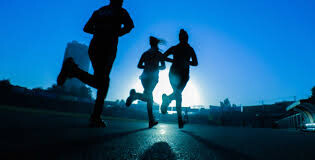
Over the years, a consistent theme has emerged: How do we embrace advances in science and technology without losing sight of the tried-and-true, or letting them corrupt an essential humanist element? This question has probably never been more urgent than in our era of accelerated machine learning. When I recently spoke to my friend Scott Lachut, a longtime veteran of the trend forecasting industry, he told me that he’d come across a few examples of gyms that offer AI-based trainers with different “personalities.” Depending on whether you wanted to be coddled or subjected to dominatrix-style abasement, your virtual coach would be able to accommodate your needs.
“I personally think that generative AI being able to offer personalization at scale is going to be pretty interesting, if a bit Big Brother-y,” Scott told me. This reminded me of that frequently cited proverb of uncertain origin, “May you live in interesting times.” Depending on your source, the line is either meant as a blessing, or a curse.
My guess is that “ultra-processed” will be the food term of the year as everyone who cares about what they eat realizes that they need to cut down on foods that are industrially produced, use industrially extracted ingredients, and are designed to replace real foods and be “addictive.”
Much evidence associates these foods with overweight and obesity-related chronic diseases (heart disease, type 2 diabetes, etc), and overall mortality. One clinical trial supports the addiction hypothesis; it demonstrates that people who eat ultra-processed diets as opposed to matched diets based on minimally processed foods take in many more calories. I would not be surprised to see non-ultra-processed products starting to be advertised as such.
—Marion Nestle, professor emerita at New York University and author of the Food Politics blog
Sometime in 2024, we will learn of an epochal breakthrough in the quest for longevity. There will be a molecule that, when given in sufficient quantities to certain transgenic rodents, extends life by an amount that, when extrapolated from rodent-years to human-years, is statistically significant. Human trials will be planned; venture capital will flow like red wine; extremely long podcasts will be recorded. Obscure herbs that contain molecules distantly related to the breakthrough will flood the Internet. The global wellness market will reach a projected size of $6.6 trillion. Life expectancy in the United States will continue its decade-long decline.
–Alex Hutchinson, Outside Sweat Science columnist and author of Endure: Mind, Body, and the Curiously Elastic Limits of Human Performance
For too long, runners at the back of the pack have felt left behind by the larger running community. Few running clubs provided support for the 12-minute (or more) mile crowd, and many race organizers packed up water stations or ran out of medals before the slowest runners crossed the finish line. Thankfully, this is beginning to change, largely due to the work of slow-running activists like Martinus Evans, founder of the Slow AF Run Club, who published a book by the same name last summer. As Evans’s star has risen, so has support for his cause: The virtual club is now more than 18,000 members strong, and runners around the world have been inspired by his calls for greater inclusivity in fitness. The past few years have also seen the launch of several in-person pace-inclusive running groups.
As more slow runners feel welcome at running events, the average course time for many major races, including the New York City Marathon, is slowing down. “The stigma of being a back-of-the-pack runner is slowly going away,” the marathon’s race director, Ted Metellus, recently told The Washington Post. Most of us face plenty of barriers to simply lacing up sneakers and finding the time to move. I’m hopeful that, for growing numbers, speed will no longer be one of them.
—Danielle Friedman, journalist and author of Let’s Get Physical: How Women Discovered Exercise and Reshaped the World
Amidst the increasing chaos and tumult of everyday life, people will crave stability and simplicity from their health and fitness routines. There will never be a shortage of those who are into the latest fad or bro-science gimmick, but it seems more and more people are becoming tired of this. There is already so much noise in the world, and one’s health and fitness approach need not contribute to it.
I suspect it’ll increasingly be back to basics—because not only do basics work, but they aren’t so exhausting. Out with the social media hype speeches from $8,000 cold plunges at five in the morning, in with a morning pot of coffee or tea, reading a book, and 30 to 60 minutes of movement that you can do consistently. The former sounds cool. The latter is the path to actual health and well-being.
—Brad Stulberg, executive coach and author of Master of Change: How to Excel When Everything is Changing, Including You
Social media can have an unfortunate flattening effect—it can feel like every person on your feed wants the exact same thing. Angels Landing is the only hike worth doing, Yosemite the only public land worth visiting, and the six big-city marathon “majors”—New York, Boston, Chicago, London, Berlin, and Tokyo—are the only footraces worth contending. Interest in these races has boomed (Boston qualification keeps getting harder, lottery applications to Chicago have more than doubled over the last decade) even as smaller marathons stagnate or even decline. Something has to give, just as a matter of pure arithmetic, so perhaps this will be the year of flexing on your followers with a PR in your local grassroots 10K.
–Chris Cohen, deputy site editor and wellness editor at GQ.com
Everyone is lonely. We are starved for human connection and contact. We are starved for reasons to go outside. We are all withering and calcifying, physically. The natural answer is, of course, stay with me, PvP zones. What is a PvP zone, you ask? PvP zones, in open-world video games, are designated areas where players are able to directly interface with—OK, attack—one another. I do not mean for there to be actual violence, obviously. But a place for adults to engage in relatively unstructured play? We need it, now more than ever.
I see you shaking your head, but that only proves how badly you need to engage with your fellow humans in a PvP zone. You may think I’m joking, but I am entirely serious. I take my dog to the dog park, and then I sit there roiling with jealousy for 45 minutes. How is it that we have a place for her, a dog, to get up to shenanigans with her fellows, while the only acceptable thing for me to do outside is sit on a bench? It’s preposterous.
I, we, have basically all the same needs as a dog for play and exercise and, most importantly, fun with others. We are grown adults. We should, theoretically, be allowed to do whatever we want. Why is “goofing around in parks” the provenance of only dogs and children? Why are we not allowed to do some good old-fashioned light roughhousing, to chase one another in and out of trees, just because it’s fun and funny only if you, very crucially, don’t think about why or what for at all? If you are thinking “You’re just describing jiu jitsu class, or recreational softball”: sort of. But the most crucial aspect of the PvP zone is that it’s structureless, a place where no one loses and skill doesn’t matter.
I don’t think anyone would argue that many of us think entirely too much now. Perhaps the solution to all of our ills is to just designate an area of our parks where it is acceptable to go up to another person you don’t know and say “tag, you are it” and then run away. PvP zones. It could, and should, and by my estimation will, happen.
—Casey Johnston, creator of the She’s a Beast newsletter
A combination of sustainable lifestyle changes and personalized solutions will reimagine sick care. I think health spending will shift from reactive to proactive care in the coming decades. More movement and healthy food should be the first line of defense. Building on that foundation, health trackers, preventative diagnostics, and coaching/care platforms will help save the U.S. healthcare system trillions of dollars in the long run.
—Anthony Vennare, co-founder of the Fitt Insider newsletter
People have come around to the fact that shorter workouts still have benefits (see exercise snacks!) and that high intensity workouts do not have to be long. What we are going to see next is the swell of lower intensity workouts having a lap in the spotlight. More men taking Pilates, people walking, lower intensity steady state exercise (Zone 2 and otherwise), and wanting to feel better instead of just being fitter.
As millennials’ life responsibilities start to pile-up as this cohort of individuals who were born into the wellness boom continue to age, the wear and tear that intense workouts have on the body will rear its head. Additionally, people are starting to understand more of the science behind benefits of lower intensity steady state work, especially for the heart. The “soft life” mindset will show up in the gym.
—Joe Holder, founder of The Ocho System and GQ wellness columnist
We’re at a point where I think we’re going to have to redefine how we see health and wellness in a number of ways. On the one hand, we’re going to have to reckon with the environment we’ve created. There’s an increasing acknowledgement that having phones everywhere, at all times, is causing some disastrous mental health in teens and young adults. And for the rest of us, the impact of neglecting green space, parks, walkable areas, and so much more in our day-to-day living is setting us up to fail.
On the other hand, the promise of medical discoveries like GLP-1 drugs bring much needed avenues for meaningful change. The first legitimate drug for obesity will force us to wrestle with how we see health, from both a personal and medicalized approach. My hope is that we find ourselves wrestling with the nuance in the middle, finding ways to utilize medical breakthroughs, while creating an avenue for long-term sustainability by making our environment invite healthier actions.
—Steve Magness, track and field coach at the University of Houston, coauthor of The Passion Paradox and Peak Performance, and cofounder of The Growth Equation
Growing up in an Asian-American family, the greatest compliment anyone in my family could give about a dessert was, “it’s not too sweet.” This aversion to cloying sweetness, which was hard coded into my palate from a young age, has caught on with the mainstream. Starting with long overdue realignment of the soda industry toward sparkling water as the hero, to the continued rise in popularity of Asian food with its greater emphasis on savory over sweet, to the all-too-common experience of asking your server for a wine recommendation that’s “on the drier side,” sweetness continues to be marginalized.
But while sugar has been demonized for decades from a nutritional standpoint, eaters are now reducing sugar intake for purely taste reasons, not just health ones. Even people who aren’t militant about avoiding sugar are moderating it because they want to actually taste their food, not have their taste buds smothered in a wave of sweetness. And with rising negative sentiment around the healthfulness of artificial sweeteners and the general affinity for more unadulterated foods, diets in 2024 and beyond might not only continue to reduce sugar levels, but whatever small amounts of sugar they do eat will come from natural sources, not synthetic ones.
—Mike Lee, Founder of The Future Market, a trend forecasting company for the food industry
You used to have to go to a sterile clinic to get a longevity boost with Vitamin IV drips and stem cell therapy but resorts are now partnering with longevity centers to offer onsite treatments. Guests at Four Seasons Resort Maui at Wailea can get a poolside NAD+ IV drip. Katikies Kirini in Santorini now has an outpost of a ZOE Bio Regenerative Wellness Clinic where guests can get live blood analysis. And Six Senses Ibiza has partnered with biotech company RoseBar to offer guests full diagnostic testing that can inform biohack treatments like localized cryotherapy.
—Jen Murphy, Outside contributor and longtime fitness columnist for the Wall Street Journal
I think in 2024 sotol will take over from mezcal as the “it” cocktail. Cheers!
by Outside Online
Login to leave a comment
Why Do I Get So Itchy When I Run?
Here’s what experts say about the causes of that uncomfortable, tingling sensation and how to cope with it.
As a runner, you try to prepare for everything: You have a waterproof jacket for that 60 percent chance of rain, anti-blister socks, and a supply of gel packs for Saturday long runs. However, something that you may be less prepared for is relentless itching and tingling.
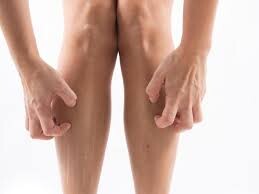
Known as “runner’s itch,” this sensation makes hitting the road uncomfortable for many runners, especially those just starting out or getting back into a running routine.
“Runner’s itch wasn’t something that was particularly researched and documented before the 1950s, but it’s been consistently described in literature in some way since about the 70s,” says Braden Romer, Ph.D., an associate professor of exercise science at High Point University in High Point, North Carolina. “We’ve seen the prevalence go up as there are more individuals taking part in physical activity. I run into it quite often when dealing with athletes.”
If you want to run more but can’t stand the urge to stop and scratch, here’s what to know about runner’s itch and how to soothe it.
What causes runner’s itch?
The causes of runner’s itch may range from minor inconveniences to more serious health conditions. Although more research is needed to fully understand what triggers this sensation, here are five potential causes.
1. Dry or Irritated Skin
Both humidity and dryness in the air can lead to runner’s itch.
“If you sweat a lot or if it’s very humid or raining, and your clothes get wet, you run the risk of skin irritation or itchiness,” says Melissa Kendter, C.P.T., a Philadelphia-based United Endurance Sports Coaching Academy (UESCA) running coach.
Meanwhile, another common cause is dry air and dry skin. Friction from running can exacerbate this and cause unpleasant itching.
“Some research has suggested hydration is a factor as well,” says Romer. “If you’re not drinking enough water, your skin gets dry and itches. When you begin to workout, especially with workout clothes, that may trigger an effect as well.”
Running can also exacerbate eczema, a group of inflammatory skin conditions that lead to issues like itchiness and dry skin.
“If you’re prone to eczema, exercise might make it worse,” says Minneapolis-based William Roberts, M.D. chief medical officer of the American College of Sports Medicine and former director of the sports medicine program at the University of Minnesota Medical School. “If you notice a skin rash, talk to your doctor.”
2. Histamine Release
A predominant theory behind runner’s itch is a histamine release at the onset of exercise, says Romer. Aerobic or endurance exercise can generate a localized anaphylactic reaction within the exercised muscle tissue, which causes histamine release, per a 2017 study in Exercise and Sport Sciences Reviews.
“There’s some research to suggest that the itching may be related to histamine release at the onset of exercise, particularly in high-intensity exercise,” Romer explains. “If somebody hasn’t been working out or running, or they haven’t warmed up and jump right into a high-intensity workout, that may be triggering a greater histamine release from within the muscle cells.”
This histamine release, in turn, could cause that uncomfortable and itchy feeling.
2. Blood Vessel Expansion
When you run, blood flow increases to your tissues, causing vasodilation (the widening of blood vessels). One theory is that the increased size of your capillaries causes an itching sensation.
“The capillaries start to expand, which may send a triggering response to some of the nerve fibers around that area,” says Romer. You may be more prone to this if you haven’t run for a while or are just starting out.
“This typically can happen for newer runners or ones getting back into the routine of running, because their bodies aren’t adept at this process,” says Kendter. “If your fitness routine has been put on the back burner for some time, you have a higher risk.”
However, this theory does have its skeptics. Romer adds that there are multiple pathways that have been proposed for runner’s itch and the symptom is not well understood. This was evident even in the differing opinions among the experts we spoke to—Roberts, for instance, has doubts that vasodilation could cause itching.
The bottom line: Though runner’s itch could potentially be related to blood flow, more research is needed to fully understand the mechanisms behind this process.
4. Exercise-Induced Urticaria
In more rare cases, allergic responses to exercise can cause severe symptoms. Exercise-induced urticaria is a rare clinical condition that causes flushing, itchiness, and hives after a workout, per a March 2022 single case study in Cureus. A minority of patients can even develop anaphylaxis, which is a severe, life-threatening allergic reaction.
“Exercise-induced anaphylaxis can cause a fast heart rate and potentially the swelling of the throat and blocking of the airways,” says Roberts.
About 30 to 50 percent of exercise-induced anaphylaxis is food dependent, meaning it only occurs with the combination of a specific food and exercise, per another single case study, published in 2017 in Canadian Family Physician.
Many different types of food have been found to have a triggering effect, including wheat, shellfish, nuts, tomatoes, peanuts, fish, pork, beef, mushrooms, hazelnuts, eggs, peaches, apples, milk, and alcohol.
If you suspect you’re experiencing urticaria, it’s important to see your physician to start a treatment program. This could include taking antihistamines before you run and carrying an EpiPen with you. If you do experience allergic reactions, it’s best to run with a buddy who knows how to help if you have a reaction.
People with severe cases of exercise-induced urticaria may need to avoid certain types of exercise and foods (or, rarely, exercise altogether).
5. Cholinergic Urticaria
Another condition that could be the cause of itching is cholinergic urticaria, which is characterized by itching and/or a stinging pain, redness, and bumps.
Think of this as a heat-triggered reaction: Symptoms develop after an increased body temperature has been stimulated repeatedly, such as through exercise, per a 2023 review in the American Journal of Clinical Dermatology.
“This is also pretty rare,” says Roberts. “It’s a response to the skin warming that occurs with running.”
Cholinergic urticaria is often associated with serious symptoms like anaphylaxis and severe pain. This condition comes on very quickly and may also involve an antihistamine treatment plan. Your doctor may conduct testing to confirm that you’re experiencing cholinergic urticaria, which may involve raising the body temperature through exercise on a treadmill or stationary bike.
Who’s most prone to runner’s itch?
When it comes to everyday runner’s itch that’s not related to a more serious medical condition like exercise-induced urticaria or cholinergic urticaria, runners who are just starting out or who haven’t exercised in a while may be more likely to experience it.
“I’ve seen this with athletes who have taken time off,” says Romer. “My wife also struggles with runner’s itch quite a bit. If she takes some time off from high-intensity runs for a bit, especially in the winter, it really gets after her for the first few workouts.”
If the itching is due to dry skin, factors like age, climate (think desert-like climates with low humidity or cold climates with heavy wind), genetics, or health conditions like eczema or diabetes can play a role, per the Cleveland Clinic. You may also experience more dry, itchy skin during the winter or if you’re not drinking enough water.
How can you sooth runner’s itch?
For many people, runner’s itch will fade away with regular exercise, unless it’s a symptom of a more serious condition. “It generally subsides relatively quickly after several workout sessions or modifying hydration intake,” says Romer.
You can also aim to soothe runner’s itch by properly easing into your run.“Do a good warmup so your body has a gradual increase in temperature and the blood gets flowing to the muscles in advance, rather than a rapid increase,” says Kendter.
Try to keep running throughout the year: Although the first couple of weeks may feel uncomfortable, if you stay consistent and allow your body to adapt to your routine, you’re less likely to experience the itch.
Staying properly hydrated and using a moisturizer to soothe dry skin can also help. Roberts recommends moisturizing creams like Vanicream, which is available over the counter.
All of this said, talk to your doctor if runner’s itch continues for you or if symptoms are severe—say, it’s accompanied by rash or hives, is extremely painful, or continues/worsens over time.
“If it becomes a chronic response, where you’re not seeing a diminished response even if you’ve been able to regularly exercise, see a physician,” says Romer.
by Runner's World
Login to leave a comment
Even Just 10 Minutes of Running Per Day Can Offer Serious Physical and Mental Benefits
Here’s how even just a quick, casual jog can boost your mental and physical health.
As a runner, you might feel like you don’t have to add activity breaks throughout the day because you went for a run in the morning anyway, right? Well, the truth is a bit more granular. Studies suggest that taking 10-minute runs benefit everyone—no matter what pace you go—including those who are sedentary and those who are active.
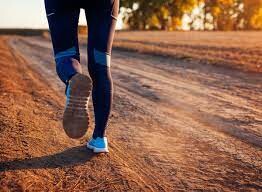
“Research shows that running even five to 10 minutes per day at slow speeds reduces all-cause mortality, as well as death from cardiovascular disease,” says Lindsay Ludlow, Ph.D., an exercise physiologist and runner based in Ann Arbor, Michigan.
In fact, a number of studies, including the Copenhagen City Heart Study which followed more than 5,000 people, demonstrate that people who run at an easy to moderate pace between one and three hours every week live longer than both those who are sedentary and those who run faster and more frequently.
“If you’re training for a race and already running far more than 10 minutes on some days, that doesn’t mean you shouldn’t take those 10-minute easy run breaks,” Louise Valentine, M.P.H., C.S.C.S., author of The Art of Breaking Through tells Runner’s World. “We often see the ‘active couch potato’ complex, which means you work out regularly, but when you’re not working out, you have long periods of inactivity. You need those movement breaks for your health.”
Why All Runners Benefit from Jogging for 10 Minutes a Day
The benefits of activity throughout the day, especially after meals and while working at a sedentary job, stand out from say, training for a marathon. That’s because the goals of a training plan—to get faster or run a specific distance—are not the same as daily fitness and activity goals. These 10-minute runs offer similar advantages to brushing your teeth, getting enough rest, and eating well. They keep you healthy.
One of the main reasons daily activity advances your overall wellbeing? It improves the health of your cells and fights off aging. We’re not talking about the superficial signs of aging, such as wrinkles or gray hair, but the more significant signs like disease-related symptoms.
“There are 12 hallmarks of aging,” Andrew Ludlow, assistant professor at the University of Michigan in Ann Arbor, who studies cellular health and exercise, tells Runner’s World. “What’s good for your whole-body physiology is also good for your cells. While the primary hallmarks are out of our control, such as the passage of time and the genes you inherit, the secondary signs of aging are things over which we have control and include poor diet, poor sleep, and lack of physical activity.”
Of course, researchers do not yet know whether there is a specific amount of exercise that is ideal for everyone. But when Ludlow and his team studied people over 50, they found that those with the healthiest cells were moderately to highly active.
The bottom line is that, whatever your running habits, adding physical activity throughout your day, including easy to moderate 10-minute runs, will build up your antioxidant defense and promote an anti-inflammatory response, Ludlow adds.
To figure out when to add these quick, easy runs to your schedule, here are the best times of day for added benefits. All you need to do is put on running shoes and get out the door, hop on your treadmill, or even run in place!
The Best Times To Do a 10-Minute Run
Soon After a Meal
According to a 2023 systematic review and meta-analysis study published in Sports Medicine, women who did moderate or high-intensity exercise within 30 minutes after a meal had fewer spikes in their blood glucose levels. Similarly, a 2018 study published in Nutrients found that cycling at a light effort within 30 minutes of a meal reduced blood glucose levels.
Those with type 2 diabetes may benefit more from high-intensity post-meal exercise than moderate exercise after eating, according to research. It may even reduce reliance on insulin, says Lindsay Ludlow.
As Andrew Ludlow points out, intensity is often relative to the fitness level of an individual. A 10-minute walk is better than sitting, but runners might want to pick up the pace of their post-meal activity to reach that more moderate effort.
When You’re Grumpy or Down
Both Valentine and Lindsay Ludlow recommend turning to short runs when you’re in a bad mood. “You’ll get an energy boost when you’re out in the sunshine and you will feel your mood elevate with a run,” says Valentine.
Research bears this out. According to a 2022 PLoS One systematic review and meta-analysis, microbreaks—meaning scheduled times that interrupt extended sitting and focus—increase wellbeing, making people feel more attentive and energetic. Likewise, a 2021 Frontiers in Human Neuroscience article suggests that physical activity breaks reduce stress levels, while improving working memory in middle-aged adults.
Why turn those breaks into runs? A 2021 scoping review published in The International Journal of Environmental Research and Public Health found that acute bouts of running between 10 to 60 minutes can improve mental health, and according to the researchers, it doesn’t matter whether you run on treadmills, a track, or outdoors. The runners involved in the studies included in the review were using the activity to ease symptoms related to depression, anxiety, eating disorders, addiction, and other mental health issues.
When You’re Ruminating Over a Problem
You’ve probably been there: Sitting at your laptop trying to figure out how to word an important email or struggling to add numbers. Guess what? That’s the perfect time for a run.
Valentine says 10-minute runs are great for problem solving. And a 2021 study published in Nature found that a 10-minute single-bout of moderate-intensity running improves executive function, which relates to memory, flexible thinking, and self-control. In the study, researchers gave participants a series of tasks to measure reaction time and other skills. They concluded that running has stronger beneficial effects on mood and executive function than other physical activities, such as cycling, partly because it is a weight-bearing activity that requires coordination.
When You Don’t Have Time to Train
A quick 10-minute run is far better for your training and health than simply not running at all, say the experts.
To use a 10-minute run as a workout, Lindsay Ludlow suggests doing a three-minute warmup, four-minute hard effort, and three-minute cooldown. Another potential workout Lindsay Ludlow and Valentine recommend: a three-minute warmup, followed by three rounds of one minute hard and 30 seconds easy with a 2.5-minute cooldown. Valentine also suggests adding skipping and hip mobility moves to your 10-minute run.
Not all 10-minute runs have to be the same, Ludlow says. You can turn any 10-minute run into a training workout, whether you’re doing run-walk intervals or technique drills.
by Runner’s World
Login to leave a comment
Short runs have major health benefits, research says
There’s a consensus that running has positive effects on our physical and mental health, but how many miles do runners need to log before they reap rewards? Most people know those who exercise have less risk for heart disease, cancer and diabetes and tend to live longer, and it’s a commonly held belief that the more time spent pounding the pavement, the greater the benefits. Recent research suggests we don’t actually need to run very much to reap the rewards, The New York Times recently reported.
Longer doesn’t mean better
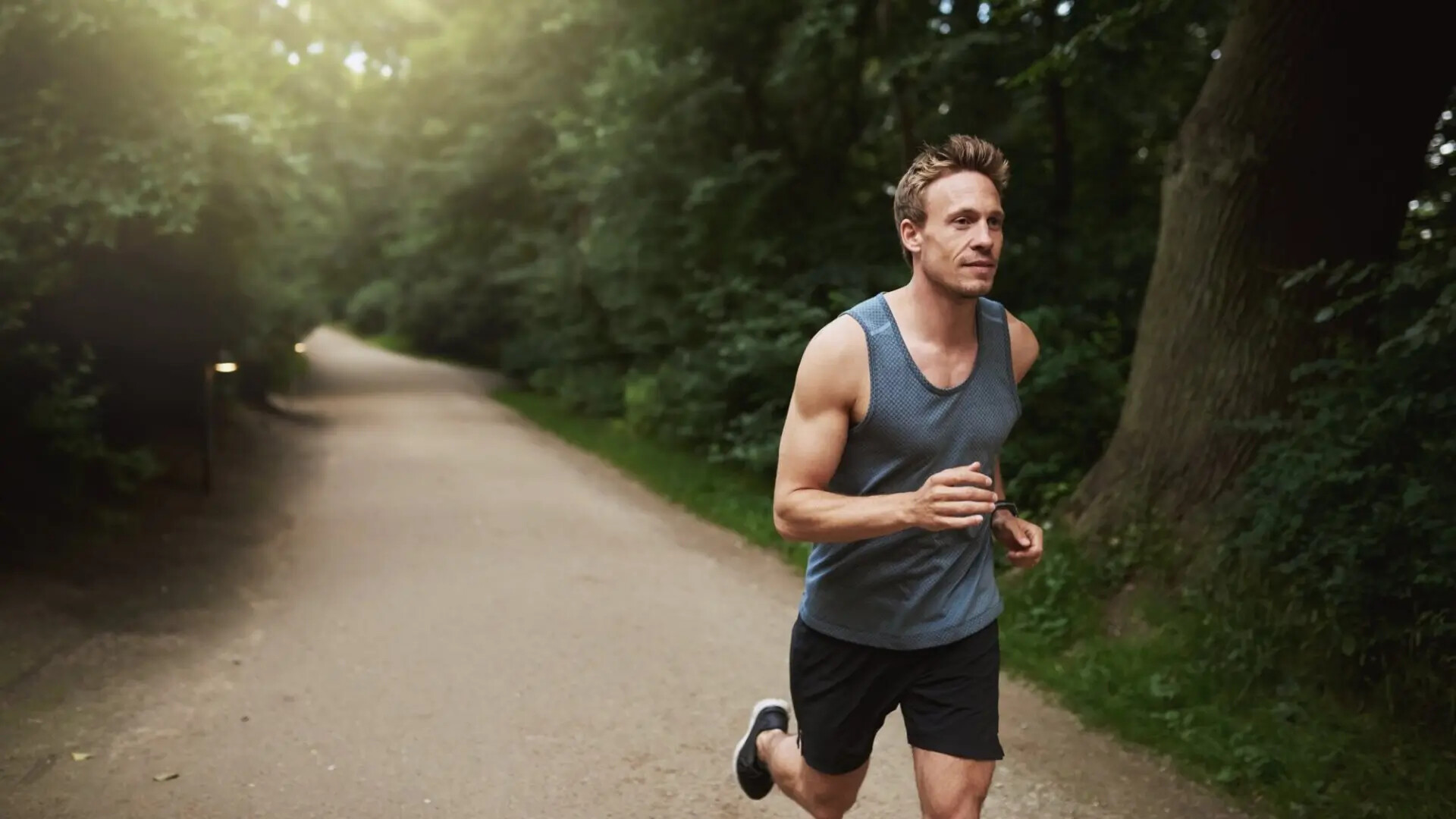
There’s a growing body of evidence that correlates even much shorter running sessions to significant health benefits, especially those regarding longevity and mental health. Dr. James H. O’Keefe, director of preventive cardiology at St. Luke’s Mid-America Heart Institute in Kansas City, Mo., says that going for a two-mile (3.2 km) run several times a week seems to give people the full benefit of running, in terms of longevity, specifically.
O’Keefe and his colleagues have published multiple studies on running for health and longevity. In one study, he analyzed long-term health and exercise data gathered from 5,000 adults ranging in age from 20 to 92. People who ran between one and two and a half hours per week at a slow or moderate pace seem to have the biggest boost in longevity–even greater than in runners who run more, faster.
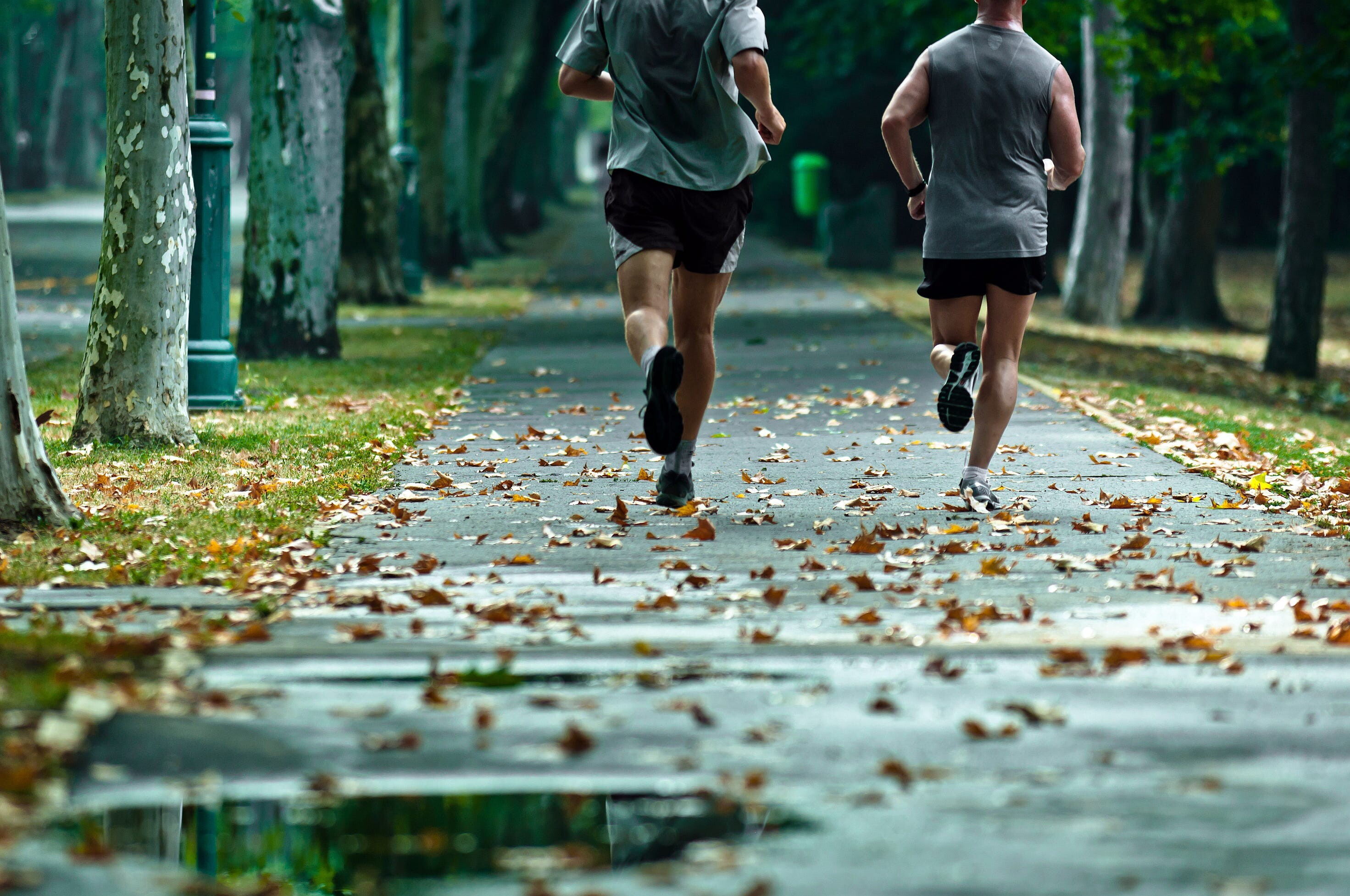
Less time training still boosts mental health
Exercise makes us feel better, but more exercise doesn’t necessarily mean more mental health benefits. A recent research review on exercise and depression reported that adults who managed to exercise for the two-and-a-half hours of physical activity per week recommended by most guidelines gained a 25 per cent lower risk of depression when compared to non-exercisers.
Can’t manage to meet the recommended guidelines? Those who completed only half of the recommended two-and-a-half weekly hours still benefited from an 18 per cent lower risk of depression compared to non-exercisers.
“The growing consensus in the field is that the benefits of running start to accrue within minutes,” said Dr. Rajesh Vedanthan, an associate professor of population health at New York University’s Grossman School of Medicine.
If you’re a newer runner easing into regular exercise, or simply can’t fit in longer running sessions, don’t stress: you’re still adding years to your life, reducing your risk of many diseases and bolstering your mental health.
by Keeley Milne
Login to leave a comment
These Expert-Recommended Kinesiology Tapes Could Help Your Running Recovery
To overcome a nagging running injury, just tape yourself back together.
Kinesiology tape, created by Japanese chiropractor Dr. Kenzo Kase in 1973, is a stretchy therapeutic tape made of mostly cotton that uses medical-grade acrylic adhesive to stick to your skin. When stretched tight, the tape pulls the skin away from the tissues beneath, reducing the pressure against the underlying tissues. In theory, this promotes circulation and the removal of waste products through lymphatic drainage.
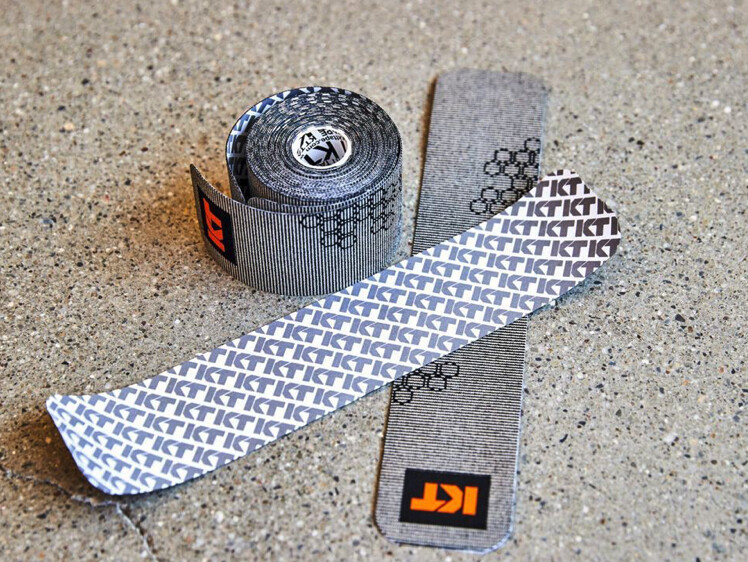
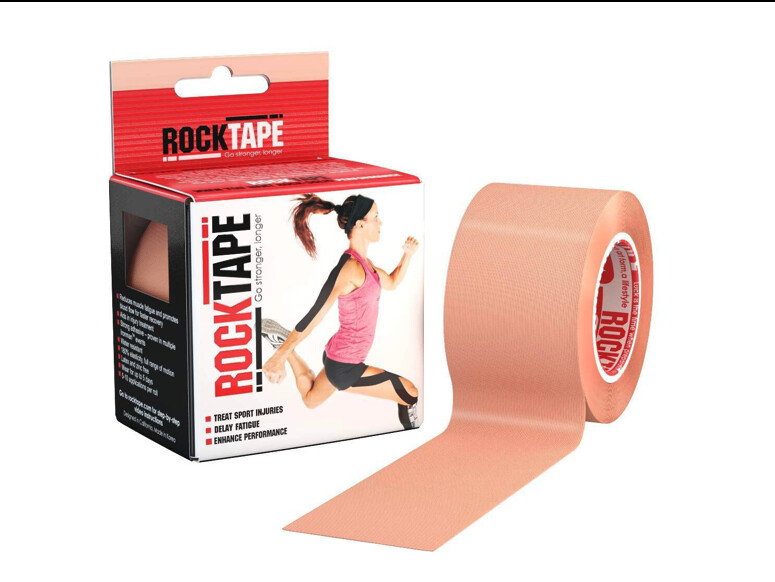
Our experts said that some runners use kinesiology tape to reduce pain. “Once you reduce the perception of pain, you can get an increase in range of motion and an increase in muscle activation,” says Dr. Karena Wu, clinical director of ActiveCare Physical Therapy. Because nerve fibers associated with touch stimulation are larger than pain fibers, the brain receives the touch stimulation faster, reducing your perception of the pain.
The tape can also inhibit certain muscles or facilitate others. Instead of immobilizing muscles and joints like athletic tape, kinesiology tape is stretchy, and runners can use that elasticity to adopt a stronger, healthier stride. “People who have shoulder or trap pain as they’re running tend to hike their shoulders up toward their ears,” says Denise Smith, PT and owner of Smith Physical Therapy + Running Academy. “We’ll tape down their shoulders. As their shoulder creeps up as they fatigue, that triggers a sensation of the tape pulling on the skin, so they relax their shoulders.”
Scientific research confirms some of kinesiology tape’s purported benefits. A 2022 meta-analysis of eight studies conducted by the University of Padova in Italy found that kinesiology tape was able to improve gait function, range of motion, and muscle activation in athletes. However, a 2020 study out of Leeds Beckett University in England found that the tape made no difference in cutaneous blood flow, calling into question some of the tape’s purported benefits for muscle soreness and recovery.
Even without hard science behind all of its claimed benefits, kinesiology tape has been widely adopted by athletes and trainers. At less than $20 per roll on average, it’s a low-cost, low-risk way to at least try to optimize your training regimen.
What to Consider When Picking Out Kinesiology TapeAllergies and Sensitivities
Most kinesiology tapes are made from hypoallergenic materials like cotton and nylon, and specifically avoid using those that commonly trigger allergies, such as latex. Even so, make sure to check the composition of any tape before applying it if you have a skin allergy.
Even if you don’t have a specific, intense allergy, some adhesives may irritate sensitive skin. Several brands offer “gentle” tapes with weaker adhesives that are less likely to cause redness or swelling.
Separately, keep in mind that removing kinesiology tape will likely affect your skin, since the adhesive is very strong. Make sure to read the removal instructions before yanking the tape off—some manufacturers recommend using baby oil to break down the adhesive before removal.
Body Hair
You don’t need to shave your body hair to use kinesiology tape, but you should know that too much body hair will defeat even the stickiest adhesives. If your tape is coming off more quickly than it should on a hairy area, shaving down to a quarter-inch or less may improve the tape’s staying power.
Positioning
Some areas of your body are easier to tape yourself than others, so consider where and how you’ll apply the tape before you buy. Ideally, you should consult a doctor or physical therapist before using kinesiology tape so they can show how to properly cut and apply it in a way that will enhance your performance, instead of harming it. “It is very important to know the anatomy where you are trying to apply the tape,” said Bruce Allen, DC, a chiropractor and certified kinesiology tape practitioner at the San Diego Running Institute. “If taped incorrectly, you could give yourself a separate injury.”
We also have a guide to using kinesiology tape, with expert instructions for taping yourself up to deal with a handful of common running injuries, including plantar fasciitis and shin splints.
If you’re concerned about mis-taping, we recommend looking for pre-cut kinesiology tape strips and patterns, which are made to support specific trouble spots, including knees, shoulders, and the lower back.
How We Selected the Best Kinesiology Tapes
To choose the best kinesiology tape, we consulted eight physical therapists, trainers, and running coaches to find out which ones they use and recommend to their athletes. We also gleaned insight from popular running forums like Slowtwitch, impressions from additional experts, and hundreds of customer reviews at major retailers, such as Amazon and Walmart.Vikash Sharma DPT, OCS, COMT of Perfect Stride Physical Therapy in New York City is a doctor of physical therapy and a certified running coach with the Road Runners Club of America and USA Track and Field. An avid runner, Sharma competes in road races around the Northeast.
Karena Wu, DPT, OCS, COMT, CSCS, CKPT, CPI, FAAOMPT is the owner and clinical director of ActiveCare Physical Therapy in New York and Mumbai. Wu is also the former director of education for Spidertech Kinesiology Tape.
Bruce Allen, DC, CKTP is a doctor of chiropractic medicine and certified kinesiology tape practitioner based in San Diego. Allen received his Bachelor of Science in Kinesiology, specializing in kinesiotherapy, from San Diego State University.
Denise Smith, PT is the owner of Smith Physical Therapy + Running Academy in the Chicago suburbs. A certified running technique specialist, Smith has consulted for the Russian olympic and national triathlon teams and travels the country educating runners on proper form using the Pose Method.
Robyn Pester of Robyn Pester Physical Therapy in Eugene, Oregon has been the lead PT for the 2022 World Athletics Championships, the Olympic Track & Field Trials in 2016 and 2020, and other high-end local track meets. Her manual therapy skills have developed over a 30-year career that has helped hundreds of clients return to active lifestyles.
Ryan Sweeney, DPT earned a doctorate in physical therapy at Duke University in 2013 and now works as an orthopedic clinical specialist and muscle activation technique specialist at Specialists in Sports and Orthopedic Rehabilitation in Overland Park, Kansas.
Matt Silver, DPT at Alpha Project Phyzio and Performance and a certified running gait analyst, helps injured runners regain their stride with athlete-focused physical therapy.
Peter Dills, DPT is the clinical director of Therapeutic Associates Physical Therapy in North Portland, Oregon. A certified therapeutic pain specialist and manual therapy specialist, Dills is particularly passionate about treating runners, especially foot and ankle disorders.
Dan Roe, author of this piece, is a former Runner’s World test manager and a former Division I distance runner at the University of Missouri. Kinesiology tape is a component of many top athletes’ training regimens, and a crucial aid for all kinds of runners who want to relieve soreness and remain cognizant of their form. Kinesiology tape mimics the elasticity of skin and lifts your skin away from tissues beneath, creating space that may help relieve joint pain, improve circulation, stabilize muscles, and reduce muscle soreness. Physical therapists also use it to help runners correct bad habits by helping them focus on activating muscles they may be underutilizing.
At the same time, it’s not a panacea for muscular health. In fact, it isn’t for everyone. We’re here to help you figure out whether kinesiology tape can help you support your muscles, improve circulation or prevent injury. We’ll also point you toward the best kinesiology tapes you can buy right now, from KT and other brands, based on expert advice from physical therapists who recommend the tape to their athletes.Who should avoid using kinesiology tape?
You should avoid kinesiology tape if you have a condition where more blood flow would be bad—deep vein thrombosis, diabetes and active cancers are among conditions that have excluded people from participating in kinesiology tape research. Also avoid taping over open wounds due to the risk of an infection.
If you’re unsure how your skin will react to an acrylic-based adhesive, or any of the components in a specific tape, test it first by applying an inch-long strip and waiting a few minutes to see how you react.
How long should I leave kinesiology tape on?
According to our experts, you should leave your KT tape on until it starts to slide or fall off. “The tape is meant to be a sensory stimuli so it is meant to be worn for the length of the activity and even afterwards,” said Wu. “In rehabilitation, it should be used for a few weeks in order to retrain or support or inhibit tissues during the recovery process.”
In most cases, a piece of tape should last for a few days, up to a week. Most of these tapes are water-resistant so you will be able to shower after a run while wearing your tape, but it will likely weaken the adhesive.
How do I prepare my skin before applying KT tape?
Our experts recommend applying rubbing alcohol to the area to remove natural oils before taping up. Make sure the skin is not red or irritated before putting it on, especially if you are reapplying to a recently taped area. “You never want to take the top layer of skin off or irritate the skin or else you cannot re-tape until the skin has calmed down,” Wu said.
How do I remove KT tape?
Dills advises his clients to remove the tape in the shower using warm, soapy water. To avoid leaving a residue, “don’t pull the tape straight away from your skin,” Dills said. “Gently peel it back a little at a time.” If your tape does leave some adhesive behind, Smith recommends starting with soapy water and a sponge or scrub brush, and graduating to an adhesive remover pad for persistent adhesives.
by DAN ROE Runners World
Login to leave a comment
100m world junior record holder suspended for doping
Suriname’s Issam Asinga, who only two weeks ago stunned the athletics world by shattering the U20 100m world record at the South American Championships in Sao Paulo, Brazil, has been provisionally suspended by the Athletics Integrity Unit (AIU) for the alleged use or presence of a prohibited substance . The suspension, which went into effect Wednesday and was announced by the AIU on Friday, is for the presence of GW1516, a substance that modifies how the body metabolizes fat, and which can boost endurance.
Provisional suspensions are issued before a hearing to determine whether the charges warrant any official punishment.

Botswana’s Nijel Amos, who won silver in the 800m at the 2012 Olympics in London, received a provisional suspension last year for the presence of the same metabolite ahead of the World Athletics Championships in Eugene, Ore. He ended up receiving a three-year ban.
GW1516 was originally developed to treat obesity and diabetes, but is not approved for human use, since it was discovered to be carcinogenic. It is banned in and out of competition, and not eligible for Therapeutic Use Exemption (TUE). A USADA bulletin from 2019 says GW1516 is also sometimes known as cardarine or endurobol and has been found in some supplements, even though it is illegal. In 2017, there were 31 sanctions worldwide related to its use.

The 18-year-old Asinga clocked an impressive 9.89 seconds with a tailwind of (-0.8m/s) on July 28 to become the first South American sprinter to break the 10-second barrier in the 100m. His blazing run surpassed the previous record of 9.91 seconds set by Botswana’s Letsile Tebogo at last year’s World U20 Championships in Cali, Colombia, and also broke the South American area record, bettering the 10.00 mark set by Brazil’s Robson da Silva in 1988.
In addition to claiming a world record in Brazil, Asinga’ also picked up a free PlayStation 5 with his performance. A tweet posted last week shows retired American sprinter Justin Gatlin handing Asinga the video game console with the caption “The special moment when Justin Gatlin promised Issam Asinga a PS5 if he ran a legal 9.8 and he delivered!”
Asinga has made headlines in the 2023 season, running for Montverde Academy near Orlando, Fla. Earlier this year, he beat world champion Noah Lyles in a 100m race to break the U.S. high school record, and a week later, broke Lyles’s 200m high school record in 19.97 seconds.
The provisional suspension appears to have dashed Asinga’s dreams for gold at the World Athletics Championships in Budapest later this month, where he was set to run the double. The sprinter has plans to head to Texas A&M University in the NCAA on a full track and field scholarship this fall.
by Running Magazine
Login to leave a comment
Expert Strategies for Eating to Boost Energy
YOU SLEPT EIGHT hours, snuck in an early run, and made time to meditate before jumping on your first Zoom call. Still, your brain feels fuzzy all morning. By the time afternoon hits, you’re ready for a long, hard nap. What gives?
Though many factors can influence energy levels, perhaps one of the biggest (and most understated) is your diet, including what you nosh on, how much, and when.

“Everything that we eat can impact how we feel and what we’re able to do throughout the day,” says Amity Lui, MS, RD, a New York City–based sports dietitian who works with runners.
High-quality fueling can mean the difference between navigating life in a fog and consistently crushing your days. Good nutrition can also better your running and overall health, allowing you to exercise with less fatigue, which boosts your performance and decreases risk of injury—all while supporting hormone health, digestion, metabolism, and immune functioning, says sports dietitian Yasi Ansari, MS, RDN, CSSD, spokesperson for the Academy of Nutrition and Dietetics.
In short, there’s a lot to gain from optimizing your eating habits. Here’s what experts recommend.
• Eat often during the day
The trend of intermittent fasting—where people abstain from eating for certain stretches of time—may have health benefits for some, such as those with type 2 diabetes. But what about for runners looking to optimize performance and feel energized? “You really need to have steady fuel throughout the day,” says Selvi Rajagopal, MD, MPH, assistant professor of medicine at Johns Hopkins University School of Medicine. That means no skipping breakfast or “forgetting” to eat lunch.
Rajagopal recommends eating every three to four hours to prevent drastic dips in blood glucose levels, which can lead to plummeting energy levels.
A better bet is to strive for three well-balanced meals spaced throughout the day plus several snacks in between. “Eating consistently is going to make a huge difference,” says Lui, who recommends runners fuel as often as every two hours, or even more frequently if hunger strikes.
• Strive for well-balanced meals and snacks
Carbs are commonly vilified, but they are an essential macronutrient, especially for runners. “Carbohydrates are the number-one source of fuel for endurance runners,” says Ansari, because they get broken down into glucose, which your body prefers to use for energy. Don’t skimp on carbs if you want to avoid fatigue.
At the same time, unless you’re fueling for a run, avoid eating simple carbs by themselves, as that leads to a rapid spike in energy followed by a drop, according to research. Instead, pair carbs with the two other macronutrients: fats and protein. This will help stabilize your blood sugar and provide sustained, steady energy.
Here’s a sample day of balanced fueling, from Rajagopal. Of course, tailor this to your preferences.
Breakfast: Oatmeal with fruit and peanut butter or Greek yogurt
Mid-morning snack: Apple with nut butter or carrots, hummus, and whole-wheat crackers
Lunch: A quinoa, farrow, or brown rice bowl with sweet potatoes, vegetables, and a lean protein, like chicken or canned tuna
Mid-afternoon snack: Cottage cheese or Greek yogurt with granola
Dinner: Half a plate full of veggies, a quarter or third filled with a starchy carb like potatoes, and the last quarter protein
• Refuel after you run–even if you’re not hungry
While the general advice of “eat when you’re hungry, stop when you’re full” can help you eat mindfully, exercise—especially intense exercise—can suppress hunger due to the release of certain hormones and the fact that blood gets diverted from the GI system toward working muscles. In fact, according to a recent poll of nearly 3,000 people on Runner’s World Instagram, 61 percent of respondents said they find it difficult to eat after a long run or hard workout. “It’s really hard to identify if you’re actually hungry immediately after a really hard run,” says Ansari. But waiting to eat can hinder your recovery and lead to a crash in energy, she says. So no matter how you feel postworkout, aim to consume at least a snack within 30 minutes and then follow that up with a full meal within one to two hours later, advises Lui.
If the thought of solid food soon after a hard run makes you queasy, turn to liquid nutrition, like smoothies and protein shakes. Prioritize carbs and protein, and aim for a ratio of 3 grams of carbs to 1 gram of protein following intense training, says Ansari. One of her go-tos is a smoothie with kefir, almond milk, or cow’s milk, 1 cup frozen mango, 1 banana, a scoop of protein powder, and granola or a side of toast and nut butter.
• Load up on micronutrients
High-intensity exercise—ahem, running—can stress your body and lead to feelings of fatigue. However, eating antioxidant-rich foods like fruits, vegetables, and leafy greens in particular can help combat those effects, says Ansari. Antioxidants help to fight free radicals and oxidative stress postrun, aiding in your recovery. To get your dose of these health- and energy-boosting nutrients, incorporate produce into your meals: Eat a cup of fruit at breakfast, have a side salad at lunch, and load up your dinner plate with veggies.
There are several other micronutrients commonly found in fruits and veggies (as well as other foods) worth adding to your plate. While a doctor can help you determine if you have a deficiency and need a supplement, it’s still important to consume foods that contain these nutrients.
Iron: A deficiency in this mineral can lead to fatigue and tiredness, both cognitively and while exercising, says Ansari. Vegan and vegetarian runners may be at increased risk of deficiency, as red meat is one of the best sources of bioavailable iron. Those who menstruate are also at increased risk, says Rajagopal. Increase iron stores by eating leafy greens (spinach, broccoli, and kale), whole grains, nuts, and tofu. Enhance iron absorption by pairing iron-rich foods with those high in vitamin C, such as fruits, bell peppers, and berries, says Lui.
Vitamin B12: Deficiencies can result in fatigue and shortness of breath, says Lui. Vegetarian and vegan runners may be more at risk of low stores, as animal products provide the highest sources. Seek it out in products like meat, fish, and eggs, as well as fortified cereals, whole grains, plant-based milks, and nutritional yeast.
Vitamin D: A deficiency that affects 42 percent of all Americans (not just runners), according to a survey, too little vitamin D can cause fatigue, increased muscle weakness, and pain, says Lui. Eat foods like canned fish, dairy products, and fortified products like plant milks and orange juice. The caveat: It can be hard to get enough vitamin D, says Rajagopal, so you may need a supplement. Again, consult your doctor.
• Avoid making dinner your biggest meal
Dinner is typically the biggest meal of the day, but that doesn’t necessarily support a solid night’s slumber, which is essential for optimal energy. “Most folks sleep better if dinner isn’t the largest meal,” says Rajagopal, explaining that “our bodies don’t digest and metabolize things as quickly in the evening” compared to earlier in the day.
Instead of getting the bulk of your nutrition at dusk, eat consistently throughout the day. Also have dinner about three hours before bed to lower your risk of sleep-harming issues, like acid reflux.
• Have a slumber-inducing evening snack
If you end up feeling hungry between dinner and bed, reach for a small snack an hour or two before snooze time, says Lui, and get strategic about which snack you choose to best support sleep (and thus improve your overall energy). Ansari recommends Greek yogurt with fruit and a side of trail mix—a combo that provides magnesium, a nutrient that in one study of older adults helped them fall asleep faster.
You may also consider foods containing tryptophan, an amino acid that plays a role in the production of serotonin and melatonin, which support the onset of sleep and relaxation, Ansari says. Options include turkey, banana, oats, and tart cherry juice.
WHAT ZAPS YOUR ENERGY
Minimize energy dips by avoiding these foods and habits.
ULTRA-PROCESSED FOODS / Foods high in sugar and low in protein, fat, and fiber can provide an energy jolt if eaten soon before and during a run. But chowing on them in your day-to-day can lead to a rapid spike in energy followed by a slump, says Selvi Rajagopal, MD. Instead, eat snacks that offer macronutrients (carbs, protein, and fat) and fiber, and those low in added sugar, says Rajagopal.
DEHYDRATION / Research shows that as little as 2 percent dehydration can negatively affect performance, says Amity Lui, RD. “Not being adequately hydrated can make the body feel like it’s working harder,” adds Yasi Ansari, RDN. Lui says a good rule of thumb is to check the color of your pee. If it’s the shade of lemonade, you’re hydrated; if it’s akin to apple juice, you need a drink.
SPORTS DRINKS OUTSIDE OF A WORKOUT / Unless you’re hydrating during or after a workout, steer clear of sugary beverages, including sports drinks and hydration aids, says Rajagopal. Instead, consider water with a squeeze of citrus fruit.
UNDERFUELING / When athletes feel fatigued, it can sometimes be because of nutrient deficiencies, but most often, it’s because they simply aren’t eating enough, says Ansari. Research identifies low energy availability as one of the most significant factors associated with illness and injury risk in endurance athletes.
Login to leave a comment
Regular exercise has a beneficial impact on the body’s response to inflammation: Study says
For years, researchers and health practitioners have known that regular, moderate exercise has a positive impact on your body’s response to inflammation, but exactly why it has that effect has remained a mystery. A new study out of York University has helped to shed light on this poorly understood phenomenon.
The researchers at the School of Kinesiology and Health Science discovered that regular exercise impacts the production of white blood cells that are responsible for killing infections and healing injuries.
Inflammation–friend or foe?
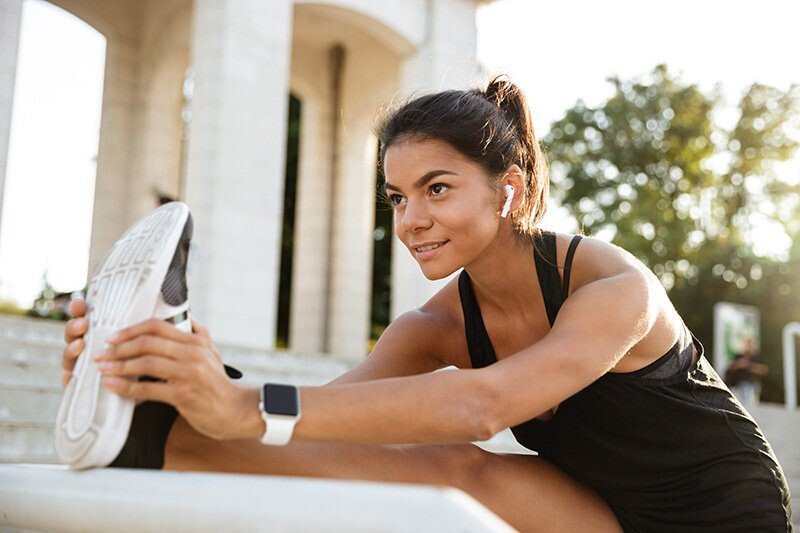
Inflammation is often treated as a bad thing, but it has an important role to play in our immune response. When you get sick or injure yourself, a certain amount of inflammation is necessary to fight off an infection or heal the injured tissue. Problems begin when you have excessive inflammation. Heart disease, diabetes, many autoimmune diseases and cancers all start because of an excessive inflammatory response from your body’s immune system. (COVID-19 was another example of the deleterious effects of an excessive immune response, which ended up attacking otherwise healthy organs in the body.)
Exercise is known as an immunomodulator. This means it helps your body moderate its immune response at the onset of illness or injury, ensuring its inflammatory response is just enough to allow for healing, without going overboard and causing a cascade of other problems

The study
The study, which was performed on mice, showed that moderate-intensity exercise had a “training effect” on the precursors for macrophages (the white blood cells that are responsible for mounting an inflammatory response and are your body’s first line of defense against infections). After the mice underwent a regular, moderate-intensity exercise regime, they experienced a “persistent metabolic rewiring and changes to chromatin accessibility in bone marrow-derived macrophages (BMDMs), which, in turn, tempers their inflammatory responses.”
In other words, exercise changed the way the cells breathed, according to Faculty of Health Associate Professor and York Research Chair Ali Abdul-Sater.
“Much like if you train your muscles through exercise, we showed that exercise of moderate intensity ended up training the precursors of those macrophages in the bone marrow,” says Abdul-Sater. “The way that exercise is doing this is by changing the way those cells breathe, essentially, how they use oxygen to generate energy and then changing the way they access their DNA.”
The cool part about these results is that the changes they were seeing weren’t temporary. While there are plenty of studies demonstrating the temporary immune-boosting effects of exercise, these results showed that the changes to the mice’s immune systems were still evident a week later.
Of course, if you’re wondering how well a mice study translates to humans, the researchers believe their findings are very applicable to us. As complex as our immune system is, it is also very ancient, which means that it is much the same across all mammals.
“The thing with humans is there’s no intervention that will work on everyone. We know that, but what this study suggests is that moderate and persistent exercise not only improves metabolic health, but also will improve immune health in the long run,” says Abdul-Sater.
The takeaways
If nothing else, this study reinforces the importance of exercise in a healthy immune system. But note that these benefits were demonstrated with a regular, moderate-intensity exercise regime.
Marathon training, for example, is generally not considered to be moderate exercise, and this study did not look at how a high-mileage or high-intensity running program affects the immune system. In fact, there is some research to demonstrate that bouts of high-intensity exercise (like running) in excess of one hour can actually have a temporary immuno-suppressing effect.
This doesn’t mean you should stop training, but runners need to be particularly careful that they’re eating enough to support their activity, that they’re eating plenty of fruits and vegetables, getting enough sleep and prioritizing recovery. It’s equally important that when you do get sick, you cut back on your training or take a break until you’re better, for the sake of your immune system.
by Running Magazine
Login to leave a comment
Why You Need Zone 2 Training in Your Workout Plan
How easy workouts can bring big rewards.
A minute ago, high-intensity interval training (HIIT) was king. Now that gut-it-out-and-get-the-glory work might need to share the crown with slow and steady efforts, thanks to what they do for your body, your longevity, and maybe even your mind.
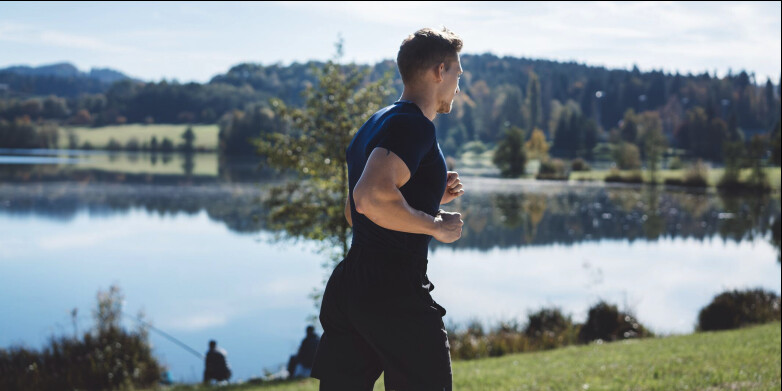
These are the famous zone 2 workouts—keeping your heart rate between about 70 and 80 percent of its maximum—that runners, smart gymgoers, and everyone with a podcast is talking about these days. Think of zone 2 as the range between easy and moderate cardio, where you can carry on a conversation but someone on the other end of a phone would know you’re not sitting down. (Find out more on how to know you’re in the zone by checking out the chart below.)
What happens in zone 2 powers up your endurance, your lifting routine, and your general performance as a human being, proponents say. Here’s what to know about the zone.
How an Easy Effort Brings You Gains
Endurance athletes, such as marathoners, cyclists, and Ironmen, have long understood that zone 2 training is a key to performing well on race day. Look at Eliud Kipchoge, the world’s fastest marathoner, who spends four days a week running in zones so low that any decent runner could keep up with him. Lower-zone training yields high results in endurance sports, says Mike T. Nelson, Ph.D., C.S.C.S., owner of Extreme Human Performance, possibly “because the athletes aren’t out there just trying to fry themselves crazy every single day.” A long Z2 effort today leaves room for more time on your feet or in the saddle the next day. But another huge perk of Z2 training, no matter your sport, is the adaptations your body is making deep within your cells.
It all goes back to your mitochondria, the parts of your cells that generate ATP—that’s the fuel that drives muscle contractions. With age, your mitochondria get kind of like old dog fur: sparse, damaged, and inefficient. “Zone 2 cardio basically helps build your mitochondria,” says Kenneth Jay, Ph.D., a sports scientist who’s done research with the National Research Centre for the Working Environment in Copenhagen. These workouts help you produce more of those cellular powerhouses and shed old, damaged ones. When you get out of that zone, you start using a different energy system that doesn’t stimulate mitochondria to the same extent.
These cellular improvements can help you make gains in lifting, too, by aiding your recovery between sets. People without healthy and plentiful mitochondria “just don’t have the capacity to regenerate ATP fast enough to repeat something. And what they are repeating is half the output of what they were doing at the beginning, so they’re not getting the stimulus that they could,” Nelson says.
Building mitochondria might not get you ripped, but it deserves a lot of cred given that “mitochondrial dysfunction” has been linked to cardiovascular disease, cancer, diabetes, and obesity. Shoring them up with Z2 essentially gives you a more efficient engine to get through life on. “It’s like a hybrid car,” explains Stephen Seiler, Ph.D., a professor of sports science at the University of Agder in Kristiansand, Norway, who’s studied the effects of high- and low-intensity zone training in athletes. Redlining your workouts saps battery power. “You can run off the battery for a little while, but to pay it back, you’ve got to have your main engine.” Consistent Z2 work not only helps you recover better between sets or workouts, but it also helps you get better at everyday challenges: a family hike, an extra-long-haul rush to your flight gate, or a grueling workweek.
Does Zone 2 Work Have to Be Cardio?
In general, yes. That’s because a big benefit of zone 2 cardio is that it helps keep your heart strong and, basically, stretchy. When you lift heavy, your heart’s left ventricle—the one that pumps oxygenated blood to the rest of your body—gets tough, too. Heavy loads make your heart contract in a way that causes it to lay down more muscle fibers. But it lays them down inside the chamber, so there’s less room for blood. (Don’t get smug, endurance folks; a huge amount of cardio makes yours too thin and can leave you vulnerable to issues like atrial fibrillation.) Zone 2 cardio moves blood through the heart in a way that keeps walls at a healthy thickness and stretchiness, so it functions better, says Jay.
There’s debate on exactly how much time you need in Z2 to get the benefits. If you’re mostly sedentary now, any amount of low-intensity movement will help. If you’re somewhat or very fit, experts typically promote a minimum of 30 to 40 minutes of zone 2 cardio twice a week. (For endurance athletes, 80 percent of total training volume in Z2 is a good guideline). The trick is not turning that cardio workout into a sprint endorphin rush. Once you start pushing the intensity, cellular by-products (lactate) begin to accumulate and a different energy-producing process starts to take over. And that’s not what you want to train in these workouts.
Zone 2 is chat-paced work, so bring friends. Fit people might need more than a casual walk; hiking and rucking uphill can get you there. Keep it interesting in the gym by giving ten minutes each to the rower, bike, and treadmill. The key is control. “There is a warrior aspect to this as well,” Seiler says. When you have the discipline to stay in the zone, “there can be a Zen there in going out and finding your rhythm and not be influenced by the person who runs past you that day,” he says.
When it comes to creating a more efficient engine, easy really does do it. It’s not like you can’t have go-hard-or-go-home workouts; you need those, too. But being smart about adding a little low can feed your high.
by Men’s Health
Login to leave a comment
5 Easy Ways to Drink More Water
Because staying hydrated doesn’t have to be complicated
We’ve all heard it before: Hydration is good for your health and athletic performance. The thing is, maintaining adequate water levels is easier said than done. Registered dietitian nutritionist Maya Feller says her patients report water as one of the hardest things to consume. “They either find it not desirable,” says Feller, “or they forget.”
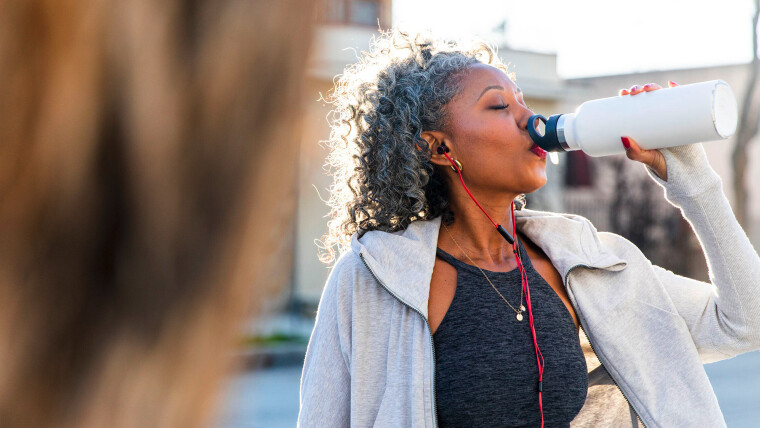
Jen Scott, a registered dietitian, nutritionist, and running coach, says that skimping on water can lead to a host of negative effects including, zapped energy, elevated heart rate, GI distress, diminished blood flow to your organs and muscles, decreased lubrication around your joints, and increased muscle fatigue and soreness. Or, as Feller puts it: “Without proper hydration, the body just does not function optimally.”
The right amount of hydration depends on a number of factors, including your activity level, overall health, and even the climate where you live, according to the Mayo Clinic. As a general rule of thumb, the Institute of Medicine recommends men consume 3.7 liters (15.5 cups) of water per day, while women should sip on 2.7 liters (11.5 cups).
But these benchmarks include water intake from all beverage types, as well as foods. A good barometer to aim for is half your bodyweight in ounces, Scott says. For example, a 160-pound person would shoot for 80 ounces (10 8-ounce cups). However, she tells active folks, like endurance athletes, to add additional fluid. Scott recommends sipping on two extra cups (16 ounces) before a workout, two cups after, and half a cup during for every 30 minutes of exercise.
For athletes, hydration should include not just water, but electrolyte replenishment, too, say Scott and Feller. Electrolytes are minerals such as calcium, potassium, and sodium that you lose when you sweat. Because electrolytes impact a number of bodily processes, including muscle function, it’s important to replenish lost stores through fluids like sports drinks, milk, coconut water, mineral water, and hydration aids. (Plain old water doesn’t have electrolytes.)
You’re likely well hydrated if you don’t often feel thirsty and your pee is clear or light yellow, according to the Mayo Clinic. That said, Feller recommends athletes work with a dietitian to come up with a fueling and hydration plan that works for them. “It needs to be individualized,” she says.
In the meantime, if you’re struggling to take in enough liquids, here are five simple, expert-recommended ways to boost your hydration.
Feller is a big fan of herbal teas–either warm or iced. “It doesn’t have to all be [plain] water to meet your fluid needs,” says Scott. Tea, in particular, may deliver additional health benefits. Sipping two to three cups a day is linked with reduced risk of total mortality, cardiac death, coronary artery disease, stroke, and type 2 diabetes, according to a meta-analysis of observational studies. The only caveat is that very hot tea (think: 131 to 140 degrees) is associated with esophageal and gastric cancers, according to the meta-analysis. It may be wise to let your mug cool slightly before drinking.
Some people just don’t like the taste of water. If that’s you, Scott recommends freshening things up by squeezing lemon juice into your H20 or adding a splash of fruit juice.
Another option is to make your own infused water: Add your favorite fruits, veggies, or herbs to the bottom of a pitcher. Then, pour water on top and let the flavor soak in. Feller is a fan of water infused with frozen berries as well as lime, cucumber, basil, and mint.
You can also level up your water by making flavored ice cubes. Simply add a favorite ingredient or two to an empty ice cube tray, then pour water over it and let it freeze. Feller recommends kiwi-lemon for a “tangy” taste. You can also try this recipe for raspberry-lemon ice cubes.
About 20 percent of your hydration comes from food sources, says Feller. “So really embracing plant-rich food sources is a great way to add to your hydration while still thinking about flavor and texture,” she says. Scott recommends nibbling on fruits and vegetables with a high-water content, like melons, oranges, grapefruit, grapes, celery, lettuce, tomatoes, cucumbers, and bell peppers. “Those things can all help boost your hydration,” she says. “Every little bit helps.”
Soups can be a warming, filling, and healthy meal choice. Broth-based soups, in particular, can help contribute to your hydration. As a bonus, soups can provide a dose of sodium, which is helpful for athletes who need to replenish those electrolytes, says Scott.
It sounds simple, but picking the right container for your water can make a difference. “I have some patients that have a lot of success with water bottles that have demarcations on them so they can see how much they consumed,” says Feller. One patient, she adds, finds motivation from drinking from a clear water bottle, since she can easily track her progress throughout the day.
by Outside
Login to leave a comment
Nijel Amos is trying to sell his 2012 Olympic silver medal
One week after Botswana’s Nijel Amos was handed a three-year ban for doping, he is now selling the Olympic silver medal he won in the 800m at the London 2012 Olympics.
Amos’ reason for selling his Olympic medal is to support his family. According to the BBC, the 29-year-old met with someone who wants to buy it for 4.5m Botswanan pula (USD $300,000), but Amos believes the value of his medal will double with the release of his upcoming documentary on Netflix, to be released later this year.
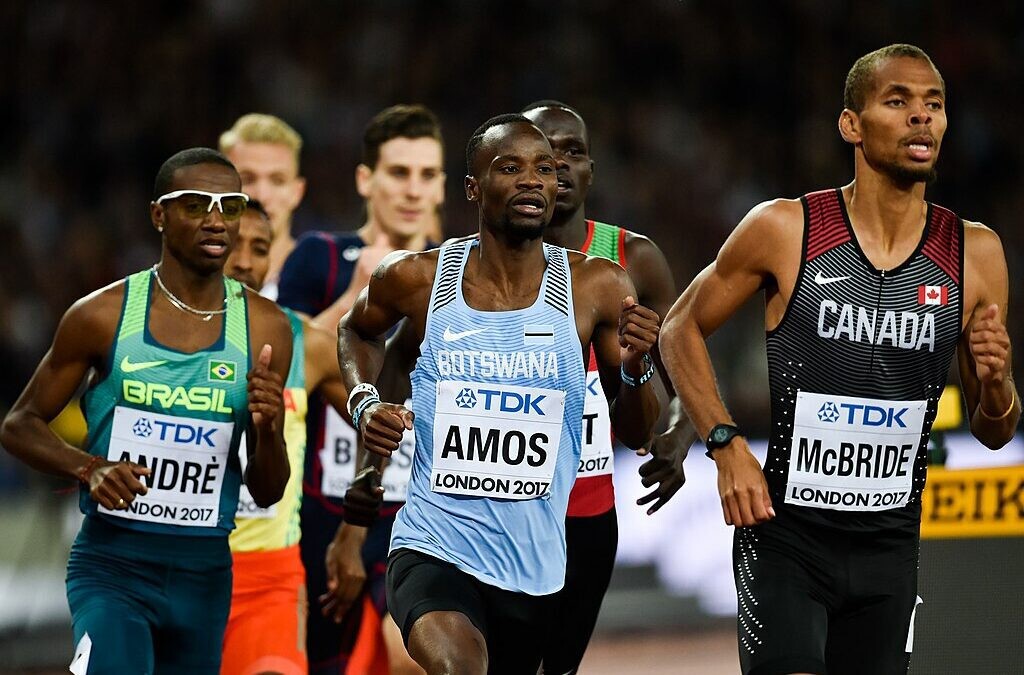
He finished second in the 800m behind world record holder David Rudisha of Kenya, making him the first Botswanan to win an Olympic medal in any event. Amos holds the third-fastest 800m time in history (1:41.73), and is one of only five men who have gone under 1:42.
The 800m runner was initially suspended in July 2022 after an out-of-competition test revealed a banned metabolic modulator, GW1516. Amos faced a four-year ban, but it was reduced to three years after he signed a letter of admission.

However, he is still fighting the case. “It has been a financially draining process,” Amos said in a statement. He has reportedly incurred $67,000 in legal fees and travel expenses.
Amos said it is difficult to survive in Botswana, where athletes are not given pensions or any lump sum insurance payouts.
GW1516 was originally developed to treat obesity and diabetes but is not approved for human use, since it was discovered to be carcinogenic. It is banned in and out of competition, and not eligible for a therapeutic use exemption (TUE).
by Marley Dickinson
Login to leave a comment
What is the best diet for runners?
As a runner, your diet plays an important role in your performance and overall health.
Eating the right foods can help you reach peak performance while avoiding injury or fatigue.
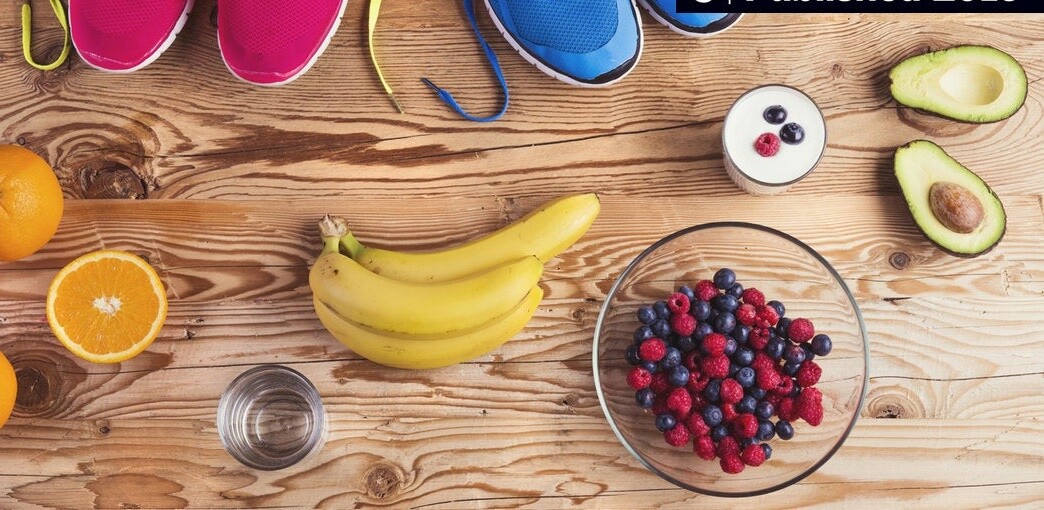
But with so many different diets out there, it can be difficult to figure out which one is best for runners.
In this comprehensive guide, we’ll discuss what makes up a healthy diet for runners and how you can tailor it to fit your individual needs.

We’ll also explore some of the most popular diets among runners—including plant-based diets, low-carbohydrate diets, and intermittent fasting—and explain why they may or may not be beneficial for athletes.
Finally, we’ll provide tips on how to get started with any new eating plan so that you can maximize its benefits and start seeing results quickly!
What Makes Up A Healthy Diet For Runners?
A healthy diet for runners should consist of a variety of nutrient-dense whole foods, including vegetables, fruits, lean proteins, and complex carbohydrates.
Eating these foods in the right amounts can provide the energy needed for running and help keep you feeling full longer.
Hydrating frequently with water or sports drinks is important to ensure that your body is properly fueled and hydrated during exercise.
Aim to consume 20-50 grams of protein per day and at least 5 servings of fruits and vegetables.
Runners should eat complex carbohydrates such as whole grains, legumes, nuts, and seeds for sustained energy levels throughout the day.
Lastly, incorporating healthy sources of fat like avocado, olive oil, nuts and seeds can help promote joint health and provide essential nutrients.
Eating a balanced diet that provides adequate amounts of these food groups will ensure optimal performance and good overall health for runners.
Popular Diets Among Runners
Runners can benefit from various types of diets depending on their individual goals and needs. Some popular diets among runners include plant-based, low-carbohydrate, and intermittent fasting.
Plant-Based Diets focus on eating primarily fruits, vegetables, legumes and whole grains while avoiding animal products.
Low Carbohydrate Diets restrict carbohydrates in favor of eating more protein and fat.
Intermittent Fasting involves periods of fasting and eating within specific windows of time each day, allowing for improved energy levels during runs.
All three types of diets can provide runners with improved performance, endurance, and recovery if done properly.
However, it is important to consult with a nutritionist or dietician before starting any type of diet in order to ensure that you are getting the necessary macronutrients and micronutrients for optimal health.
Plant-Based Diets
Plant-based diets are becoming increasingly popular among runners due to their potential health and performance benefits.
If you’re considering going vegetarian you can take a look at this quiz, and check the results. Maybe a plant-based diet is just for you.
These diets focus on eating primarily plant-based foods such as fruits, vegetables, legumes, nuts, seeds and whole grains while avoiding animal products.
Plant-based diets can provide runners with increased energy levels during runs and promote faster recovery post-run due to their high nutrient content.
These diets can help reduce the risk of developing chronic diseases like diabetes and heart disease by reducing inflammation, improving blood sugar levels, and lowering cholesterol.
When following a plant-based diet, it is important to focus on consuming varied sources of whole grains, legumes, fruits and vegetables in order to ensure that you are getting all the necessary vitamins and minerals.
Plant-based protein sources such as tofu, beans, quinoa, nuts, and seeds should be consumed regularly for adequate amounts of protein.
Lastly, incorporating healthy fats from avocados, olives, nuts and seeds can help promote joint health and provide essential fatty acids.
Eating a balanced plant-based diet can provide runners with improved performance and good overall health.
Low Carbohydrate Diets
Low Carbohydrate Diets are becoming increasingly popular among runners looking to lose weight or improve performance.
These diets focus on reducing carbohydrates while emphasizing the consumption of proteins and healthy fats.
They can help improve running performance by providing sustained energy levels without spikes in blood glucose and insulin.
Low-carb diets also promote fat burning, which can be beneficial for runners looking to lose weight.
When following a low-carbohydrate diet, it is important to focus on eating proteins from sources such as lean meats, fish, eggs, and legumes and healthy fats from sources like nuts, seeds, olive oil and avocado.
It is important to incorporate adequate amounts of non-starchy vegetables like broccoli, kale, spinach and cauliflower to provide essential vitamins and minerals.
While following a low-carb diet can help improve performance and aid in weight loss, it is important to ensure that you are getting enough carbohydrates for optimal performance and recovery after runs.
Intermittent Fasting
Intermittent Fasting is becoming an increasingly popular diet among runners looking to improve performance and health.
This type of diet involves fasting for certain periods throughout the day, while consuming all meals within specific windows of time.
During the fasting period, it is advised to avoid food and only consume water or other calorie-free beverages such as tea or coffee. This type of diet can help improve running performance by providing sustained energy levels and promoting fat burning for weight loss.
Intermittent fasting has been shown to reduce inflammation, improve insulin sensitivity and reduce cholesterol levels.
When following an intermittent fasting diet, it is important to ensure that you are consuming adequate amounts of macronutrients and micronutrients during the non-fasting window.
Consuming high-fiber foods can help keep you feeling nourished and energized throughout the day.
Intermittent fasting is a beneficial diet for runners who are looking to improve performance and health, but it should be done in moderation to ensure that you are getting adequate nutrients for optimal performance and recovery.
Final Word
Overall, there are many different diets that can be beneficial for runners.
Whether you choose to follow a plant-based diet, low carbohydrate diet or intermittent fasting plan, it is important to ensure that you are getting adequate amounts of nutrients and calories in order to promote optimal performance and good overall health.
By understanding how the human body reacts to specific foods, runners can optimize their nutrition plans for improved running performance and better recovery post-run.
Making small changes such as incorporating more plant proteins into your meals or reducing carbohydrates may make all the difference when it comes to improving your running results.
With these tips in mind, you should have no problem finding an effective dietary strategy that works best for you!
by Colorado Runner
Login to leave a comment
Want to Live Longer? One Study Says to Eat Like This.
It's no surprise that what people eat has an impact on their health, but trying to pinpoint exactly what diet out of the hundreds out there is most optimal for a long, healthy life can be overwhelming. A new study reports that there is no one optimal diet for longevity, but several general eating patterns that can shift life expectancy.
Published in the journal JAMA Internal Medicine, the study found that one can reduce their risk of an early death by nearly 20 percent by eating foods from one of four healthy eating patterns: A Mediterranean diet, a plant-based diet, the Alternative Healthy Eating Index and the Dietary Guidelines for Americans (more on those below). All four eating patterns emphasize whole grains, fruits, vegetables and legumes.
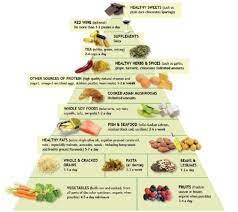
Professor and chair of Harvard's Department of Nutrition, Dr. Frank Hu, said in a statement, "It is critical to examine the associations between DGAs- recommended dietary patterns and long-term health outcomes, especially mortality."
Hu says there is a lot of flexibility when it comes to eating healthy and dietary choices can be tailored to individual preferences as long as they adhere to the basics of any of the four healthy eating styles. This means that even if you get tired of eating one way, you can switch over to another dietary plan. The study followed the eating habits of 75,000 women and 44,000 men over 36 years. Every four years, the participants would fill out questionnaires about what food they ate, and each person was scored based on how much they adhered to one or more of the eating patterns.
Participants who remained consistent with their healthy eating patterns could reduce their risk of dying from respiratory disease by 35 to 46 percent, cardiovascular disease by 6 to 13 percent and dying from cancer by 7 to 18 percent.
Most people are familiar with the Mediterranean diet and a plant-based diet, but what about the other half of the recommended four healthy eating patterns?
Alternative Healthy Eating Index
Developed by Harvard researchers, the Alternative Healthy Eating Index (AHEI) assigns ratings to foods for how well they prevent chronic diseases and illnesses including cancer, diabetes, heart attacks and strokes.
Some AHEI food choices include a variety of vegetables with a focus on leafy greens, four servings of fruit a day, whole grains, nuts, legumes and vegetable proteins like tofu, fish and healthy fats like olive oil. In following this eating pattern, it's suggested one avoids potatoes, refined grains, fruit juices and saturated fats.
Participants of the study who followed the AHEI eating pattern reduced risk of death by 20 percent.
The Dietary Guidelines for Americans (DGA) is a metric designed to measure diet quality by how closely one follows its recommendations: Focus on variety, nutrient density and portions, limit added sugars, saturated fats and sodium and avoid sugary beverages. The guidelines are less specific on what foods to eat, rather an outline on how to customize nutrient-dense meals, meeting dietary needs and staying within calorie limits.
Within this study, participants who followed this eating pattern had a 19 percent lower risk of dying.
by Trail Runner Magazine
Login to leave a comment
Should you run early or late? A new study has surprising findings
It’s a common debate among runners–is it better to run in the morning or in the evening? A new study concluded that exercising between noon and midnight could significantly lower insulin resistance compared to activity earlier in the day.
While more research needs to be done, the study raised some interesting points for those looking to manage blood sugar and prevent Type 2 diabetes.
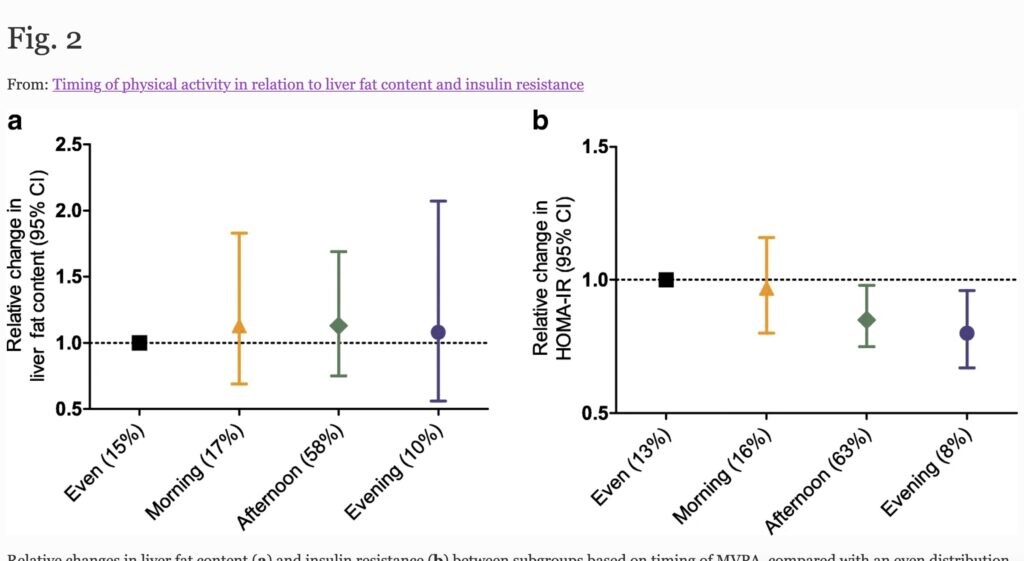
“Our aim was to investigate associations of the timing of physical activity and breaks in sedentary time with liver fat content and insulin resistance in a middle-aged population,” lead study author Jeroen van der Velde of Leiden University Medical Center told Healthline.
What is insulin resistance and why is blood sugar important?

Key to be aware of when it comes to prediabetes and type 2 diabetes, insulin resistance occurs when cells stop responding to insulin.
Food is broken down into blood sugar which then enters the bloodstream, signaling the pancreas to release insulin. Insulin helps blood sugar enter the body’s cells so it can be used for energy, and it signals the liver to store blood sugar for later use.
If a lot of blood sugar floods the bloodstream, the pancreas pumps out more insulin to get blood sugar into cells. Over time, cells stop responding to all that insulin—they’ve become insulin resistant.
The pancreas keeps making more insulin to try to make cells respond, but can’t keep up and blood sugar keeps rising. Prediabetes and type 2 diabetes are often the result of this perfect biological storm, according to the CDC.
High blood sugar is damaging to the body, and can also be a contributor to heart disease, vision loss, and kidney disease.
The study
Researchers analyzed data from a Netherlands Epidemiology of Obesity (NEO) study, which included men and women (between 45–65) who had a body mass index (BMI) of 27 or greater, meaning they were in the category of overweight or obese.
The more than 6,700 participants in the control group underwent a physical exam where blood samples were taken to measure blood glucose and insulin levels when they were fasting and after eating and were questioned about their lifestyles.
A random sample of 955 participants was given an accelerometer/heart rate monitor to use for four days and nights to monitor their movements. The day was divided into three blocks; 6 am to 12 pm, 12 pm to 6 pm, and 6 pm to midnight.
The proportion of total daily moderate-to-vigorous-physical activity (MVPA) that was recorded within each segment revealed the most active period.
The takeaway
The researchers discovered that for the participants in the study, exercising in the afternoon was linked to an 18 per cent reduction in insulin resistance compared to spreading activity throughout the day and exercise in the evening with a 25 per cent reduction.
Researchers also discovered that time spent doing moderate to vigorous physical activity reduced both liver fat content and insulin resistance.
van der Velde acknowledged that more scientific research needs to be done, and emphasized that for this study, he looked at differences in insulin resistance on a group level, among adults all within a certain cohort. Exercise at any time of the day is recommended and can be preventative for a wide variety of health problems.
by Keeley Milne
Login to leave a comment
Covid Completely Changed the Way We Stay Healthy—Here's How
Which hard-earned lessons about staying well have stuck.The height of the Covid pandemic was brutal. Three years after this all started, leading scientists tell us what hard-learned lessons have stuck when it comes to staying healthy now—and through whatever comes next.
Risk Management Is Huge

Before the pandemic, how often did you really think about defending yourself from respiratory bugs? “Most people were shrugging off the risk. Respiratory viruses weren’t that big of a thing,” says Amesh Adalja, M.D., an infectious-disease physician at the Johns Hopkins Center for Health Security. Covid forced us all to take viruses seriously on a daily basis, and it highlighted the power our personal habits—handwashing, masking, getting vaccinated, determining which indoor situations to take the risk on or not—can have over the likelihood of getting sick. Covid also made it clear that not managing risk had consequences beyond a tough stay in the hospital or, in mild cases, losing a few sick days. One 2022 study found that a person infected with Covid was 33 times as likely to suffer from a first-time arterial blood clot during the first week of infection as someone who had never had the disease. Respiratory viruses can trigger other real medical emergencies, and these compounding factors can damage major organs and raise your risk of autoimmune conditions. Even relatively mild Covid can cramp your breathing and gym stamina for months.
Vitamin D Is a Health Hero
Prepandemic, it was easy to think of vitamin D as a bone-building nutrient found in milk, and that was kind of it. But then Covid-era research showed a higher risk of testing positive for the disease among people with a vitamin D deficiency compared with people whose levels were fine. Experts suspected that optimal amounts of the vitamin may help shield you from Covid, as it does with other respiratory illnesses.
There’s no clear conclusion on that yet, says Eric Feigl-Ding, Sc.D., chief of the Covid-risk task force at the New England Complex Systems Institute. But doctors have long known that the nutrient plays a crucial role in immune health—and about one in three American adults is not getting enough.
Vitamin D helps your immune system “across the board,” says Feigl-Ding. It rallies parts of that system to get working against microbes, and it may also reduce inflammation—a process that plays a role in a huge number of health conditions, including cancer, heart disease, type 2 diabetes, Alzheimer’s, rheumatoid arthritis, and even depression.
If you already have enough vitamin D, extra won’t benefit you. (A blood test can tell you your level.) To stay at a healthy amount, aim for five to 30 minutes of midday, sunscreen-free sun exposure at least twice a week (your body uses it to make its own vitamin D) and eat D-rich foods. That’s salmon, trout, and fortified cow’s or plant milk. If you don’t eat these foods or get that much direct sunlight, consider taking a supplement as an “insurance policy” in the winter, Feigl-Ding advises.
Long Covid Is Helping Us Understand Other Illnesses
Even one of the pandemic’s most devastating and puzzling legacies, long Covid, may help drive up our understanding of health. This wide swath of troubles that linger for about half of people who’ve had symptomatic Covid—everything from joint pain to brain fog—may not end up being unique to this virus. And it’s creating a surge of interest in studying seemingly similar but often dismissed conditions like chronic fatigue syndrome (CFS) and post-treatment Lyme disease syndrome.
We’re still learning about long Covid, but among the theories about what causes these symptoms are organ damage, chronic inflammation (including of the central nervous system), and reservoirs of virus remaining in the body, Feigl-Ding says. These are some of the same factors scientists think may be involved in CFS.
Knowing more about long Covid could shed light on these other conditions, too, explains Dr. Adalja. What’s very clear, at least, is that “these illnesses are valid,” says William Schaffner, M.D., a professor of preventive medicine and infectious diseases at the Vanderbilt University School of Medicine.
The Basics Are a Big Deal
Health issues that develop over time, like stroke and type 2 diabetes, have been on the rise for years. About 60 percent of U. S. adults have at least one chronic illness, while four in ten have two or more. Yet until you’re diagnosed with one, the danger of chronic illness can feel far off.
Covid made it clear that people with chronic conditions were at a higher risk for severe illness, and it made people take an honest look at their health habits. Obesity, for instance, went from being “something I’ll get around to dealing with” to being a risk factor for complications from a scary new virus, says Dr. Schaffner. To clarify the synergy, Dr. Feigl-Ding tells people to “picture a glass.” Every risk factor—eating excess sugar, not exercising, not treating high blood pressure—adds water to the cup, while healthy habits decrease the water level. Covid can push the water over the rim and uh-oh.
The takeaway here is more of a reminder, really: You know what to do. You can prevent chronic illnesses by eating well, being active, avoiding tobacco, and being moderate with alcohol. Those small lifestyle habits may well save your life.
by Men's Health
Login to leave a comment
Cranberries Can Prevent UTIs, Support Performance, and Offer More Health-Boosting Benefits
This holiday staple offers more than festive flare.
If you’re only eating cranberries once a year, you’re missing out on a wide array of nutrients and creative dishes. Cranberries have adorned Thanksgiving and holiday tables for hundreds of years. But this naturally tart red berry has many culinary uses. Plus, cranberries are packed with vitamins, minerals, and antioxidants and have been shown to improve heart health, reduce inflammation, and may even enhance performance.
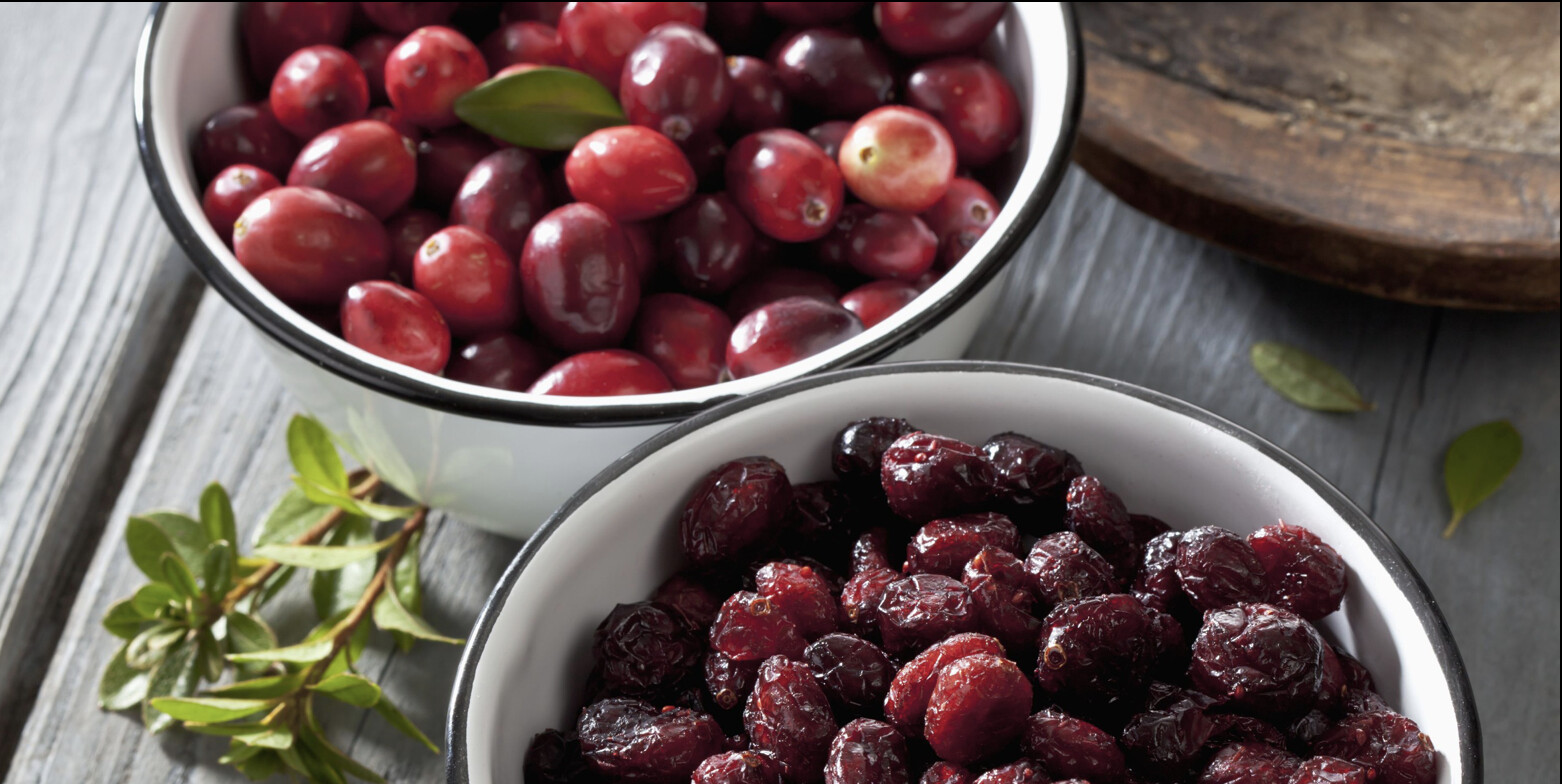
Not to mention that cranberries come in several forms—fresh, dried, and juiced—so you have multiple ways to add them to your diet.
Here, everything to know about cranberries’ benefits, including just how easy they are to add to your plate.
What nutrients will you get from cranberries?
Fresh cranberries are a good source of vitamin K and an excellent source of fiber and vitamin C. Beyond the nutrition label, they also have polyphenols or plant compounds that have been studied for their beneficial role in many health conditions.
According to the USDA, one cup of fresh, whole cranberries has:
46 calories
0.5 g protein
<1 g total fat
12 g carbohydrates
4 g fiber
4 g sugar
14 mg vitamin C
8 mg calcium
80 mg potassium
What are the health benefits of cranberries?
The Dietary Guidelines for Americans recommend two servings of fruit per day, thanks to the plethora of nutrients they offer. Cranberries, in particular, have been studied for their health properties, including these benefits:
1. They can lower your risk of chronic disease
“Cranberries are loaded with antioxidants, so they help defend your body against oxidative stress,” says Samantha Cassetty, MS, RD, plant-focused nutrition and wellness expert and co-author of Sugar Shock. Oxidative stress occurs when free radicals (cell-damaging compounds) outnumber antioxidants in the body.
Research links excessive oxidative stress to chronic conditions, including heart disease, type 2 diabetes, cognitive decline, and cancer. Recent research has found that eating cranberries boosts the antioxidant effect in the body and may fend off these conditions. “When you consume antioxidant-rich foods like cranberries, it helps to correct the imbalance [of free radicals],” adds Cassetty. The same research also points out the anti-inflammatory properties of cranberries—another important component of disease prevention.
2. They benefit your heart
“Cranberries provide numerous cardiovascular benefits,” says Lauren Harris-Pincus, MS, RDN, founder of NutritionStarringYOU.com and author of The Everything Easy Pre-Diabetes Cookbook . An abundance of research suggests that berries, in general, reduce (bad) LDL cholesterol, triglyceries and blood pressure, while increasing (good) HDL cholesterol.
“Additionally, cranberries may help improve the flexibility of your arteries,” says Cassetty. “When arteries become stiff, it can lead to high blood pressure.” The research suggests that cranberries can improve several risk factors for heart disease.
3. They prevent urinary tract infections
You’ve probably heard that cranberry juice can treat a urinary tract infection (UTI). While that’s not necessarily the case, cranberries have been studied for their role in urinary tract health. “Cranberries naturally contain the flavonoid, proanthocyanidin (PAC),” says Harris-Pincus. And it’s this flavonoid that likely blocks the buildup of bacteria and helps to prevent urinary tract infections.
A meta-analysis involving 23 studies and more than 3,900 participants backs up the claim that cranberries can help prevent UTIs in susceptible populations. The study found that those who drank cranberry juice had the biggest reduction in risk of UTIs, compared to those who took a capsule or tablet. In other words, having cranberries in your diet may stop UTIs before they start.
4. They may contribute to a healthy gut microbiome
“A growing body of [new] research suggests that the use of cranberries as part of a healthy diet can help maintain a beneficial population of gut microbiota,” says Harris-Pincus. Small studies in humans and animals show that eating cranberries may alter the gut microbiome in a positive way.
“Your microbiome regulates immune function, inflammation, cholesterol, blood sugar levels and mood, so it pays off when you have a healthy microbiome,” says Cassetty. Yet, more research is definitely needed before making general recommendations about cranberries and the microbiome.
5. They can support endurance performance
Fueling before a run is crucial for maximizing performance, and dried cranberries may be the perfect prerun snack. Packed with easy-to-digest carbohydrates (they have added sugar to improve palatability), they offer up energy for your muscles to maintain long miles.
In addition, the inflammation-fighting compounds in cranberries may help athletes recover faster.
The research on cranberries in the athletic population is lacking, but one study in rowers did find that supplementing with cranberry extract increased postexercise levels of antioxidants in the blood. This is important because strenuous physical activity can raise oxidative stress, and antioxidants can bring it down, as mentioned earlier.
How to add cranberries to your meals
“Cranberries are amazing because of their culinary versatility,” says Harris-Pincus. “Fresh, frozen, and dried cranberries are tasty assets to both sweet and savory dishes,” she adds. Here are some simple ways to add cranberries to your diet, from Cassetty and Harris-Pincus:
Bake cranberries into quickbreads, muffins, pancakes, and crumbles, because the sugar in the baked good will balance the tartness of the berries.
Use dried cranberries in nutritious dishes, like salads, roasted veggies, and grain-based bowls.
Add dried cranberries to a homemade trail mix made with popcorn and nuts.
Include fresh cranberries in baked oatmeal with a dash of maple syrup.
Create a cranberry compote in the microwave with fresh berries, water, your choice of sweetener and citrus. Enjoy it on waffles, pancakes, crepes, oatmeal, or as a sandwich spread.
Drop a few cranberries in a glass of champagne for a healthy garnish.
Add 1 to 2 tablespoons of cranberry juice to your favorite vinaigrette recipe for a tart pink dressing.
Replace the raisins with dried cranberries in your favorite childhood snack, peanut butter over celery, and make “red ants on a log.”
Combine cranberries with sweet potatoes and drizzle with maple syrup and olive oil. Roast for 30 minutes for a sweet and sour side dish.
The bottom line on the benefits of cranberries
Cranberries are affordable, versatile, and underutilized. Not only are they pretty to look at, but they are also good for your health. Whether you like them fresh, dried, or juiced, cranberries are worth adding to your meals. Incorporate them during heavy training seasons to get an added antioxidant boost.
by Runner’s World
Login to leave a comment
How Young Is Too Young to Lace Up for a Marathon?
A new paper looks at the available research and makes recommendations.
The world—running and not—had its eyes on the Flying Pig Marathon this past May after a 6-year-old boy completed the race with his family in 8 hours and 35 minutes.
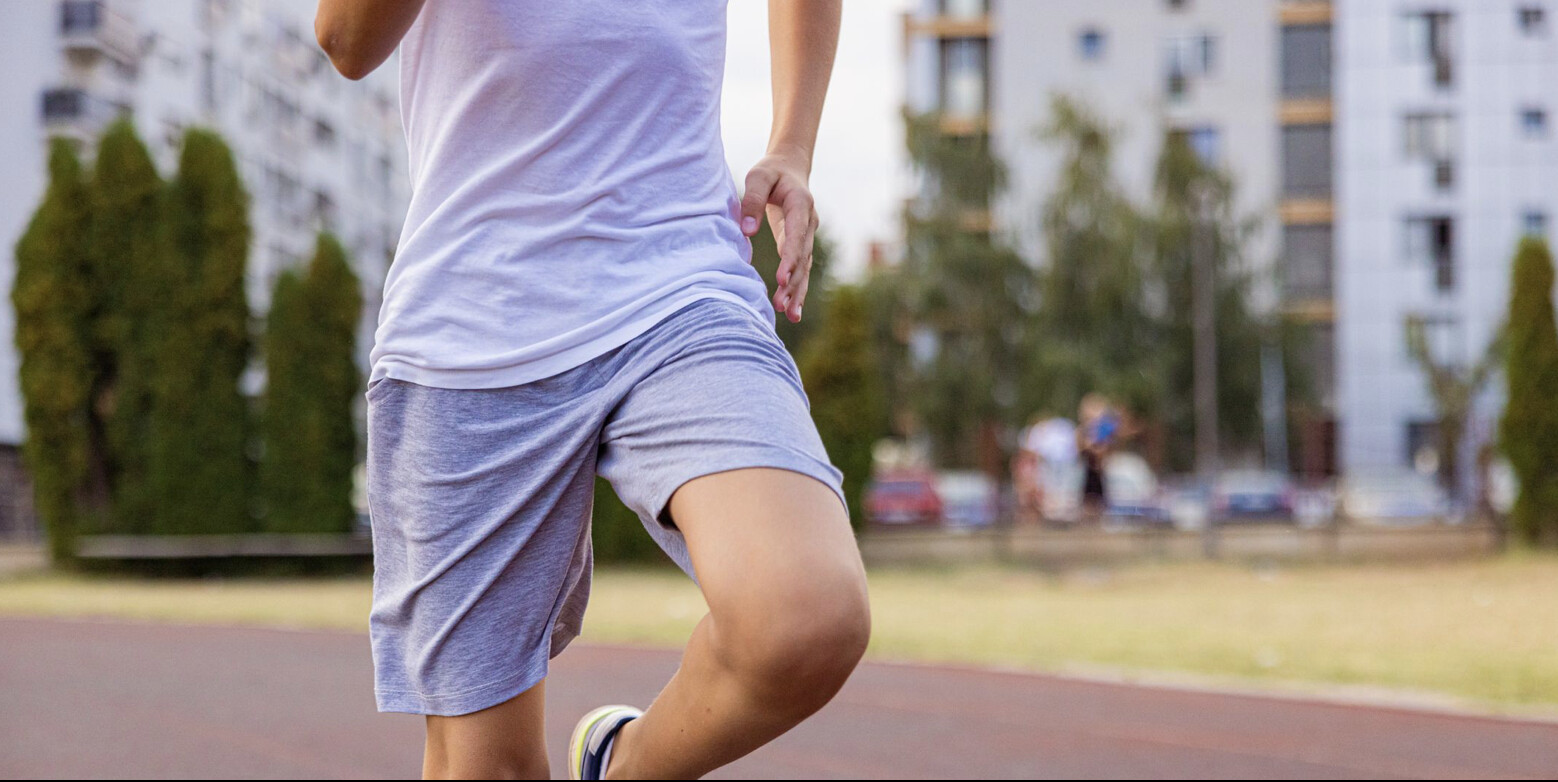
It wasn’t the finish itself that caused an outcry, but a subsequent social media post by the boy’s mother that references his distress during the later miles of the race.
The photo showed the boy holding a box of Pringles potato chips with the caption, “On the marathon course, Rainier knew they usually hand out Pringles around mile 20. He was struggling physically and wanted to take a break and sit every three minutes. After 7 hours, we finally got to mile 20 and only to find an abandoned table and empty boxes. He was crying and we were moving slow so I told him I’d buy him two sleeves if he kept moving. I had to promise him another sleeve to get him in the family pic at the finish line. Today I paid him off.”
Sports medicine experts and pediatricians got wind of the boy’s marathon finish, and its unique circumstances, and published a paper in JAMA Pediatrics in October, titled “Kids on the Run—Is Marathon Running Safe for Children?”
The answer is: We’re not totally sure.
“Youth running is becoming more popular, particularly at longer distances, and the trend is ahead of the research,” says Emily Kraus, M.D., a clinical assistant professor at Stanford University, a sports medicine physician at Stanford Children’s Hospital, and the director of the the Female Athlete Science and Translational Research Program.
Kraus, a runner, was not an author on the JAMA Pediatrics paper but coauthored the 2021 youth running consensus statement published in the British Journal of Sports Medicine.
“We can’t conclude that there’s no risk or minimal risk, or a greater risk [to young children running long distances],” she tells Runner’s World.
The paper looks back at the running boom of the 1970s when several young children completed marathons; children as young as 8 years old covered the distance in 3 hours and 31 seconds. The authors note that although there were no reports of injuries or adverse events, physicians and race directors started to worry about the potential dangers of youth participation. In 1981 the New York City Marathon, then in its 11th year, instituted a minimum age requirement of 16 years old. Other races followed suit.
A 2010 paper published in the Clinical Journal of Sports Medicine looked at data from the Twin Cities Marathon from 1982 to 2007, which included 310 children aged 7 to 17 years old. The researchers found that the risk of a medical incident was about 50 percent lower in children than adults but not statistically significant. In other words: We can’t say for sure if they’re at lower risk for injury or medical problem.
“Some of the early research shows that the overall risk of competing in races is quite minimal or lower when compared to the adult running population,” Kraus says. “But the question becomes is that because the number [of children finishers] is so much smaller?”
Kraus, who treats primarily middle-school age athletes whose growth plates are still open, expresses concerns that we don’t know if marathoning at a young age will affect long-term growth and development.
“Young kids haven’t even started to initiate [certain developmental] milestones,” she says. “Athletes who are younger than 10 or 11 years old are true children. We don’t know enough to give the okay, in my opinion.”
Kraus advises against the repetitiveness of a single activity over time, like running. Instead, she encourages young athletes to try different physical activities that lend themselves to multidirectional movement, like soccer, tennis, and old-fashioned tag.
When asked to give guidance on a distance for young kids, Kraus says anything up to a 10K is “probably okay.” Ideally, she says, we would measure how far a young kid runs on any given day during free play or team sports to help guide that recommendation.
“[For children], free play at that stage of their development is more valuable in developing motor skills, agility, and hand-eye coordination,” she says.
Plus, although research is clear that healthy behaviors developed during youth sports can promote long-term physical activity and reduce the risks of diseases like diabetes, cardiovascular disease, and cancer, “sport specialization during childhood does not provide competitive advantages and is not a requirement for elite status,” the authors wrote in the JAMA Pediatrics paper.
What’s more is that youth marathon or ultramarathon running may not lead to lifelong participation in running events or long-term health benefits. The authors wrote: “Among children who participated in ultramarathons [longer than a marathon], less than 25 percent continued to do so as adults, and less than 10 percent were still running ultramarathons 30 years later.”
Most youth ultrarunners, the researchers wrote, are between 16 and 18 years old, but there are runners younger than 10 years old who have completed an ultra event.
Experts are unsure if this drop off in participation is because of overuse injury and burnout, or changes in interests. The authors go on to say that potential health benefits and risks of youth marathon running have not been compared similarly to shorter distance running or other sports.
But pediatric specialists like Kraus and the authors point out that the bigger question and concern when it comes to youth marathoning, particularly in children under 10 years old, is the intrinsic motivation of a young runner.
“Why is this child racing? Is it because they have a family of runners and they don’t want to feel left out? Is it something they deeply want to do?” Kraus asks, noting that young children likely don’t fully understand what training for and running a marathon really entails.
“If I were working with a 6-year-old, my conversation would be, ‘Do you know what [a marathon] is? Do you know what it feels like to run one mile? Or other shorter distances?’” Kraus says.
She’d then also work with families to understand why they were having a young child participate in such an extreme distance at this particular time, suggesting, instead, to use a marathon as a goal for years down the road.
Based on the available evidence, the authors developed a list of points families should consider before a young child runs a marathon or ultramarathon, in addition to assessing the physical health of the child, including:
Potential risks and benefits, reiterating there is limited available research
Determine the motivation for marathon running, with an emphasis on voluntary participation
Inform children that they have a right to stop at any point and will not be punished or experience negative consequences if they decide to stop
Discuss ways children can communicate their choice to parents and guardians
Monitor physical, psychological, social, and academic well-being, as well as continued commitment to marathon running during training
“For a 6- or 7-year-old who hasn’t fully captured goal-setting and follow-through, a marathon is a different type of challenge that goes beyond what they’re capable of handling,” Kraus says.
by Runner’s World
Login to leave a comment
Running Really Can Keep You Young
Consistently running for exercise seems to slow down the aging process and allows older people to move more easily, according to a new small-scale study of exercise and aging. The study's findings suggest that older adults who regularly run for exercise are better walkers than even those older adults who regularly walk for exercise.
"The bottom line is that running keeps you younger, at least in terms of energy efficiency," said University of Colorado Associate Professor Rodger Kram, a co-author on the study, in a written release.
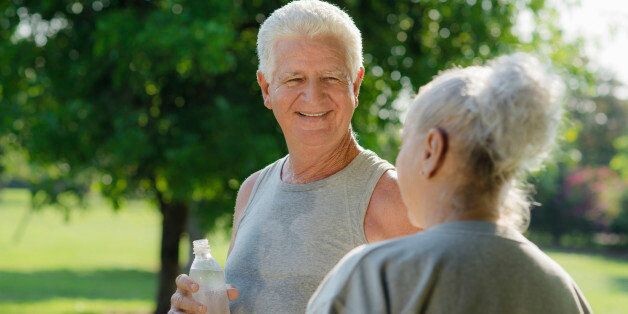
For the study, published online Thursday in the journal PLOS ONE, researchers studied 30 healthy older volunteer adults (15 males and 15 females) with an average age of 69 who either regularly ran or walked for exercise. The volunteers all had been either running or walking at least three times a week for a minimum of 30 minutes per workout for six months or longer. The volunteers walked on a force-measuring treadmill at three speeds: 1.6 mph, 2.8 mph, and 3.9 mph. In order to help evaluate the energy expended, the researchers measured each participant's oxygen consumption and carbon dioxide production during the testing sessions.
"What we found is that older adults who regularly participate in highly aerobic activities -- running in particular -- have a lower metabolic cost of walking than older, sedentary adults and also lower than seniors who regularly walk for exercise," said Humboldt State Professor Justus Ortega, the lead author on the study, in a release.
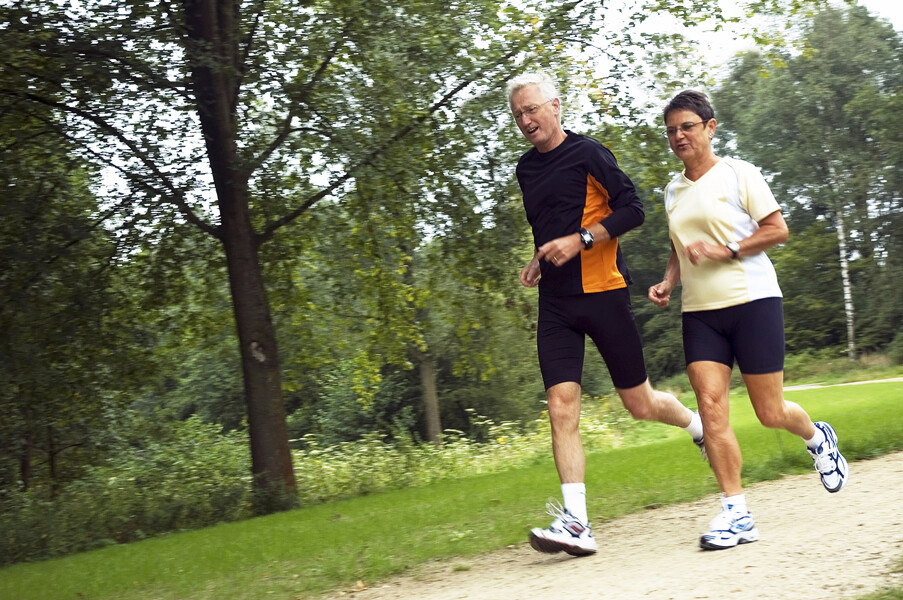
"It's been known for a long time that as people age their maximum aerobic capacity, or 'horsepower,' declines, and that is true for runners as well," said Ortega. "What's new here is we found that old runners maintain their fuel economy."
Researchers said it was surprising to find that older adults who regularly run are better walkers than even those older adults who regularly walk, noting that those who run enjoy a better quality of life because of their ability to move around more easily.
"Walking for exercise has many positive health effects, like fending off heart disease, diabetes, weight gain and depression -- it's just that walking efficiency does not seem to be one of them," Kram said. "Because we found no external biomechanical differences between the older walkers and runners, we suspect the higher efficiency of senior runners is coming from their muscle cells."
For years, researchers have been studying the effects of running and walking with an eye towards determining whether one is preferable to the other in terms of health benefits. One study from 2013, for example, found that running is a better way to achieve weight loss than walking. Another study, though, found that walkers fare better than runners when it comes to the risk of developing heart disease.
In the end, any kind of exercise appears to be at least somewhat beneficial as a person ages. In May 2014, for example, findings from the longest-running clinical trial on the relationship between physical activity and aging in older adults were revealed, naming daily exercise, sustained over several years, as the best way to age healthily.
So what are you waiting for? Get out those gym shoes and start moving!
by Shelley Emling
Login to leave a comment
What Is the Average Walking Speed and Jogging Speed?
Plus, how to pinpoint the pace that works for you.
Getting started with a new walking or jogging routine can be exciting and a little nerve wracking. It’s only natural after a walk or two to wonder, “Am I doing this right? Am I walking fast enough? Should I be jogging or running, instead? How do I compare to other walkers and joggers? What even is the average walking speed?”

Before you get too caught up in the comparison game, remember that any walk or jog you do is better than doing nothing at all. In fact, increasing your daily step count (regardless of pace) can help improve overall health and reduce the risk of chronic diseases like heart disease, diabetes, and even some cancers. So you’re doing your body good no matter your speed or intensity.
That said, knowing how to gauge your progress and make improvements to your walking and jogging speed over time can lead to more advantages. So here’s what you need to know about the average walking speed and jogging speed, as well as when and how to change up your own pace.
The average walking speed and jogging speed in the United States
First and foremost, it’s important to recognize that “average walking speed” and “average jogging speed” are just that—the average. That means some people go faster, and others slower. So when you’re just starting out, it’s important to pay attention to how you’re feeling on your walk or jog, rather than getting caught up in what you should be doing based on averages.
Also, it’s important to note that averages are different for males and females, and that average walking speed and jogging speeds tend to slow with age. In other words, a 20-year-old man is likely to walk faster than a 60-year-old, and may walk faster than his 20-year-old female counterpart, as well.
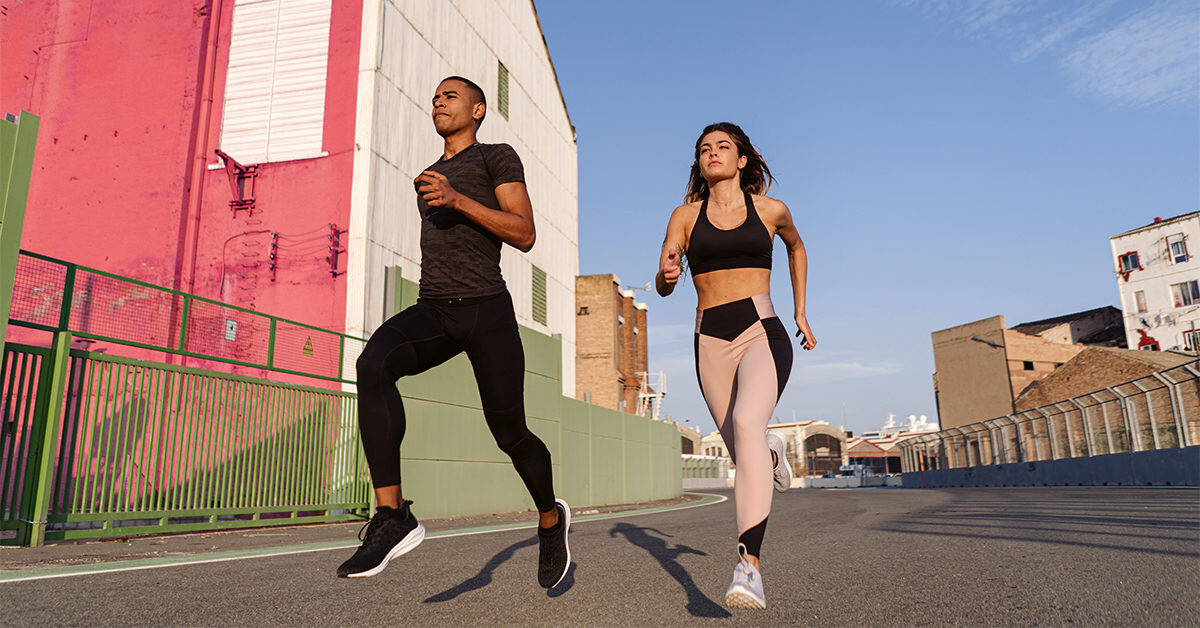
What the research says about average walking speed
In a 2011 study published in PLOS ONE, researchers used accelerometer data to measure the walking speed of participants in their day-to-day life. The results found that participants walked between 2.3 and 4.6 miles per hour, with a median walking speed of about 2.8 miles per hour. Of course, this is just a single study, and it measured walking in everyday life, which could vary from ambling slowly from the couch to the refrigerator to speed walking to an elevator to catch it before the door closes.
A systematic review and meta-analysis published in 2021 in the journal Sports Medicine, researchers looked at outdoor walking speeds across 35 different studies. Based on the results, researchers broke the average speeds down into categories of slow, usual, medium, and fast, with results averaging 1.8, 2.9, 3.3, and 3.8 miles per hour, respectively.
So if you’re using national averages to assess how fast you should aim to walk while exercising, anything from about 2 to 4 miles per hour is a good goal, depending on your fitness level and age.
What the research says about average jogging speeds
When it comes to jogging, judging averages is a little trickier simply based on the idea of “what are we averaging?” Most people don’t just jog around in daily life, unless they’re trying to run to catch a plane, stop their child from running into the street, or the like. So the information available is largely gathered from compilations of data found on fitness and running apps. This means it’s from people who are jogging (or walking or running) for distance on a regular basis, biasing the sample size toward those who are more consistently training for distance running, rather than an average that includes all possible demographics (like perhaps the less-competitive newbies).
This is further confused by the fact that “jogging” and “running” are technically two different things. Jogging is typically considered speeds between 4 to 6 miles per hour (a 10- to 15-minute mile), while running is considered anything faster than 6 miles per hour (a 10-minute-per-mile pace).
That said, based on stats released by Strava in 2017, the average speed to complete a mile was 9:48—that’s slightly more than a 6-mile-per-hour pace, which technically crosses over into the “running” category of speeds. In other words, this implies the data gathered skews more toward runners than joggers, further highlighting that it’s hard to pinpoint an “average” speed when it comes to lower-intensity jogging because it’s hard to find a good data set.
The 2021 Strava report points to a similar average pace, based on the average run length and distance. So if you’re just getting into jogging, aiming for any speed between 4 to 6 miles per hour is a good bet. And if you gradually want to work your way into running at faster speeds, know the average pace tends to hover just above 6 miles per hour.
How to find your ideal walk or jog speed
Averages mean very little when you, an individual, are starting a walking or jogging routine. It’s most important to find a pace that works for you, rather than to worry about what is or isn’t the “average.” And finding a good speed takes a little trial and error.
Here’s how to help you find what works for you:
The “Halfway Test”
“My personal favorite tip for finding your perfect pace is the ‘halfway test,’” says Erin Beck, C.P.T., director of training and experience for STRIDE Fitness. “The first half of your walk should feel like, ‘Hey, I got this. I could keep this up for a while.’ Once you hit halfway (either of the time you’ve set aside for your walk, or your halfway distance), you should start to feel like, ‘Uh-oh, I may not have this. I’m going to need a break pretty soon!’”
This is essentially a reminder not to start out too fast and furious—it’s okay to pick a doable pace, as long as you do a mid-point check-in. “If you’re starting to feel tired halfway through, try to hold your speed for the second half. Or, if your heart rate is still fairly calm and you think you can increase your speed, go for it,” Beck says.
If the “halfway test” feels a little nebulous to you, it’s not the only way to self-monitor your speed. In fact, there are a couple other good ways to do so, whether you’re walking or jogging.
The “Talk Test”
“With my clients, I like to use a cue I call ‘conversational pace,’” says Heather Hart, RRCA-certified running coach and co-founder of Hart Strength & Endurance. “I tell them to imagine they’re running with a friend they haven’t seen in a long time, and they’re catching up with a conversation. They should be running (or walking) at an effort where they can speak in short sentences, without feeling winded or out of breath.”
This is a particularly helpful way to gauge your intensity if you are, in fact, walking or jogging with a buddy. Without having to clock your speeds or pay attention to distances or times, you can determine whether you’re maintaining a reasonable pace.
Rate of Perceived Exertion (RPE)
To determine a good walking or jogging speed for you, Hart also suggests considering your personal rate of perceived exertion, or RPE. This is a sliding scale of exertion based from 1 to10. “One is fast asleep in bed. Three is a super fast walk to try and get to your gate on time at the airport (but there’s no need to run). Seven is ‘this is a pretty hard run, but I can keep going for a little longer.’ Ten is running for your life from a bear,” explains Hart. That basically means your “sweet spot” for a walk or jog should range from a 3 to 6, and if you’re jogging, specifically, “a good easy pace to build endurance is usually around a 4 to 5,” says Hart.
Increasing your average walking or jogging speed—the right way
Maybe you want to walk faster, or maybe you want to gradually move from a walking workout to a jogging routine—either way, there are two factors that play a role. This includes when you should increase your speed, and how you should go about doing it.
When to increase your walking or jogging speed
One of the best ways to end up injured is to start doing too much, too soon when it comes to your workout. Increasing your speed, distance, or even the number of workouts you’re doing each week before your body is ready for it won’t do you any long-term favors.
“I prefer to have my new clients build up to the point where they’re comfortable with three to four workouts a week, for around six to eight weeks, before incorporating speedwork,” says Hart. And while she’s referring specifically to jogging or running clients, she emphasizes that the same parameters apply to walkers. “This allows the client time to begin making the physical adaptations necessary before adding the increased stress of speed. It also gives them time to work on fine-tuning other aspects, such as finding the right shoes, becoming familiar with pacing and effort, and feeling comfortable with form.”
If, after six to eight weeks of consistent walking or jogging workouts, you’re starting to feel like your workouts are getting easier, and you’re getting better at gauging your effort, you might want to consider adding some speed sessions to your weekly schedule to help bump up your personal average pace.
How to safely increase your walking or jogging speed
Once you’ve determined you’re ready for speed work, embrace the mantra, “slow and steady.”
“When clients are ready to start speedwork, we start small,” emphasizes Hart. How she does that: “One speed workout per week that includes a sufficient warmup and focuses on shorter, faster intervals. This workout does not have to be long or taxing.”
It’s important to remember “speedwork” and “faster intervals” are all relative to your starting point. “For beginners, it’s a great idea to just start by incrementally increasing the amount of time you set out to jog (or walk faster) versus your standard pace. The faster intervals should still be at a fairly easy pace. When you start to feel winded, it’s a good idea to switch back to your original speed, until you feel ready to speed up again,” says Serena Marie Hunt, RD and RRCA-certified running coach.
If you need a little more guidance on how to go about implementing intervals, Hunt suggests a loose form of Fartlek training. “Fartlek runs (or walks) can be done by simply choosing a point in the distance and speeding up to reach it. You should feel tired but not totally exhausted when you complete your interval,” she says. You repeat that push to a tree, car, or other landmark a few times throughout your workout, allowing recovery intervals in between, before you wrap it up.
The benefit of adding “bursts” of speed to your walks or jogs
Keep in mind: More speed isn’t necessarily better, and small, consistent changes will really pay off, both for your performance, and your health. In fact, even if you’re having a hard time meeting walking goals related to distance or time (like 10,000 steps per day, or 30 minutes of activity per day), implementing occasional bursts of increased walking speed may carry many of the same health benefits, according to a study published in the journal JAMA Internal Medicine and another in JAMA Neurology.
The first study focused on daily step count and walking intensity and the associated risk of incidence of cardiovascular disease and cancer, as well as mortality from these conditions and all-cause mortality; the latter focused on daily step count and walking intensity and its association with incident of dementia. Both examined UK Biobank data, which involves more than 78,000 individuals.
“Walking pace is tied closely with intensity, and this is tied to heart rate. Walking at a faster pace will lead to an increase in intensity. For adults who may not be very active, increasing walking intensity (pace) for short periods during the day can improve aerobic capacity,” explains Matthew Ahmadi, postdoctoral research fellow at The University of Sydney’s School of Health Sciences and an author on both JAMA studies.
Ahmadi says the goal should be to walk a little faster than your comfortable walking speed. “This can improve your overall cardiovascular health which will lower your risk for cardiovascular disease, [it will] help maintain brain health by lowering the risk for vascular dementia, and [it will] improve body inflammation and immune responses, which can lower the risk for cancers,” he explains.
In other words, a little bit of effort, and a slow and steady approach to your walking or jogging program, can go a long way.
The bottom line on average walking speed and jogging speed
While knowing the general population’s average walking and jogging speeds can help motivate you to move more, it’s smart to focus on your own average pace and consider working to improve upon that pace. The key, though, is gradually getting faster.
“One of the biggest mistakes I see new exercisers making is making all of their workouts too difficult. It’s incredibly important to include recovery and ‘easy’ days, so that in turn, you can make your harder workouts hard enough. The recovery aspect of training is equally as important. Those who make the most progress are those who truly learn the discipline to go easy when they need to,” Hart says.
by Runner’s World
Login to leave a comment
Why Am I Tired All the Time? We Have a Few Answers
We all have days that drag. But if you’re tired more often than not, it could be for one of these reasons.
It’s perfectly normal to feel groggy upon waking. It’s simply a phenomenon known as sleep inertia that requires you some time for your energy to kick in and our body and brain to feel awake. “Hardly anyone feels fantastic when they first wake up,” says Scott Kutscher, M.D., board-certified neurologist and associate professor of sleep medicine at Stanford University. However, people typically perk up over the next 30 to 60 minutes, he says.
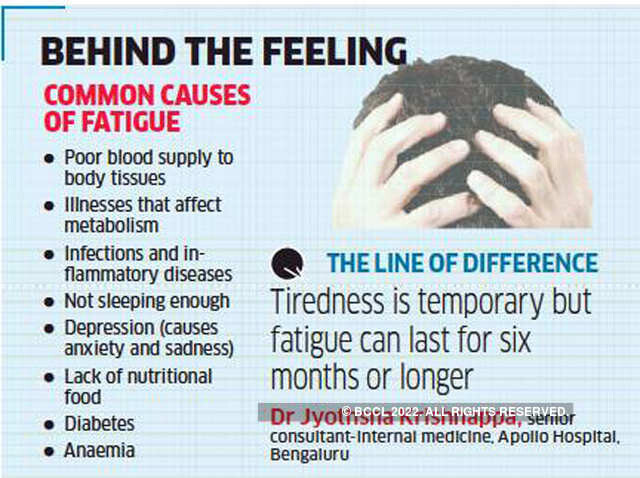
So, if you’re constantly tired several hours after leaving your bed, you might have a problem.
How to Know If Feeling Tired All the Time Is a Problem
We all have days—or even weeks—where we can’t seem to perk up. Blame it on an unusually heavy workload, a jump in running mileage, travel, or any number of other factors that can make the day drag.
Unfortunately, figuring out when tiredness is a problem can be tricky. “Tiredness is a subjective experience, so it’s up to each person to feel for themselves when tiredness is interfering with their life,” Kutscher says.
If you notice that you’re more tired than normal, look at your diet and lifestyle habits. “Diet is very important, and sometimes forgotten as the reason why people may feel tired all the time,” says Eric Ascher, D.O., a family medicine physician at Lenox Hill Hospital in New York City. “Sometimes, adjusting the diet to focus less on sugar and processed foods will improve fatigue.”

Staying well-hydrated throughout the day and prioritizing good sleep hygiene may help, too.
If you don’t feel perkier after two weeks of making lifestyle changes, Ascher suggests making an appointment to see your primary care physician. He or she will likely run blood tests to check for nutrient and hormone deficiencies, and screen for health conditions that cause fatigue, Ascher says. If it turns out that you do have a health issue, your doctor will be able to refer you to a specialist for treatment.
6 Reasons You Might Be Tired All the Time
While it is normal to feel tired, sometimes it can be something more serious. In fact, fatigue is a key symptom of the following health conditions.
1. Sleep Apnea
Sleep apnea is a potentially serious sleep disorder in which your breathing repeatedly starts and stops while you sleep. It’s also incredibly common, Kutscher says. In fact, an estimated 26% of adults between the ages of 30 and 70 have sleep apnea, per the American Academy of Sleep Medicine.
Sleep apnea can happen if the throat muscles relax (known as obstructive sleep apnea), if the brain doesn’t send proper signals to the muscles that control breathing (central sleep apnea), or a combination of the two (complex sleep apnea syndrome), per the Mayo Clinic. In any case, the result is broken sleep.
“Our bodies don’t like interrupted sleep, so someone whose sleep is very interrupted is going to go through their day feeling as though they had poor sleep the night before,” Ascher says.
2. Autoimmune Disease
Autoimmune diseases like lupus, rheumatoid arthritis, and type 1 diabetes occur when your immune system mistakenly attacks the healthy cells of your organs and tissues. While symptoms vary depending on the disease, fatigue appears in all of them. In fact, fatigue is often the most debilitating symptom for people with autoimmune disease, notes Harvard Health.
“When someone has an autoimmune disease, their body is in an inflammatory state, and that puts a lot of stress on the body,” Ascher explains. That’s why you might feel tired all the time.
3. Iron-Deficiency Anemia
According to the National Heart, Lung, and Blood Institute (NHLBI), iron-deficiency anemia is a condition that develops if you don’t have enough of the mineral iron in your body. Iron is part of red blood cells, a protein that carries oxygen throughout your body and helps your muscles store and use oxygen. Without enough iron, your blood can’t deliver enough oxygen to power your body, leading to tiredness and fatigue, the NHLBI explains.
Certain conditions can make it hard for your body to absorb iron, including celiac disease, ulcerative colitis, Crohn’s disease, and kidney disease. If you have one of these conditions, you may develop iron-deficiency anemia. However, iron-deficiency anemia can also occur if you lose blood. People with bleeding in the gastrointestinal or urinary tract, traumatic injuries, or heavy menstrual periods have a higher risk of iron-deficiency anemia, per the NHLBI.
4. Depression
Depression is a common mood disorder that affects your feelings, thoughts, and actions. You may feel persistently sad and hopeless, lose interest in normal activities, and/or feel anxious, notes the Mayo Clinic. At the end of the day, depression will cause you to feel fatigued more often than not, Ascher says.
It doesn’t help that people with depression have a higher risk of sleep problems—75% have trouble falling asleep or staying asleep, per Johns Hopkins Medicine.
5. Type 2 Diabetes
Type 2 diabetes is a chronic condition that happens when your body doesn’t respond to insulin, a hormone that lets blood sugar into your body’s cells to use as energy, per the CDC. When your cells don’t respond to insulin (called insulin resistance), sugar builds up in your bloodstream, eventually leading to type 2 diabetes.
Fatigue is one common symptom of type 2 diabetes, and may even stick around after you’ve gotten your blood sugar under control, per an August 2018 editorial in Diabetes Therapy. There may be several reasons for this, from lifestyle and nutrition choices to the mental energy needed to manage diabetes on a daily basis to the hormonal changes that come with type 2 diabetes, researchers say.
6. Hypothyroidism (Underactive Thyroid)
Your thyroid is a small, butterfly-shaped gland in the front of your neck that makes thyroid hormones. “These hormones regulate many different things, from metabolism to temperature,” Ascher says.
For some people, the thyroid gland doesn’t make enough thyroid hormones—a condition known as hypothyroidism (underactive thyroid). “If your thyroid is underactive, you may feel sluggish and tired, because your thyroid isn’t producing enough hormones to keep up with your body’s needs,” Ascher explains.
by Runner’s World
Login to leave a comment
Israeli man runs Berlin Marathon with pineapple on his head
There were several outstanding performances at the 2022 Berlin Marathon, but the oddest of them all has to be from Moshe Lederfien of Israel, who ran the entire Berlin Marathon while balancing a pineapple on his head.A clip of Lederfien went viral on TikTok after he was seen at multiple checkpoints, running along with an actual pineapple on his head. You have to appreciate his talent, as there is no visible tape or device that held the fruit in place.
Although Lederfien finished several hours behind world record holder Eliud Kipchoge in 5:04:25, he runs with a pineapple on his head to bring people together. Berlin marked his 12th marathon running with a pineapple.Lederfein, 68, served for Israel during the Yom Kippur War in 1973 and began running marathons at age 53. Lederfein never thought he could run, as he suffered from diabetes and high blood pressure.

He is also quite the celebrity in Israel and has a short documentary about him as the pineapple marathoner. He even goes by pineapple marathon runner on his social media pages.
by Running Magazine
Login to leave a comment
Thirteen Benefits of Running That Make You Healthier and Happier
Never been a fan of running? This list might just change your mind. Start chasing these awesome benefits of running.
1.- Good for Your Heart
So, why exactly is running good for you? For starters, running is the king of cardio. Running even five to 10 minutes a day at a slow speed is associated with a drastically reduced risk of death from cardiovascular disease, according to a landmark study in the Journal of the American College of Cardiology. Regular runners have half the chance of dying from heart disease compared to those who never run. Every time you run, you decrease your resting heart rate, so your heart doesn't need to work as hard, says Greg Justice, an AFAA-certified personal trainer, exercise physiologist, and founder of AYC Health & Fitness in Kansas.
2.- Gets You (Runner's) High
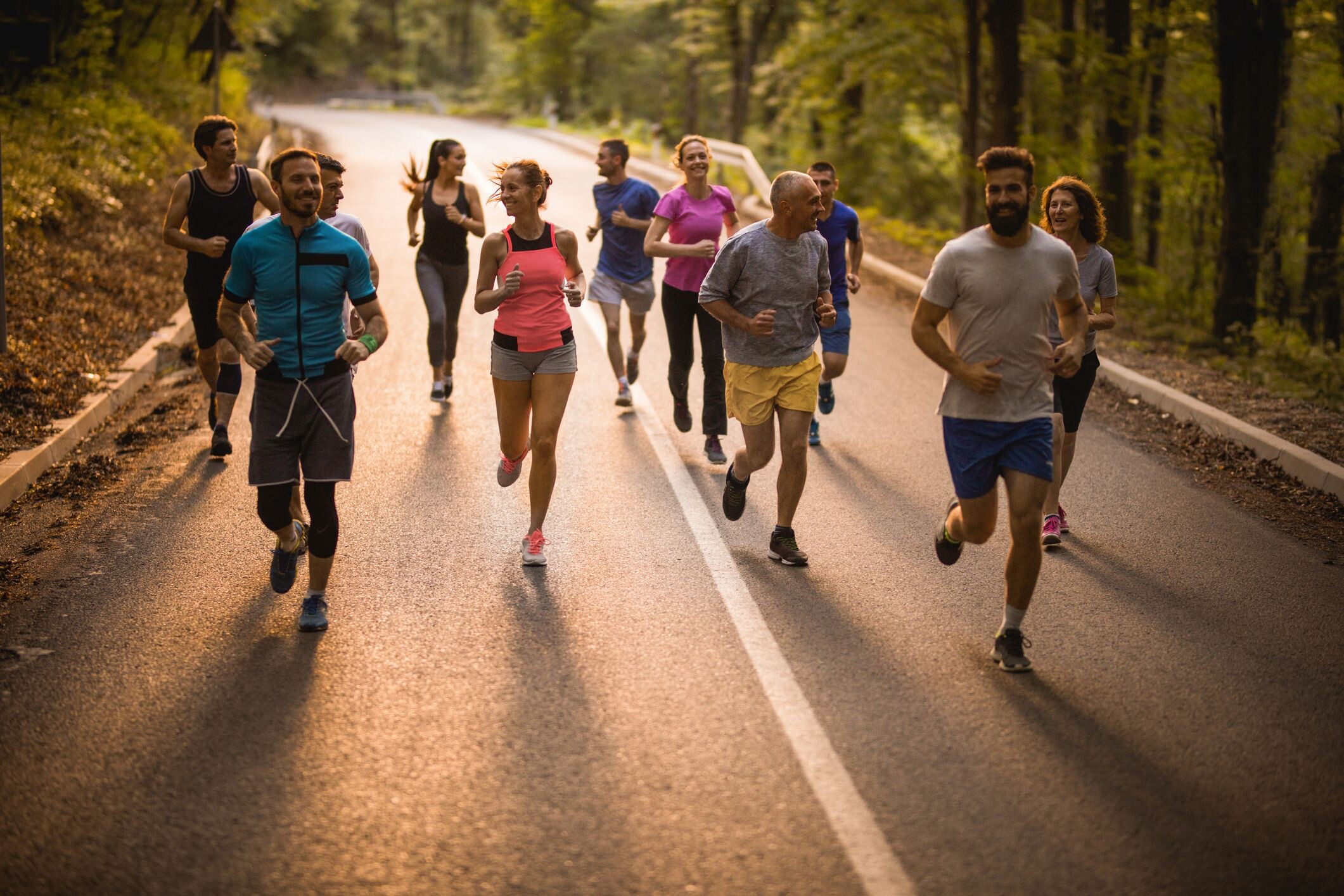
One of the biggest benefits of running is its mood-boosting effects. When you run, your brain pumps out two powerful feel-good chemicals — endorphins and endocannabinoids — explains Justice. The latter sounds a lot like cannabis, right? That's for a reason. Chemically, the endocannabinoids your body produces during a run aren't all that different from marijuana's mood-altering chemical, THC. The most studied mid-run endocannabinoid, called anandamide, was actually discovered when scientists were trying to figure out how weed gets people high. (Related: Drug, Medicine, or Something In Between? Here's What You Should Really Know About Weed)
3.- Strengthens Your Joints
A Medicine & Science in Sports & Exercise study of nearly 75,000 runners and walkers found that, nope, running doesn't up the risk of osteoarthritis — even people who cover 26.2 miles (aka a full marathon distance) on the regular. In fact, runners were half as likely to suffer from knee osteoarthritis compared with walkers, according to the study results.
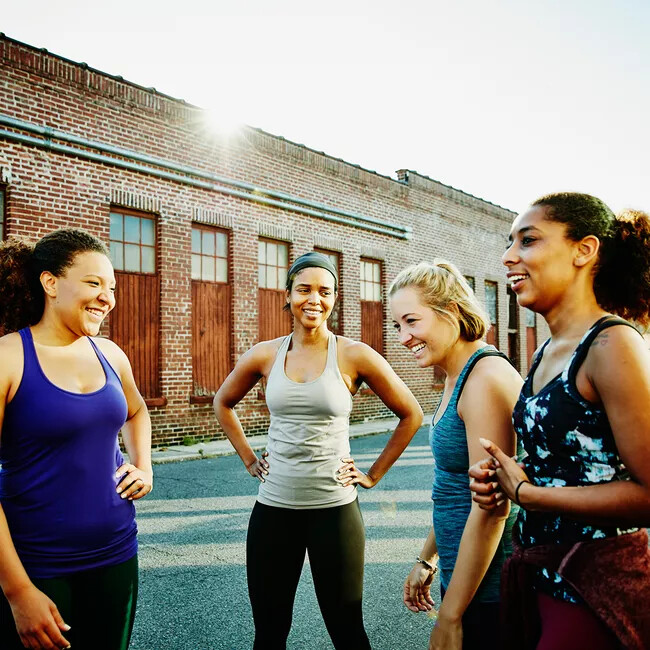
Every time you pound the pavement, you stress your bones and cartilage, just like you do your muscles, causing them to spring back stronger, explains Janet Hamilton, C.S.C.S., an exercise physiologist with Running Strong in Atlanta. Low-impact exercises such as walking, biking, or swimming don't have the same bone-building benefits as running.
4.- Provides an Intense Leg Workout
You've probably caught on to this fact when you found your legs to be sore AF the day after a distance run, but here's a little background on why. Your body's biggest muscles are all in your legs, and running is advantageous to all of them: your inner and outer thighs, gluteus maximus, quads, hamstrings, and calves, says Justice. That makes hitting the pavement like a dozen leg workouts in one.
5.- Works Your Core
The lower body isn't the only part of you that feels the benefits of running. The exercise works many of your core muscles, challenging not only your rectus abdominis, but also the deeper core muscles including your obliques, erector spinae, and transverse abdominis. Those deep muscles play important roles in stabilizing your spine by transferring power between your swinging arms and legs and sucking in your gut, says Justice. (Related: How to Tone Your Abs During Any Workout)
6.- Doesn't Require a Hefty Time Commitment
Traveling for work? Don't belong to a gym? Have only 10 minutes to work out? Whatever your workout constraints, you can still run, explains Hamilton. "That's an extra advantage for busy women who can't seem to make other workouts or classes fit their lifestyle," she adds. And remember: The best workout is the one you'll actually do.
7.- Helps You Build a Community
The running community is a strong one, and the community benefits of running are often immeasurable. "I can't think of a better place to find wellness-focused people than a running group," says Debora Warner, RRCA-certified running coach and founder of Mile High Run Club, a running-only fitness studio in New York City. Whether you sign up for a running club, join a charity's running team, or just take a look around during your first half marathon, you'll be amazed at all the support and good vibes you get.
8.- Counts As Meditation
If you haven't noticed yet, the benefits of running go way beyond the physical. "Many runners find that the time alone allows them to think and problem solve," says Hamilton. "Taking a run-break from a stressful project can help you return feeling refreshed and insightful." Research shows that meditation can boost your gray matter plasticity, which can improve focus and fight depression and anxiety.
And while running is no substitute for the help of a trained human professional, an ACSM's Health and Fitness Journal study showed that physical activity acts as an effective alternative to treating depression. Combine your miles with a pre- or post-workout meditation session and the benefits are substantial, according to research published in the journal Translational Psychiatry.
9.- Might Improve Your Memory
Lace up and hit the road, because one of the surprising benefits of running is that it can directly affect your brain in the short and long term. A 2014 study at the University of British Columbia revealed that regular aerobic exercise — the kind that gets your heart rate up and makes you sweat, à la spinning or running — can boost the size of your hippocampus. And that's a good thing: The hippocampus is the area of the brain involved in verbal memory and learning.
10.- Doesn't Take Lots of Practice
"With running, there's not much of a learning curve like there might be for other fitness activities like group dance classes, Olympic lifting, CrossFit, or yoga," says Hamilton. "Running's also not as form-dependent as swimming — and because running is a such a natural motion, if you don't overthink it, your reflexes will just kick in." And away you go!
11.- A Little Goes a Long Way
You don't need to be a marathon runner to reap all the benefits of running. Instead, running just 50 minutes per week — the equivalent of one six-mile run or two 5Ks — can protect the body from risk of stroke, arthritis, diabetes, high cholesterol, high blood pressure, and some cancers, according to a meta-analysis published in the journal Mayo Clinic Proceedings .
12.- Burns Calories Efficiently
Running requires a lot of fuel. In fact, the average 150-pound person will burn about 12.2 calories per minute running a 10-minute mile, says Hamilton. Not too shabby, eh? And that's just on flat terrain — head outside where wind and hills up your effort, and you can expect to burn even more.
13.- Could Help You Live Longer
When taken together, all the health benefits of running could actually help you live longer. In fact, runners have a 25 to 40 percent reduced risk of premature mortality and live about three years longer than non-runners, according to a 2017 study published in Progress in Cardiovascular Diseases.
What's more, runners who also regularly took up other aerobic physical activities, such as cycling, swimming, walking, basketball, and racquet sports, had the greatest benefit. These runners had a 43 percent lower risk of death, according to the study. So if you've been itching to skip your morning run and try an indoor cycling class, take this research as a reason to give it a go.
by K. Aleisha Fetters and Alison Feller
Login to leave a comment
You Might Be Surprised By All the Major Health Benefits of Chia Seeds
These seeds might be tiny but they pack a mighty dose of nutrients.
You might remember the television commercials hawking a fuzzy green clay pet to the catchy tune of ch-ch-ch-chia! What caused the terracotta puppy to sprout green? A sloppy paste of wet chia seeds. Very few of us at the time considered the seeds something that could add a nutritional boost to our diets, and instead, just something that made a novelty product fun to see. But now these tiny chia seeds have reached superfood status, as they pack a serious nutritional punch. And, in this case, one that is not overhyped.
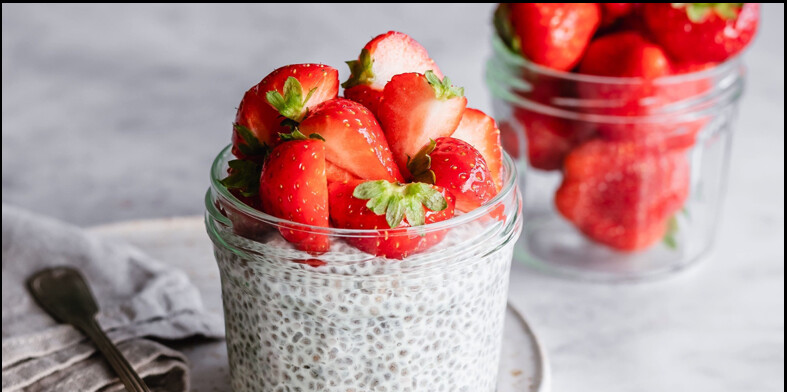
Read on to find out about chia seeds’ benefits and why you would be wise to sprinkle more into your life.
Chia Seeds’ Origin
Chia is a small, subtlety flavored seed that comes from an annual herbaceous plant, Salvia hispanica L., a member of the mint family native to Mexico and Central America. Once a food prized by the ancient Aztec armies, chia was cultivated by Mesopotamian cultures, but then essentially disappeared for centuries until the middle of the 20th century, when it was ‘rediscovered.’
The Health Benefits of Chia Seeds
Don’t let their small stature fool you: chia seeds have a large nutritional impact. In fact, a 1-ounce serving (about 2 1/2 tablespoons) of chia seeds contains:
138 calories
5 g protein
9 g fat
1 g saturated fat
5 g omega-3 fat
12 g carbs
10 g fiber
“Chia seeds are a convenient and nutrient-dense food that can help runners meet their nutritional needs,” says Dana Norris, M.S., R.D., C.S.S.D, dietitian of Eleat Sports Nutrition. “That’s because they provide protein, omega-3 fatty acids, fiber, and many other nutrients like magnesium, calcium, phosphorus, and potassium.”
Here, what you’ll gain from eating chia seeds:
1. Mega-healthy fat
Some people still consider high-fat foods like chia as the enemy, but they’re our allies in health when they possess the right types of fat. Only about 11% of the fat present in chia seed is saturated, with the rest being health-benefiting monounsaturated and polyunsaturated.
In the case of chia, the most notable polyunsaturated fat is alpha-linolenic acid (ALA), a type of omega-3 fatty acid that is deemed essential and therefore must be obtained from the diet. An analysis of data from 41 studies that was published in the journal BMJ linked a high intake of alpha-linolenic acid to a 10% lower risk of all-cause mortality, an 8% lower risk of death from cardiovascular disease and an 11% reduced risk of death from coronary heart disease, compared with lower consumption levels.
Other research has also suggested that this plant-based omega-3 fat can be protective against developing heart disease. Mechanisms aren’t yet fully known, but it might be that this fat helps lower inflammation in the body.
The omega-3 content of chia could also be one reason why some research suggests that consuming it daily could help drive down blood pressure numbers. But this benefit has only been demonstrated in those with existing hypertension and may not occur in healthy runners who don’t have troubling blood pressure levels.
Also beneficial: Chia seeds provide a 3-to-1 ratio of omega-3 to omega-6 fatty acid. “The standard American diet tends to be much higher in omega-6s than omega-3s, which can increase inflammation,” notes Norris. “So eating these seeds is a great way to consume more omega-3s and help improve this fat ratio in your diet.”
2. Filling fiber
A mere tablespoon serving of chia seeds delivers about 4 grams of fiber. That is significant considering that many people struggle to reach their daily quota—men typically require about 38 grams of fiber, while women should aim for 25 grams. “So a daily serving or two of chia can make it a lot easier for runners to get enough fiber for better health,” Norris says.
The findings of a study published in the journal The Lancet suggests that high-fiber eaters (those who consume at least 25 grams a day) have a 15% to 30% lower risk of heart attack, stroke, type 2 diabetes, colorectal cancer, and cardiovascular-related death compared to people who eat much less fiber.
“Dietary fiber helps to regulate the digestive system, feeds the good bacteria in the gut, promotes satiety (the feeling of fullness), positively impacts cholesterol levels, and helps manage energy levels throughout the day,” Norris tells Runners World.
A good portion of the fiber in chia hails from the soluble form of this carbohydrate. When exposed to liquids in your digestive tract, this soluble fiber forms a gelatinous coating that can slow down the digestion of your meals and snacks. There are a few benefits of this: For starters, this helps bulk up your stool and guard against constipation and diarrhea. It can also help you better manage blood sugar levels, which can make your energy more stable and lower the risk for certain metabolic conditions, like type 2 diabetes.
Slower digestion may also improve satiety to help with overall calorie intake regulation. In the best-selling book Born to Run, author Christopher McDougall reported that the Tarahumara indigenous group in Mexico, who are known for their world-class running endurance, often consume a chia drink before endless runs to help quell hunger. Just keep in mind, it’s probably not a good idea not to experiment with consuming chia before an important run in case this fiber causes you gastro problems.
3. Bone-building micronutrients
With about 15% of the daily need for calcium in a 2-tablespoon serving, chia seeds are a viable non-dairy source of calcium. “Chia seeds can be a helpful way for athletes to increase their calcium intake, especially if they do not consume dairy products,” says Norris. She adds that magnesium and phosphorus are two other micronutrients in chia that also work to improve bone health.
Additionally, you get iron in chia seeds, a mineral necessary for helping transport oxygen to your working muscles, and, in turn, something that is vital for maintaining peak performance. Though the form of iron in chia and other plant-based foods is not as well absorbed as that in meats, you can help partially remedy this by consuming the seeds with a source of vitamin C, such as berries, which improves absorption rates.
There is also a healthy amount of manganese in chia, which the National Institutes of Health says is involved in protein and carbohydrate metabolism and proper immune system functioning.
4. Disease-fighting antioxidants
Nutrition analysis has revealed that chia seeds deliver a range of useful antioxidants including caffeic acid, rosmarinic acid, myricetin, and quercetin. Antioxidants are compounds that roam the body looking for cell-damaging free radicals to knock out. And in doing so, are thought to help reduce the risk for a number of chronic diseases, including cancer. But we don’t yet have any data to link specific antioxidants in chia seeds with disease prevention.
But there’s still an important benefit to these chia-backed compounds. “The antioxidants in chia seeds benefit muscle recovery as they help reduce inflammation in the body, which can be caused by strenuous exercise,” adds Norris.
5. A surprising amount of protein
As more people pivot to plant-based proteins, it’s helpful to know that chia seeds are a fairly good source. You get about 2 to 3 grams in each tablespoon. That makes them more protein-dense than most nuts, including almonds. In fact, a study in the Journal of Agricultural and Food Chemistry determined that chia seeds supply a healthy balance of essential amino acids making them helpful in muscle recovery and muscle building for athletes.
Just know that other plant foods like tofu, beans, and tempeh still make it easier to meet overall protein needs if following a meat- and dairy-free diet, considering they contain a higher total amount of macronutrient.
How to Eat More Chia Seeds
Chia seeds come in both black and off-white, but there is little flavor difference and no proven major nutritional advantages of choosing one over the other. Unlike flax, chia does not need to be ground for its nutrients to be properly absorbed in your body.
Eating more chia can be as simple as sprinkling it over your oatmeal, yogurt, cottage cheese, steamed or roasted vegetables, and fruit salads. Norris points out that you can also blend them into your smoothies for a nutritional boost and incorporate them into homemade energy bars and balls.
The high amount of soluble fiber in chia forms a gel when mixed with water—a quirk that you can take advantage of to create better-for-you puddings and jams. For instance, for a nutritious chocolate pudding blend together 1/2 cup milk, 1/2 cup plain yogurt, 1 tablespoon cocoa powder, 1 teaspoon honey, 1 teaspoon vanilla extract and 1/2 teaspoon cinnamon. Pour into a jar and stir in 3 tablespoons chia seed. Seal shut and chill until thickened, about 2 hours. Or make a thirst-quenching, hydrating chia fresca by stirring together 1 cup water, 2 teaspoons chia seeds, juice of 1/2 lemon or lime and 2 teaspoons honey or agave syrup. Let sit for a few moments to thicken slightly.
The same gelling quality lets you create a substitute for eggs for baking. For each egg called for in a recipe, mix 1 tablespoon chia seeds with 3 tablespoons water and let sit for about 10 minutes, or until a goopy texture has formed. You can then use this to create a binding effect in a recipe much as an egg would.
Made by finely grinding up whole chia seeds, you can also add chia powder to baked goods like muffins and cookies, as well as the batter for your Sunday pancakes. Use it instead of breadcrumbs in recipes such as meatloaf or stir it into a pot of simmering oats.
by Runner’s World
Login to leave a comment
Olympic 800m medalist Nijel Amos suspended for doping
The third fastest 800m runner of all time, Botswana’s Nijel Amos has been provisionally suspended ahead of this week’s World Championships, after the 2012 Olympic silver medallist tested positive for a banned metabolite, the Athletics Integrity Unit (AIU) said on Tuesday.
The drug found in the 28-year-old’s system was GW1516, which modifies how the body metabolizes fat, and which can boost endurance. An AIU press release said that the World Anti-Doping Agency (WADA) has also warned that it poses a health risk to athletes.
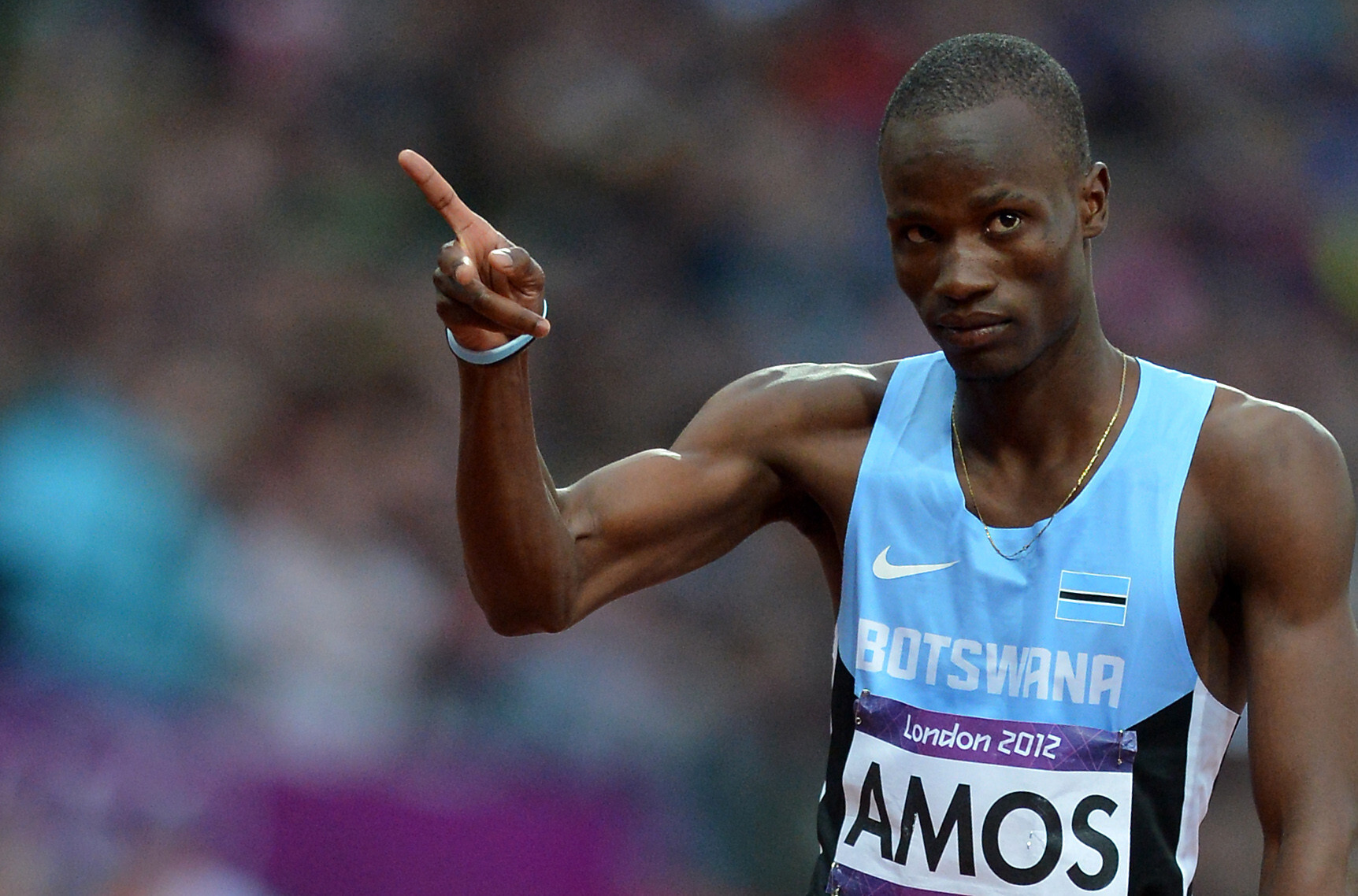
GW1516 was originally developed to treat obesity and diabetes, but is not approved for human use, since it was discovered to be carcinogenic. It is banned in and out of competition, and not eligible for Therapeutic Use Exemption (TUE). A USADA bulletin from 2019 says GW1516 is also sometimes known as cardarine or endurobol and has been found in some supplements, even though it is illegal. In 2017, there were 31 sanctions worldwide related to its use.
The AIU collected the sample from Amos during an out-of-competition test on June 4. Amos was notified of the result while he was preparing for the World Championships in Eugene, Ore., where he was scheduled to compete in the heats of the 800m on July 20. He finished eighth in the 800m final at Tokyo 2020. At Rio in 2016, he failed to make it out of the heats.
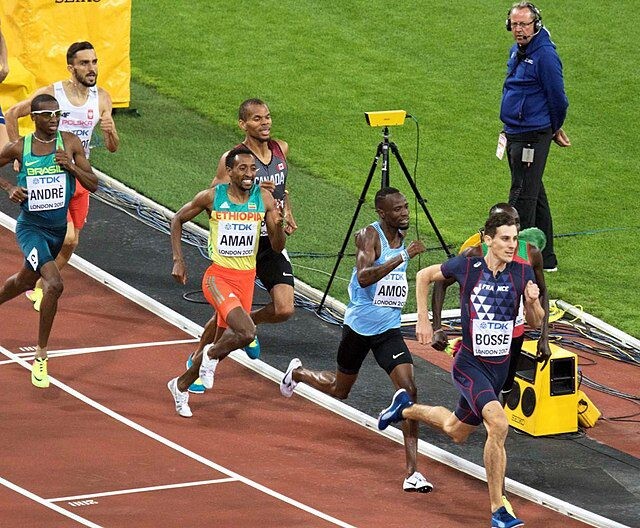
Amos’s silver in the 800m from the London Olympics was Botswana’s first Olympic medal and ranks as the third-fastest 800m time ever (1:41.73) behind Kenya’s David Rudisha (1:40.91) and Wilson Kipketer (1:41.11).
Amos has spent his last six seasons training with Mark Rowland and the Nike Oregon Track Club. Rowland recently left the club to start a new role as a coach with the Athletics Canada West Hub.
The AIU says the length of his suspension will be determined at a later date.
by Marley Dickinson
Login to leave a comment
How much will running in poor air quality compromise your health? It depends on which markers of health you consider
Here’s a bold prediction for the upcoming dog days of summer 2022: it’s going to be hot, smoggy and smoky. Whether you’re in a big metropolis sucking in diesel fumes or on a remote mountain trail coughing up smoke particles from a distant forest fire, there’s a good chance you’re going to encounter some less-than-pristine air over the next few months.
Is that a problem? On the surface, the answer is obvious. Inhaling polluted air triggers a cascade of inflammation and oxidative stress that raises your risk of both immediate and long-term health problems. The rise and fall of air quality readings, for example, is mirrored by the rise and fall of hospital admissions for conditions such as heart disease. And the harder you breathe, the more pollution you inhale, which is why public health authorities typically warn you to avoid outdoor exercise on days with poor air quality.
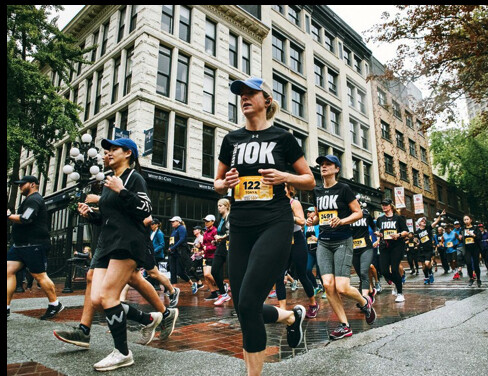
But there’s an alternate perspective. Pollution is definitely bad for your health—but so is skipping your workout. If you’re weighing the lesser of two evils, it may be that running in dirty air is better than not running at all. That’s the perspective that Michael Koehle, an environmental physiologist who is one of the world’s leading experts on exercise and air pollution, offered when I visited his lab at the University of British Columbia a decade ago: “Exercise is such a big hammer that it crushes everything else,” he told me.
At the time, few studies had addressed the balance between exercise’s benefits and pollution’s harms. Since then, Koehle and others have been grappling with this question, with new findings still appearing on a regular basis. Here’s where the research currently stands.
The good news
Last summer, researchers in Taiwan published a study in the Canadian Medical Association Journal that analyzed the medical records of nearly 400,000 adults who had undergone medical screening starting in 1994. Their exercise habits were assessed with a questionnaire, and their pollution exposure was estimated based on their home address. More exercise was associated with greater longevity, while more pollution was associated with worse longevity, as you’d expect. But it was the interaction—or rather, the lack of interaction—between these two factors that was most interesting. Exposure to high levels of pollution didn’t dampen or reverse the health benefits of high levels of exercise.
A few earlier studies have produced similar findings. For example, a Danish analysis of 52,000 people found that higher levels of exercise protected against premature death, heart disease and diabetes, regardless of how much pollution the subjects were exposed to based on a detailed street-by-street air quality database. An explanation for these results might be found in a series of studies by Brazilian scientists, who directly measured inflammation and oxidative damage in the lungs of mice breathing diesel exhaust. Regular running, it turned out, blocked this inflammation and oxidative damage; exercise was a big enough hammer to cancel out the diesel.
The bad news
Longevity is a pretty good marker of health, but it’s not the only one. Earlier this year, researchers at the University of Arizona published a pair of studies that looked at the effects of exercise and air pollution on brain health. It’s well known that people who exercise regularly tend to have brains with more grey matter (where the neurons are) and healthier white matter (which connects and supports the neurons). They are also less likely to develop degenerative brain diseases like Alzheimer’s: data from the long-running National Runners’ Health Study estimates the risk to be 40 per cent lower in those who run about 25 kilometres a week.
The first Arizona study used brain scans to assess the size and health of white and grey matter in 8,600 British adults; the second one used health records to look for dementia diagnoses in about 35,000 people. They used activity trackers to assess exercise habits and home addresses to estimate pollution exposure. For people in low-pollution areas, the results were as expected: more exercise predicted healthier brains and fewer dementia diagnoses. But for people in moderate- and high-pollution areas, the brain benefits of exercise disappeared.
It’s worth emphasizing that exercising in the polluted areas didn’t make people less healthy, nor did it cancel out the many other benefits of exercise, for example, on heart health. But we all want healthier brains, and the news that even moderate pollution blocks some of those benefits is concerning.
What to do about it
The devil is in the details. There are undoubtedly some situations—the apocalyptic aftermath of a big forest fire, say—when it makes sense to skip a run entirely. And people with respiratory or heart conditions should be especially careful to avoid poor air quality.
More often, though, it may be possible to choose a lesser evil. Mornings generally have significantly cleaner air, thanks to traffic patterns and the interaction of sunlight with certain pollutants, so set that alarm clock. Location, too, plays a big role. Trails and paths that are away from busy roads are your best bet, but even small distances and barriers can help. Vancouver’s bike lanes, for example, are often separated from traffic by a lane of parked cars because that gives cyclists measurably better air quality, according to Koehle.
Contrary to what you might expect, Koehle’s research has found that more intense exercise isn’t necessarily worse than easy exercise. Panting hard may change the way particulates of pollution settle (or don’t settle) in the lungs. As a result, he suggests favouring shorter, harder workouts rather than longer, easier ones when the air quality is worse than usual. Moving indoors is also an option—but unless your facility has state-of-the-art air filtration, don’t assume that the air inside is any better than the air outside. It all comes from the same place, after all.
In the long term, rather than tweaking when and where you run, the best solution would be to make sure that we all have consistent access to clean air. That’s a big hill to climb—but by sticking to your running plans rather than, say, driving to the gym, you’re taking a small step in the right direction.
Login to leave a comment
Here's How Many Servings of Fruits and Vegetables You Should Eat Per Day
Do you know how many servings of fruits or vegetables you should eat per day? If your answer is no, you’re not alone. It turns out most of us don’t get enough fruits and vegetables in our diets, according to the latest USDA Dietary Guidelines for Americans. But of course, the key to making sure you’re eating enough produce is actually knowing how much to eat.
So to help you fill up on these colorful foods, we explain exactly how many servings of vegetables and fruit you should aim to eat each day and why it’s a smart idea to hit that target. Plus, a few ways you can increase your intake.
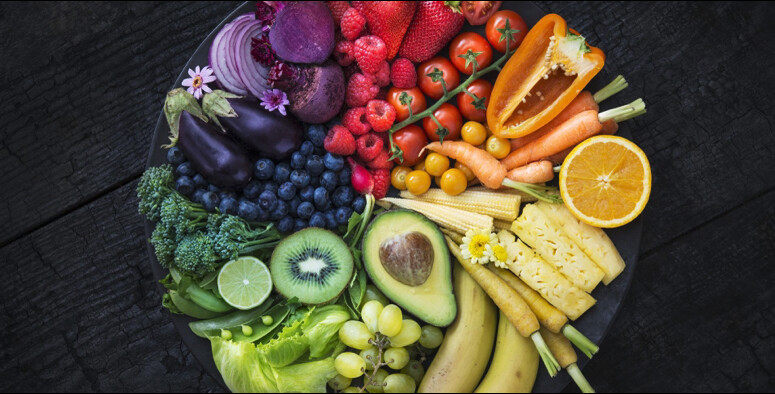
So, how many servings of vegetables and fruits should you eat a day?
Adults who consume 2,200 calories a day should aim to eat at least 3 cups of vegetables and 2 1/2 cups of fruits each day, according to the USDA. But, if you’re consuming more calories, then you’ll need to up your intake.
“Portion goals vary with gender and size, but most of us need at least 3 to 5 cups of vegetables per day and 2 to 4 cups of fruit,” Julie Stefanski, registered dietitian nutritionist, C.S.S.D and spokesperson for the Academy of Nutrition and Dietetics tells Runner’s World. “Vegetable and fruit goals are set as ranges, with the lower end preventing vitamin deficiencies, and the upper end of the range promoting long-term health,” she says.
Eating the minimum number of servings each day will ensure you get the essential nutrients your body needs to maintain function and overall health.
Here are some clear examples of what a serving size of fruit and vegetables looks like:
Medium size fruit, like an apple or banana
1/2 cup of fresh, frozen, or canned fruits or vegetables like peas, strawberries, or carrots
1/4 cup of dried fruit, like apricots or raisins
1 cup of leafy raw vegetables, like spinach, kale, or arugula
Why is it important for runners to eat enough fruits and vegetables?
We all know good and well that fruits and vegetables are a crucial part of a healthy diet. For decades, scientist have researched a plethora of ways eating a rainbow diet can benefit your health.
For example, one review highlights fruits and vegetables as key sources of phytochemicals—like polyphenols, carotenoids, and flavonoids—and consuming them offers a multitude of health benefits, including fighting free radicals and inflammation. In the research, scientists also noted that studies have proven eating fruits and vegetables can reduce the risk of hypertension, cardiovascular disease, chronic obstructive pulmonary disease, lung cancer, and metabolic syndrome.
Also, incorporating vegetables in your daily diet can improve digestive health, vision, and reduce risk of heart disease, stroke, and diabetes, according to another review. And that's not all: Researchers of a recent meta-analysis found an association between eating five servings of fruits and vegetables a day and lower risk of mortality. (Take note that this link didn’t hold for starchy veggies.)
Stefanski says, runners can benefit from produce, in particularly leafy greens or deep orange veggies, because they’re flush with nutrients you need for recovery and daily living. What’s more, fruits and vegetables are filled with tons of important vitamins and minerals that all runners need. This includes vitamin C—which is found in peppers, oranges, and broccoli and key to the repair and renewal of connective tissues—as well as potassium in bananas, beats, and avocados, which your body uses to aid muscle and nerve communication.
Eating enough servings of fruits and vegetables each day will not only make you feel better physically, but also mentally. A study published in the journal Environmental Research and Public Health found participants who ate less than three sources of fruits and vegetables a day where at a higher risk for developing anxiety disorders. Lead study author Karen Davison, Ph.D. a health science professor at Kwantlen Polytechnic University in Canada, tells Runner’s World, this is because fruits and vegetables are rich in nutrients like carotenoids, potassium, fiber, vitamins, and polyphenols that are good for mental health.
Stefanski agrees, adding: “mentally, knowing that you’re trying to take care of your body by nourishing it well, can pay off in a mood boost.”
How to add more fruits and vegetables to your daily diet
Luckily, adding more fruits and veggies to your plate is pretty easy, so upping your intake should be a breeze. Here, Stefanski offers simple ways to pack more produce into your diet:
»Split your daily vegetable goals between meals. If you’re aiming to eat 3 cups of vegetables a day, then try to have 1.5 cups of vegetables with lunch (like in a salad) and the other half at dinner (as a side dish). Bonus points if you get a cup in at breakfast too, like adding greens to your omelet or having a produce-packed smoothie.
»Grab a snack. Consider making a cup of fruit or a medium-size piece of whole fruit as your go-to bite between meals.
»Swap out your typical preworkout fuel. Instead of eating an energy bar go for starchy vegetables like potatoes, plantains, or sweet potatoes. Or even something like a banana and peanut butter.
»Buy frozen produce. You can stock up on frozen fruits and vegetables that can be easily steamed in the microwave or roasted in the oven while you make other dishes, Stefanski says. That makes it easy to incorporate fruits and veggies into every meal—a good goal—as they’re quicker to prep and last longer.
»Add fruit at breakfast. In the morning, top your oatmeal with fresh fruit or have berries on the side of your egg dish. This is an easy way to start the day with some produce and take a few steps toward your daily servings goals.
»Have dinner for breakfast. Breakfast doesn’t have to equal what we’ve come to know as “breakfast foods.” Lean meat with a side of vegetables and a starch may fuel you much better throughout the day than your usual options, Stefanski says.
by Runner’s World
Login to leave a comment
Common Health Problems that will impact your performance
Any type of athletic performance requires physical, mental, and overall health because of the energy demands of each activity.. Athletes are at higher risk of disease, more sensitive to pain, and have an increased chance of getting injured because of their lifestyles. Though most people believe that athletes are just healthy individuals with good genetics, several common health problems impede athletic performance.
Many different things can impact your athletic performance. Whether it is a health problem that you are unaware of or an injury that you are trying to recover from, there are steps that you can take to improve your performance. In this article, we will discuss eight common health problems that can have an impact on your athletic performance.
Test your general health
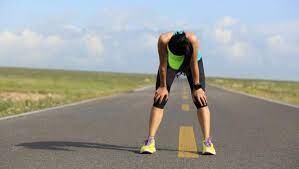
Everyone comes to a certain period in life when they start thinking about the future. No matter when this point in your life comes for you, it is always beneficial to have an idea of what health problems may occur down the line. It’s never too early to think about taking care of your body and feeling healthy mentally and physically. With the information on the Health Hub combined with home tests for food intolerance, vitamin D deficiency, etc., you can start early on testing your general health. One of the most important things that everyone should consider doing at least once every year is undergoing a general checkup with their doctor to see how they can improve their lifestyle choices. Make sure that you get blood work done so that any underlying conditions such as diabetes or even more serious diseases can be discovered.
Stress levels
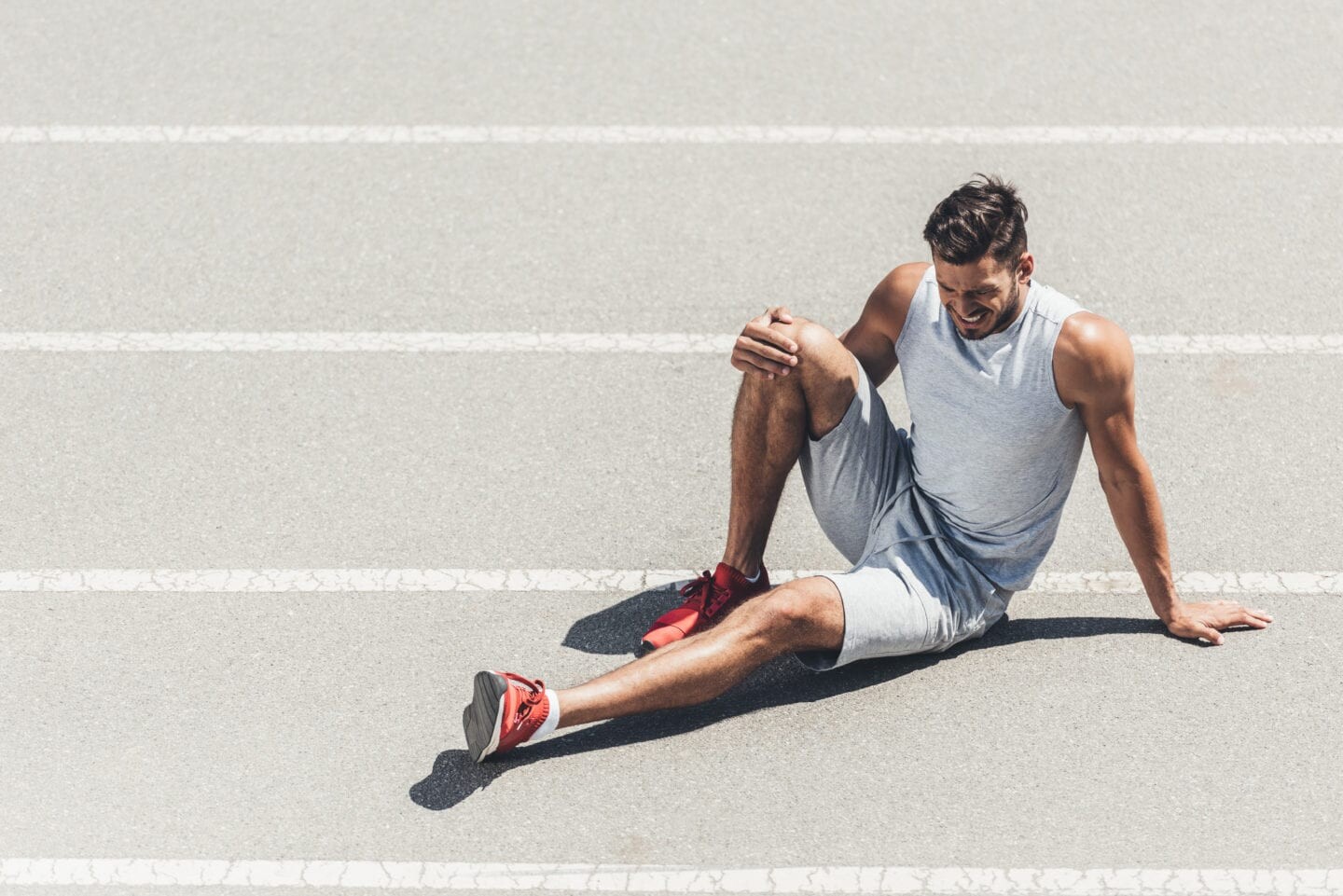
When you are stressed, your body demands more energy than it normally would. If you experience prolonged stress, your body is stressed 24/7 which means that it is constantly demanding calories regardless of the activity that you do daily. This constant need for energy can result in weight gain, fatigue, insomnia, poor concentration, high blood pressure (hypertension), etc., all of which will impact your athletic performance if left untreated. Make sure to try and combat this issue first by setting a specific time in a day when you will be devoted to yourself, during which you can assess your impressions and emotions. There is a rise of new sleep disorder patterns caused by the increased numbers of daily activities, and people need their alone time. Taking it during nighttime when you are supposed to be sleeping can severely impact your biorhythm.
Food intolerance
One of the best ways to remedy this situation is to keep track of what type of foods make you feel bloated or cause cramps after eating them. Some people find certain dairy products or gluten-containing grains like wheat to be very difficult to digest. Keeping a food journal is one of the best ways to keep track of what types of foods you are eating and how they make you feel. Nutritional support can also help relieve some irritations in your gut that may be causing bloating, indigestion, etc., after consuming certain types of food items.
Nutritional deficiencies
As athletes, it is important to make sure that you are getting the correct amount of nutrients in your body to perform at optimal levels. There are different levels in which one can be deficient in certain vitamins and minerals, but it is safe to say that every athlete should take a multivitamin daily. Making sure that you get enough protein, iron, calcium, etc. can all contribute to your athletic performance because these nutrients provide energy when necessary.
Iron deficiency is one of the most common nutritional deficiencies that can impact athletic performance. Iron deficiency leads to anemia, which means that there are fewer healthy red blood cells than normal to carry oxygen throughout your body. When you experience chronic fatigue, loss of breath when working out, etc., this could be the culprit behind the problems that you are experiencing. Women who go through their menstrual cycle monthly also have a greater chance of suffering from iron deficiency because they lose so much blood during their periods.
Shortness of breath
If shortness of breath is something that you deal with regularly, there may be certain health concerns behind this issue. Shortness of breath could mean that your heart isn’t pumping enough blood throughout your body, or that there is a lack of oxygen in your blood. This could be caused by poor circulation, having low levels of iron in your body, smoking, etc. The best way to test if this is an issue for you is to do a breathing test.
High cholesterol/high blood pressure
These two issues are among the most common health concerns that many people suffer from daily. High cholesterol and high blood pressure can both impact your athletic performance because they increase the chances of suffering from cardiovascular disease. Having either of these conditions will decrease the amount of oxygen that flows throughout your body which means that you won’t have as much energy to get through tough workouts or competitions.
General fatigue
It’s normal to feel tired after performing some strenuous activity, but feeling excessively fatigued throughout your day is something that shouldn’t be ignored. If you are constantly exhausted despite getting a good night’s rest, it could be because your body isn’t getting the right amount of nutrients (vitamin deficiencies) or oxygen (low iron).
To combat fatigue, first, try to get some proper rest and address any nutritional or oxygen deficiencies you may have. If these methods don’t work, it’s best to see a doctor for proper diagnosis and treatment of the underlying issue. Sometimes stress is the main cause of fatigue, so taking some time to relax or meditate can also help alleviate the problem.
Ringing in the ears
Tinnitus, which is more commonly known as ringing in your ears, can be caused by certain medications (like aspirin), high blood pressure that causes damage to the inner ear, anemia, etc. Tinnitus can be very bothersome because it causes a constant noise that interrupts your day-to-day activities; some people claim that this condition is what prevents them from getting a full night’s rest. If you’re suffering from tinnitus and it’s affecting your athletic performance, try consulting a doctor for treatment options.
No one is immune to health problems, and these eight are just a few that can impact your athletic performance. If you’re experiencing any of the symptoms listed above, it’s important to get checked out by a doctor to determine the underlying cause. Once you know what the issue is, you can start working on a treatment plan with your physician so that you can get back to performing at your best.
by Colorado Runner
Login to leave a comment
Study: watch out for these predictors of multiple injuries
Despite how common injuries are among runners, we still know relatively little about what specific factors cause them, or how to prevent them. We know even less about why some runners suffer multiple injuries in a season, while others seem to be able to run forever with next to no issues. Recently, researchers in South Africa tried to understand what causes some runners to experience multiple injuries, and their findings may surprise you.
The study
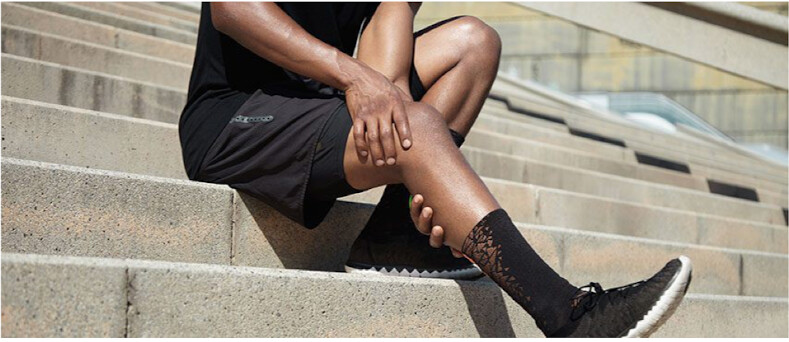
The study, which was published in the Journal of Sport and Health Science, collected running-related injury data from 75,401 race entrants across four years (2012-2015) at the annual Two Oceans 21.1 km and 56.0 km races in South Africa. The average number of injuries for each runner every year was calculated by taking a runner’s race entry history and injury history into account and categorizing entrants into four multiple injury risk (MIR) categories — high, intermediate, low and very low.
The researchers used odds ratios (multiple logistic regression modeling) to determine which factors predicted a high risk of multiple injuries. The factors they considered included demographics, training and racing, chronic-disease history and history of allergies.
The results
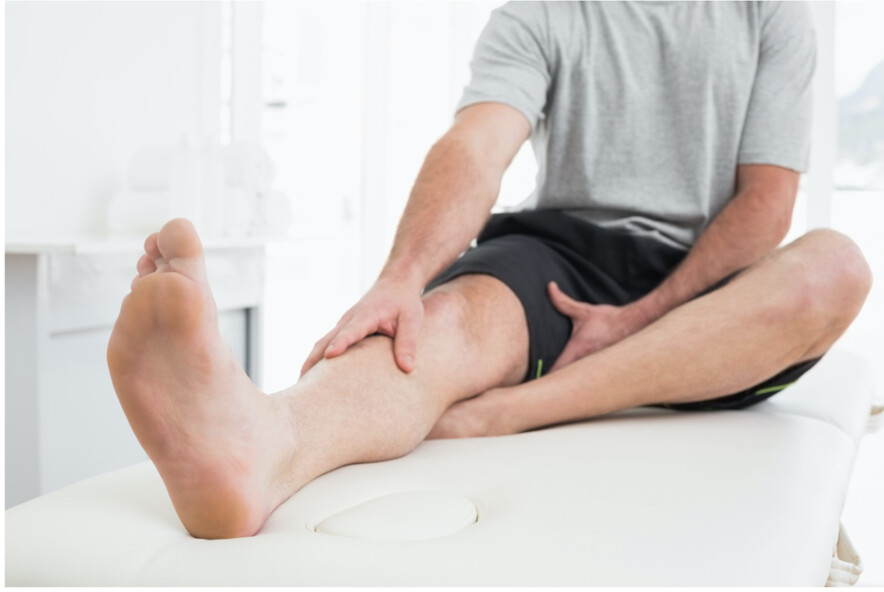
Interestingly, the results showed that less than 10 per cent of the runners surveyed experienced an injury over the four years, and only 0.4 per cent of them experienced multiple injuries during that time. This, the researchers admitted, is relatively low compared to other studies, which have previously reported between 19.4 per cent and 79.3 per cent of runners experiencing at least one injury every year, and warrants further investigation.
The study determined three independent risk factors that seemed to predict a higher instance of multiple injuries. These included older age (more than 40 years old), a longer history of recreational running (more than 20 years) and running longer distances, like ultramarathons. Counter to what you may think, neither weekly running mileage nor any other training-related risk factors were predictors of a high rate of multiple injuries.
Chronic disease and injuries
The researchers also identified two novel risk factors for multiple injuries: a history of chronic disease or a history of allergies. Nearly 19 per cent of all runners involved in the study reported at least one chronic disease, and these people accounted for 26 per cent of runners with multiple injuries. If the number of chronic diseases in a runner increased from one to two, their odds for having multiple injuries increased by a factor of 2.2 per cent. If they went from two to three, those odds went up another by a factor of 4.7.
The authors of the study note previous studies have shown that chronic diseases are common among endurance runners. They also point out that other studies have reported a link between chronic diseases like diabetes mellitus and hypercholesterolemia are associated with injury. They believe that one reason for this association is that runners with chronic diseases are likely on a number of medications, which could influence their risk for injuries. “There is also evidence that medications used to treat chronic diseases can be associated with increased risk of tendinopathies, ligament injuries and bone-stress injuries,” the researchers say.
Allergies and injuries
The study also found that runners with a history of any form of allergies had significantly higher odds of experiencing multiple injuries than those who didn’t. “Runners with allergies are likely to be taking antihistamines, especially because endurance running is an outdoor activity,” the researchers concluded. “One of the oral sedating H1 antihistamines, Promethazine, has been associated with severe tissue injury.”
The bottom line
Injuries are complicated and often multi-faceted, and scientists are still learning what causes some people to become injured more than others. This study has a few specific limitations, including the self-reported nature of the data, and the fact that none of the injuries were confirmed by healthcare professionals.
The results of this study were also correlations, not causations, and cause-effect relationships between the risk factors couldn’t be confirmed due to the cross-sectional design of the study. The researchers also didn’t address risk factors that could potentially play roles in multiple injuries among runners, like body mass index, specific medications, type of training/surface or biomechanics, among others, and they did not account for recurrent injuries in their data.
Still, runners with allergies or chronic diseases should take note of this study, and take extra precautions with their training. Particularly if you’re taking medications for your condition, you should talk to your doctor about the potential side effects and how you can lower your risk for injuries and train safely.
by Running Magazine
Login to leave a comment
Are the Health Benefits of Apple Cider Vinegar Fact or Fiction?
We tapped a registered dietitian and poured over the latest research to find out.
These are the days when one would go online seeking nutrition remedies for every imaginable condition and find every imaginable solution. But long before Google delivered instant suggestions on what to eat for better health and performance, apple cider vinegar (ACV) has been one of the leading word-of-mouth health remedies.
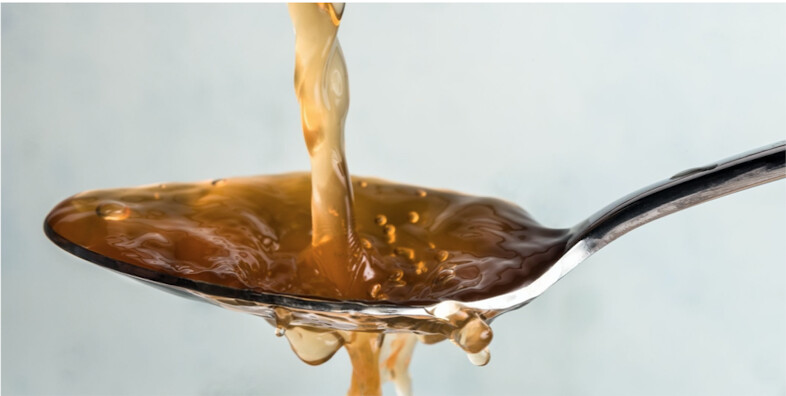
The promises are enthusiastic: better blood sugar control, improved heart and immune health, reduced cancer risk, and weight loss (if that’s your goal) to name a few.
So, you’re probably wondering what science has to say. Can ACV really go the distance in helping us stay healthy for longer? Here’s the truth on whether sour has the power.
What exactly is apple cider vinegar?
While vinegar can be gleaned from various starting materials including grapes and rice, apple cider vinegar is produced by pulverizing apples into a slurry of juice and pulp that is then allowed to ferment in the presence of bacteria and yeast. This converts the fruit sugar largely into acetic acid (among other types) and produces various flavor compounds, which lends the vinegar its strong sour smell and sharp flavor.
What are the health benefits of apple cider vinegar?
Though singled out as a remedy for a laundry list of ailments, some purported health perks may hold true.
Foremost, the high levels of acetic acid in ACV may help with blood sugar control and improve certain blood lipids, according to a 2021 systematic review and meta-analysis in the Journal of the Academy of Nutrition and Dietetics. Acetic acid was also found to lower concentrations of blood triglycerides among those who were overweight or obese and in those with type 2 diabetes, which may promote better heart health. Additionally, another review study in the journal BMC Complementary Medicine and Therapies found enough evidence to suggest that apple cider vinegar used for longer than two months can improve blood sugar management and blood cholesterol levels.
An investigation in the European Journal of Clinical Nutrition found that when people consumed white bread with vinegar, there was a lower blood glucose and insulin response, as well as improved ratings of satiety, than when they consumed the same amount of bread without the vinegar. The higher the acetic acid content of the vinegar the greater the impact.
Though we often think of improved blood sugar control as something that’s only important for people with diabetes, Molly Kimball, R.D., registered dietitian with Ochsner Health in New Orleans, tells Runner’s World it’s beneficial for everyone, including runners. “Maintaining steady blood sugar levels—meaning avoiding the peaks and valleys—as much as possible is key for optimizing energy, mood, and fending off cravings, to name a few.”
The slower release of blood sugar into the bloodstream with apple cider vinegar use and the subsequent rise in hunger-reducing hormones could result in feelings of fullness and, therefore, potential weight loss over time.
ACV can improve blood sugar numbers, which Kimball says are most likely to occur when it’s paired with carb-rich foods, because it reduces the activity of an enzyme that breaks down starch and increases the uptake of glucose into tissues—including skeletal muscle—by improving insulin sensitivity and blood flow.
But keep in mind that we don’t know what impact is on people without any impaired insulin sensitivity or blood sugar control, including healthy runners. And, noticeable blood sugar improvement may only occur when apple cider vinegar is added to meals containing high glycemic index foods and drinks like white bread, juice, potatoes, and white pasta.
Kimball adds that it’s also unclear how apple cider vinegar’s metabolic effects vary from any other kinds of vinegar. Though most of the research has been conducted on apple cider vinegar, the blood sugar benefits may not differ a great deal among different varieties of vinegar like balsamic and white wine, since they also contain acetic acid.
Since apple cider vinegar is a fermented food product, Kimball says it could, in theory, supply probiotics to improve our microbiome, which is the population of microbes in our digestive tract that appear to play a big role in overall health. After analyzing blood and stool samples of healthy adult participants, Stanford School of Medicine researchers discovered that a 10-week diet high in fermented foods (6 servings daily) resulted in measurable improvements in microbiome diversity and decreases in markers of inflammation.
“However, because we’re typically consuming such small volumes, it doesn’t seem likely that apple cider vinegar would be a significant source of probiotics in our diet compared to other fermented foods,” says Kimball. “Instead, I would look at it as every bit helps.” To date, there are no studies specifically addressing apple cider vinegar’s impact on the microbiome.
It’s likely that apple cider vinegar contains small amounts of the various phytochemicals found in the apples it is produced from. These phytochemicals could give the vinegar some antioxidant activity to help reduce cell damage in the body that may offer protection from various conditions like cognitive decline.
“But, the amount of antioxidants you’d get from typical serving sizes of apple cider vinegar is likely much less than what you would get from whole apples and other fruits,” Kimball says. “I would not count on it to give us a significant impact in terms of antioxidant benefit.”
Here’s how to add apple cider vinegar to your diet
The easiest way to incorporate ACV into your diet is to use it in salad dressings. You can also toss it into cooked grains and use it in sauces and homemade condiments for some vinegary tang. Pickled vegetables can also be another source of acetic acid in your diet.
Some people will dilute the ACV in water and drink it before meals, which could improve post-meal blood sugar numbers. “I typically recommend diluting 1 ounce [of ACV] in about 4 ounces of water, herbal tea, or other types of no-sugar beverages,” Kimball says. However, she cautions that it’s essential to adequately dilute the vinegar—due to its acidic nature, it can damage the gastrointestinal tract and tooth enamel.
Ideally, you want to use an unfiltered apple cider vinegar that contains a cobweb-like floating substance referred to as the “mother” and has an amber color with a cloudy appearance. Bragg is one of the most popular brand options. Most commercial apple cider vinegar takes shortcuts from the longer fermentation process so it won’t have the same flavor nuances or probiotics.
You can also find apple cider vinegar in capsule and gummy form, but it’s not known if these are as helpful and there can be quality control issues.
The bottom line is...
Though the research holds some promise, especially related to blood sugar management when eating your higher carb meals, the quality of evidence surrounding the benefits of apple cider vinegar is not yet there and we don’t yet know if it is any better for you than other vinegar varieties. At the very least, it can make vegetables taste more exciting so you’ll want to eat more of them, which is certainly something to celebrate.
by Runner’s World
Login to leave a comment
Chelsea Clinton on Her First NYC Marathon: “The Day Was Incredible!”
After 20 years as a dedicated runner, she took on her first marathon through the five boroughs on November 7.
For years, the New York City Marathon has been a popular race for high-profile runners looking to take on the challenge of 26.2 miles. But one such notable athlete kept her presence in the 2021 race under wraps until she crossed the finish line.

Chelsea Clinton, 41—who is vice chair of the Clinton Foundation, teaches at Columbia University’s Mailman School of Public Health, and has authored several books for young readers—finished in 3:59:09. She averaged 9:08 pace (with half marathon splits of 1:50:27 and 2:08:42) and got in under the 4-hour barrier she had set as a goal for herself.
Her parents, Bill Clinton and Hillary Rodham Clinton, the 42nd president and the secretary of state during the Obama administration, met her at the finish line.
Clinton, still sore from the race, spoke to Runner’s World on November 10 about her experience running through the five boroughs. She discussed her training, an inopportune injury, and the conversations she and her husband, Marc Mezvinsky, had with their three children, ages 7, 5, and 2, about the effort it took to train for and finish the race. This interview had been condensed.
Runner’s World: When did you get the idea that you wanted to try a marathon?
Chelsea Clinton: Last year I turned 40. I had always thought about doing the New York City Marathon. When I turned 40 and thought, “I should do it.” But we didn’t have the marathon last year.
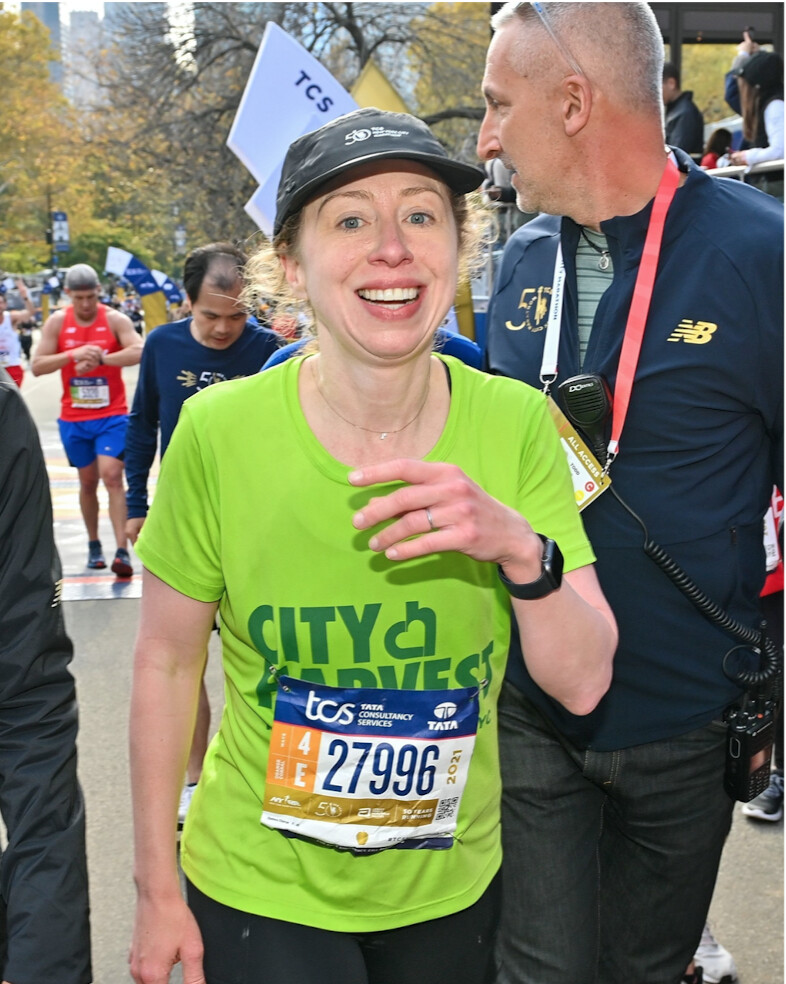
And so I was so thankful to have the chance to run the 50th running of the marathon. I’ve lived in New York City for 18 years, and most of those years I’ve cheered on the runners I don’t know and the runners I do know in the marathon.
How long have you been a runner?
I ran a little bit with my dad when I was in junior high and high school, but I didn’t really start running until I went to Stanford. I think just because it was so beautiful, and I had a lot of friends who had been runners. I’ve run, goodness, the last 20 some odd years.
When did you start training specifically for New York?
I started training four months before. I knew that I needed to train. I’d never run anything close to that distance.
Did you have a coach or a plan?
I did, and I’m not just saying this to you because you’re interviewing me. I looked at lots of different plans and some of them recommended running four days a week. I actually used the Runner’s World Sub-4-Hour Marathon Plan, which was five days a week.
I followed it really diligently until I tripped and fell [during speedwork on the treadmill] six weeks before the marathon. There’s no good story.
I wrenched my left foot and I bruised the bone and strained a tendon and thankfully have a really wonderful doctor and a great physical therapist, and I’ve never iced a body part as much as I’ve iced that left foot for the six weeks before the marathon. It got a lot of TLC of the cold variety.
I had to take three weeks off running totally. I biked and I did other things. I then kind of had to sort of feel out what I thought the best answer would be for the next couple of weeks to get back to hopefully marathon readiness. Thankfully, I was ready by the time Sunday came.
When do you train? Are you a morning runner?
Yes, I love running in the mornings. The long runs I would do on Sundays. I’m so thankful to my husband for keeping our children occupied while I was gone for increasingly longer runs over the months.
I like running all over New York City. I’ve seen so many different aspects of New York City I don’t know if I ever would have been able to see if I weren’t a runner, the different neighborhoods I could make it to. I love watching the city wake up.
There were a couple of days when it was 88, 90 degrees and I did revert to the treadmill. I found running in heat challenging.
Had you planned to run at an even pace to break 4 hours?
At the beginning I was running faster than I had planned—I was like, oh, gosh, I’m falling into the trap that all my friends who have run lots of marathons told me not to fall into, with the adrenaline. But I just have to enjoy this moment. And this is what’s enabling me to enjoy this moment. I just made the calculation, when I was in Brooklyn, that this is what feels right to me now. I want to soak in this experience, and I hope I’ll have enough left in me to still make it in under four hours. I did. With 51 seconds to spare.
I have to be honest, I didn’t quite follow my running plan on the day, but I think all the training and feeling in my body, what a 9-minute mile felt like, enabled me to adjust and still make my goal.
How was the day for you?
The day was incredible. It was even more of an amazing experience than whatever I had hoped or imagined it to be, the enthusiasm and the borough pride. I loved being in Brooklyn. Everyone was like, “We love Brooklyn!” [I’m thinking] I love Brooklyn. We made it to Queens and Queens was like, “We’re the best!” Yes, Queens is the best. You get to the Bronx and it’s like, “You’re not here for very long, but we are memorable.” I think, yes, I love the Bronx.
You get back into Manhattan and you’re like, ohmigod, I still have six miles to go.
Did you see a lot of people you knew along the course? And did your husband and kids see you?
It was just wonderful and I had friends that I saw all throughout the race and that just made it so much fun.
But really the most special moments were when I saw my kids. They made it to two different places and Marc was there at the finish line. They were so proud and so excited. They made me the cutest signs. My daughter yelled so loudly she was hoarse that night.
I am so proud that my kids saw their mom set a goal and beat that goal. We had lots of conversations, because initially they were like, “Mom you’re going to try so hard and you’re going to win.”
And I’m like, “No. I’m going to try so hard and I’m going to finish.”
They said, “But you can win, Mom.”
“I can’t win. If I work really hard, hopefully I can finish in about twice the time that people who are going to win finish in.”
And there were all these wonderful conversations around, we can do hard things at different points in our lives. Sometimes it really is about the effort toward those hard things and enjoying the effort and enjoying the event and it’s often not about winning.
My 2-year-old didn’t really understand what was going on. On Sunday night he was like, “No like wide races. Mama gone too long.”
“Oh yes, I’m sorry, sweetheart. Mama was gone too long today in the wide race.”
Had you planned to run with former pro soccer player Abby Wambach?
We knew that each other was running. I think we were just surprised we saw each other at the start and it was so nice. I adore and respect and love Abby, and it was so nice to share a little bit of that experience with her. But definitely after mile 11, I was like, I cannot keep up with the Olympian. I need to slow down a little bit or I will hit the wall. It was an unexpected gift at the moment.
Did you hit any rough patches?
I think that the bridges were harder than I had thought. The last six miles were challenging. But worth it.
You were running for City Harvest, which works on hunger issues in New York?
I was. I definitely saw people cheering on City Harvest. It was also really nice how often I would see people who were there for Every Mother Counts or Juvenile Diabetes Research Foundation and the other organizations. People were cheering on everyone who was in identifiable nonprofit shirts that ran by. There was so much support for those of us who were running for a cause.
Were you recognized by strangers?
Yes. And everyone was so nice. As I got slower, around 21, 22, 23, 24, I would run by and I would hear shouts behind me, “Go, Chelsea!” and I would turn back and be like, “Thank you!”
Were you doing the calculations at that point to figure out how slow you could go and still break the four-hour mark?
Yes. When I had run more quickly than I had realized for the first half, I was doing the math in my head, how slowly can I run in the moments when I know this is going to be really hard and then what will I need to do toward the end? I kept constantly recalibrating. And then, going up 5th Avenue, I could feel myself slowing more and thought, “Oh no, I hope I didn’t miscalculate.” And then I got into Central Park and the energy really helped carry me through.
Your parents seemed really proud of you.
Ohmigosh, so excited. I was nervous because of my injury, like oh, gosh, I hope I can make it. I actually called my mom at mile 11. I’m sure this is like breaking some sort of marathon protocol. I probably shouldn’t have called her, but I called her like, “I”m going to make it. You have to come.” She was like, “We’ll be there.” I was like, “Okay!” She was like, “Wait, aren’t you running?” ... “I am.”
Did you enjoy the signs people held?
So many funny signs. And so many, “Go random stranger” signs. I was like, “Yes, I’m a random stranger. Thank you!” Lots of signs supporting moms, which was great, like, if you gave birth to a child, you can do this. “Yes, I’ve given birth to three, I can.”
What kind of shoes do you wear?
I run in Brooks [Adrenaline GTS 21]. I’ve tried lots of different shoes. I have been dedicated to those shoes.
Are you hooked on marathons now or are you saying, “Never again?”
Well, I have to say I finished and I thought, “That was amazing. I want to do another one.” And then Sunday night I was like, “Ohmigosh, I’m so sore. How could I ever do this again?” We’re talking now and it’s Wednesday and I’m like, “I could totally do it again.” It’s a little bit like having children. It is something I would love to be able to do again
If I do it again, though, I would want to have a coach or friend. As extraordinary as it was and as much as I loved doing it as a New Yorker in New York City, it would have been nice to share the experience with someone. I said, “Marc, what do you think?” He said, “I love you so much. I’ll cheer harder next year. I’ll try to be in even more places.”
Hopefully I have some friends I can persuade.
by Runner’s World
Login to leave a comment
When It Comes to Cancer Prevention, Here’s How Much Exercise You May Need Each Week
Any amount of movement is beneficial, but research indicates there may be a sweet spot.
At least five hours of moderate-intensity activity per week may prevent certain types of cancers related to the breast, colon, stomach, kidney, bladder, and esophagus, new research suggests.
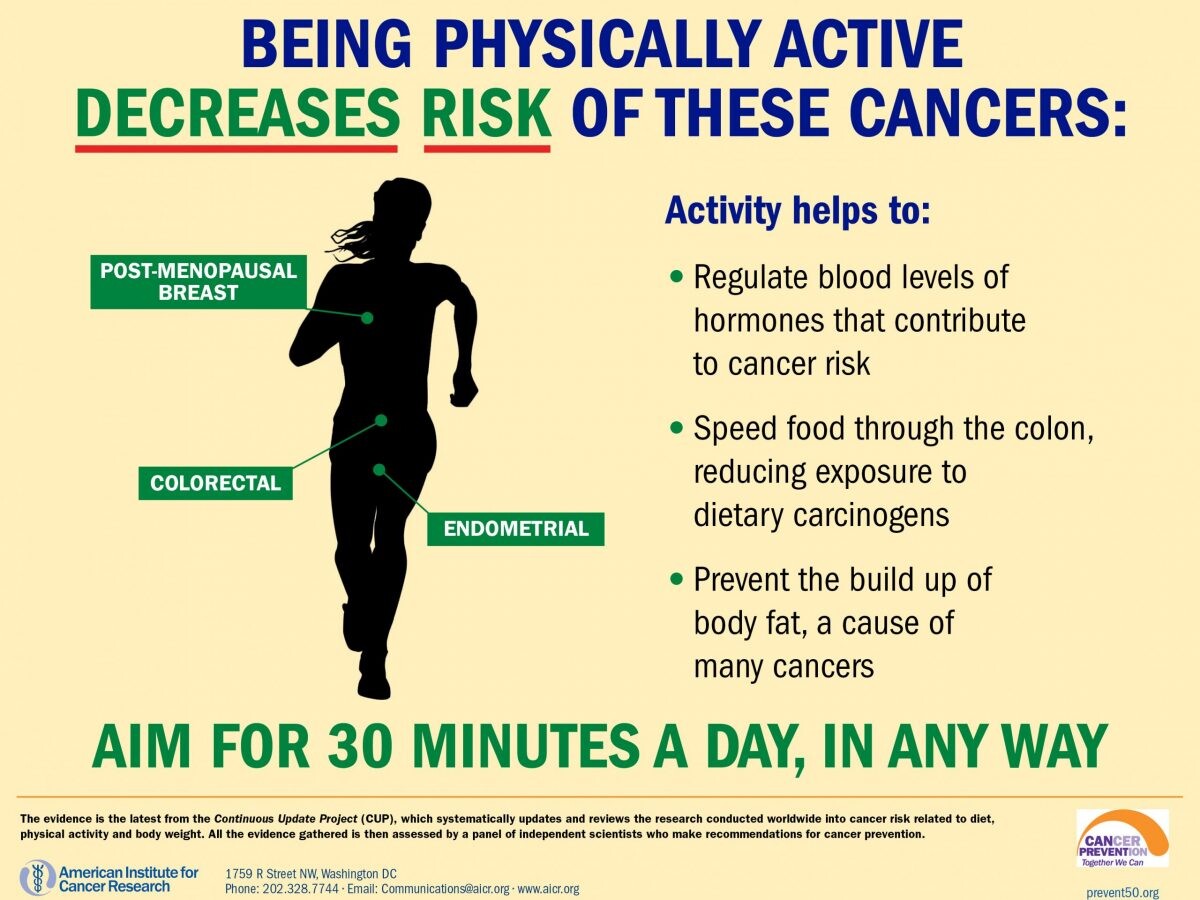
Exercise has been shown to address some causes of cancer, such as obesity and inflammation.
Of course, exercise alone won’t eliminate your risk since there are many factors that go into that equation, including genetics, environmental exposure, smoking and alcohol use, age, diet, and hormones.
When it comes to cancer prevention, lifestyle habits make an enormous difference, and exercise is a major part of that, according to a new study in the journal Medicine & Science in Sports & Exercise.
Researchers looked at state-level data on cancer incidence as well as physical activity by state (in people age 30 or older) and found a strong connection between reduced cancer prevalence and more exercise. That was particularly true for cancers related to the breast, colon, stomach, kidney, bladder, and esophagus.
They noted that more than 46,000 cancer cases in the U.S. annually could be prevented if people followed the guideline of getting at least five hours of moderate-intensity activity per week. For all cancer cases in adults between 2013 and 2016, about 3 percent were attributable to physical inactivity, they suggested. That incidence was higher in women than in men, researchers added.
States with the highest proportion of cancers attributed to sedentary behavior were in the South, such as Kentucky, West Virginia, Tennessee, Louisiana, and Mississippi. Those with the lowest proportion were in Western states like Montana, Utah, and Wyoming.
Of course, exercise alone won’t eliminate your cancer risk since there are many factors that go into that equation, including genetics, environmental exposure, obesity, chronic inflammation, smoking and alcohol use, age, diet, and hormones.
However, exercise has been shown in the past to address some of those factors, such as obesity and inflammation. With the latter, more intense physical activity can actually increase inflammation in the short term, but research indicates it brings the level down overall, and one study noted that as little as 20 minutes of exercise could kick off this effect.
“Continuous inflammation stresses your entire body, including lowering your immune system response, damaging your DNA, and affecting your gut health,” William Li, M.D., author of Eat to Beat Disease: The New Science of How Your Body Can Heal Itself, told Runner’s World. “All of those can contribute toward cancer development, as well as raise your risk of type 2 diabetes and other chronic conditions, especially if it comes with weight gain.”
Building muscle through strength training or endurance exercise—like running—can be helpful for reducing inflammation, Li said, particularly if you adopt a diet rich in anti-inflammatory foods, like fruits and vegetables.
by Runner’s World
Login to leave a comment


